inbox and environment news: Issue 567
January 15 - 21 2023: Issue 567
The Plastic In Our Waters + The Balloons Killing Wildlife: Local Petition Calls On Council & Surf Life Saving Clubs To Implement A Balloon Ban
Petition: Call For Northern Beaches Council & Surf Life Saving Clubs To Implement A Balloon Ban
Warringah Freeway Upgrade: Future Beaches Link Tunnel Environment Destruction Apparent In Cammeray Local Residents/Groups State - Just Two Trees To Be 'Retained'
The Upper House Public Works Committee released its report on the impact of the Western Harbour Tunnel and Beaches Link on Monday December 5th 2022.
Chair of the Committee, the Hon Daniel Mookhey MLC, commented: 'This inquiry examined government plans to build two under-harbour motorways in Sydney—the Western Harbour Tunnel and Beaches Link.
'These are large projects, with large price tags, and significant impact on communities they interact with.
The community responded strongly to the committee’s inquiry, contributing more than 575 submissions, with the vast majority opposed to the projects.'
Mr Mookhey continued, 'The committee identified various issues with the planning and justification of the Western Harbour Tunnel and Beaches Link, including that the government failed to adequately consider public transport options, that procurement processes led to delays and extra costs, and that there was a lack of transparency regarding project planning.
The committee makes various recommendations to improve transparency around the projects, noting the importance of properly informing the public ahead of the March 2023 election.'
'Importantly, the committee recommends the government not proceed with Beaches Link, as there has not been an adequate explanation of what its benefits and costs are for the NSW community.
'The committee also makes several recommendations on the impacts of the Projects on air and water quality, and recommendations on managing the impacts of the Projects on three Sydney regions that would be directly affected by construction and operation—the Inner West, Lower North Shore and Northern Beaches.'
The Chair concluded, 'I note that at the time of writing enabling works for the Western Harbour Tunnel have begun, and that the government has recently announced major changes to the way the Tunnel itself is constructed. I put on record my hope that the recommendations of this inquiry and the contributions of its stakeholders are appropriately considered in any decisions the government makes.'
Information about the inquiry, including the committee's report, is available on the committee's website: www.parliament.nsw.gov.au/committees/inquiries/Pages/inquiry-details.aspx?pk=2767
Northern Beaches Council supported the Project, listing it would address high levels of traffic congestion on Northern Beaches, provide a direct connection to the Sydney motorway network, support growth in the Northern Beaches, ′unlock′ parts of the Council′s Hospital Precinct Structure Plan for Frenchs Forest and support additional growth in Brookvale as its reasons for support.
Council expressed its satisfaction with stakeholder and community engagement around the Projects through to the EIS exhibition.
However, St Cecilia's Catholic School Advisory Committee and Northern Beaches Secondary College Balgowlah Boys Campus Parents & Citizens Association expressed dissatisfaction with consultation and planning processes, noting their schools were omitted in the EIS. Northern Beaches Secondary College Balgowlah Boys Campus Parents & Citizens Association further claimed to be ′ignored during preparation of the EIS′ due to the proposal not being substantially changed in response to their concerns and the school not be contacted during EIS preparation.
Environmental impacts in the Northern Beaches were a common theme for stakeholders. Organisations from our area highlighted impacts of Beaches Link on parks, biodiversity, specific flora and fauna, established trees, and waterways either as reasons to oppose Beaches Link or as impacts that need to be addressed.
There are all concerns persisting around the health impacts of air pollution.
The Inquiry was a result the community lobbied for after a 11,000 strong petition to Parliament was effectively dismissed by the government in 2020.
‘’The community have been asking for transparency and real consultation around these multi-billion dollar toll road investments for some time given their extreme impacts and planning documents which simply don't pass the pub test. Many of the major findings reflect what we identified in planning documents 5 years ago and have been lobbying government members to look into for years.’’ one community group has stated
A public campaign championed by Greens MP Jamie Parker, Member for Balmain, has seen the government change its plan to dredge Sydney Harbour between Birchgrove and Waverton and committed to continue boring underground.
The original plan was to dig up thousands of tonnes of toxic sludge from the bed of Sydney Harbour just off Yurulbin Point in Birchgrove. This contaminated sediment, marine biologists warned, was likely to pollute the harbour and threaten up to 70 marine species including seahorses, sea dragons, dolphins, little penguins and seagrasses.
Residents anticipate the same may occur in Middle Harbour.
The Beaches Link tunnel construction is to include two cofferdams to allow construction of the interface structures where driven tunnels will meet immersed tube tunnels. According to the environmental impact statement for Beaches Link the cofferdams will be ′constructed at each end of the Middle Harbour crossing and within the harbour off the shore at Northbridge to the south and Seaforth to the north′. Middle Harbour will be dredged between the two cofferdams to allow a gravel bed and immersed tube tunnels to be placed in the resulting trench.
NSW Opposition Leader Chris Minns stated in October 2021 a Labor government would scrap plans for the $10 billion Beaches Link toll road tunnel and redirected the money into public transport infrastructure for Western Sydney.
"Parramatta's population is set to increase by 204,000, Camden by 227,000, Liverpool by 229,000 and Blacktown by 264,000 over the next two decades," he said.
"Meanwhile, the northern beaches will grow by just 31,000 and Mosman by just 1,000 people over the same period." he told the annual state conference of the Labor party
On December 1st, 2022 the State Government announced that Sydney’s third harbour crossing had reached a major milestone with the $4.24 billion contract to deliver stage two of the project awarded to ACCIONA.
Premier Dominic Perrottet said the new Western Harbour Tunnel would provide a western bypass of the CBD, taking pressure off other major roads across the city and helping commuters move around more easily.
However the City of Sydney Council, in it's October 2022 Submission to Western Distributor Network Improvements proposal, stated the Transport for NSW Western Distributor road network improvements proposal will have substantial negative impacts on people, place and safety in Pyrmont and Ultimo.
'The impacts will also hinder the NSW Government’s ability to achieve its vision and planning aspirations. The proposal: conflicts with NSW Government policy and planning, will permanently increase traffic in Pyrmont and Ultimo, will negatively impact the safety of people in Pyrmont and Ultimo, requires removal of 71 trees, up to 10% of trees across the study area, will impact local communities and public transport during construction and into the future.
The Western Harbour Tunnel will connect to WestConnex at the Rozelle Interchange, cross underneath Sydney Harbour between Birchgrove and Waverton, and connect with the Warringah Freeway near North Sydney via a 6.5 kilometre tunnel with three lanes in each direction.
Minister for Metropolitan Roads Natalie Ward said the new tunnel would be constructed underground with Tunnel Boring Machines instead of being an Immersed Tube Tunnel.
“We’ve collaborated with industry to come up with the best outcome for the local community and the environment, which involves tunnelling underneath the harbour seabed rather than building a tunnel on top of the seabed,” Mrs Ward said.
“We know our population is growing and this is how we make sure our infrastructure keeps pace, supporting a strong economy and a brighter future for everyone in NSW, not just those who use this tunnel.”
Member for North Shore Felicity Wilson said her community would enjoy significant benefits from the project, which will redirect traffic off rat runs on local streets and see the delivery of more green open space.
“Tunnelling means we no longer need construction sites at Balls Head and Berrys Bay in Waverton,” Ms Wilson said.
“I’m enormously excited to be able to return Berrys Bay to the local community and deliver them 1.9 hectares of beautiful foreshore parkland and public space, even earlier than planned.”
The government states that once complete, the Western Harbour Tunnel will cut traffic by 35 per cent in the Western Distributor, 20 per cent in the Sydney Harbour Tunnel and 17 per cent on the Harbour Bridge.
Construction of stage one is already underway. Further community consultation will take place next year ahead of the commencement of major work on stage two in late 2023.
The timing of the State Government's announcement, when it would have been aware the Inquiry report was due for release, has also caused concern, given that the contract to bring the tunnel into Camera was signed off prior to their assessing and responding to what the Inquiry found.
''This inquiry was one of the best submitted to inquiries in recent history with quality submissions from hundreds of community members and well qualified experts (ie Marine Scientists, Asthma Australia, Dr's etc). All committees are headed by various members of parliament under terms of reference - the governments weak argument that the findings are politically biased simply does not hold water as findings are very well evidenced.
In light of the findings a Halt and Reassessment of the plan for the Western Harbour Tunnel post March 23 is absolutely necessary - the extensive further planning required should not be rushed through given the complexity of this project and extent of it's issues. A new cabinet needs to ensure that this project is done right and that we do not bear any further unnecessary risk.
It is time now to cancel the Beaches Link outright - clearly the Environmental Impact Assessment does not satisfy the terms of the Secretaries Environmental Assessment Requirements (SEARS) and there is no business case or public/active transport consideration. The Beaches Link doesn't just need a few amendments it needs to go back to the drawing board with public transport alternatives at it's heart.
Tearing down thousands of additional trees, digging up contaminated Flat Rock Gully and dredging Middle Harbour is not an option worth considering for an unjustified project which simply delivers more traffic into the Northern Beaches.
By rights the Western Harbour Tunnel should likewise be completely re-assessed and re-designed with a new business case produced independent of the pressure of politically timed contracts. How a project can be deemed to have a positive cost benefit ratio with such a fundamental part of the projects design (the harbour crossing and therefore alignment) is almost impossible to understand. The costs of bringing all construction up from Waverton into North Sydney and the loss of some benefits of the original design will have a considerable impact on the BCR.
Fiscal accountability and public transparency around these projects is extremely limited and a great deal of community time has gone into giving feedback over the difficult Covid years. It's time the government showed the community some good faith and proceeded as they should have 5 years ago - with some objectivity and transparency around the need for these toll roads.'' one of the local residents groups has stated.
Another shared this:
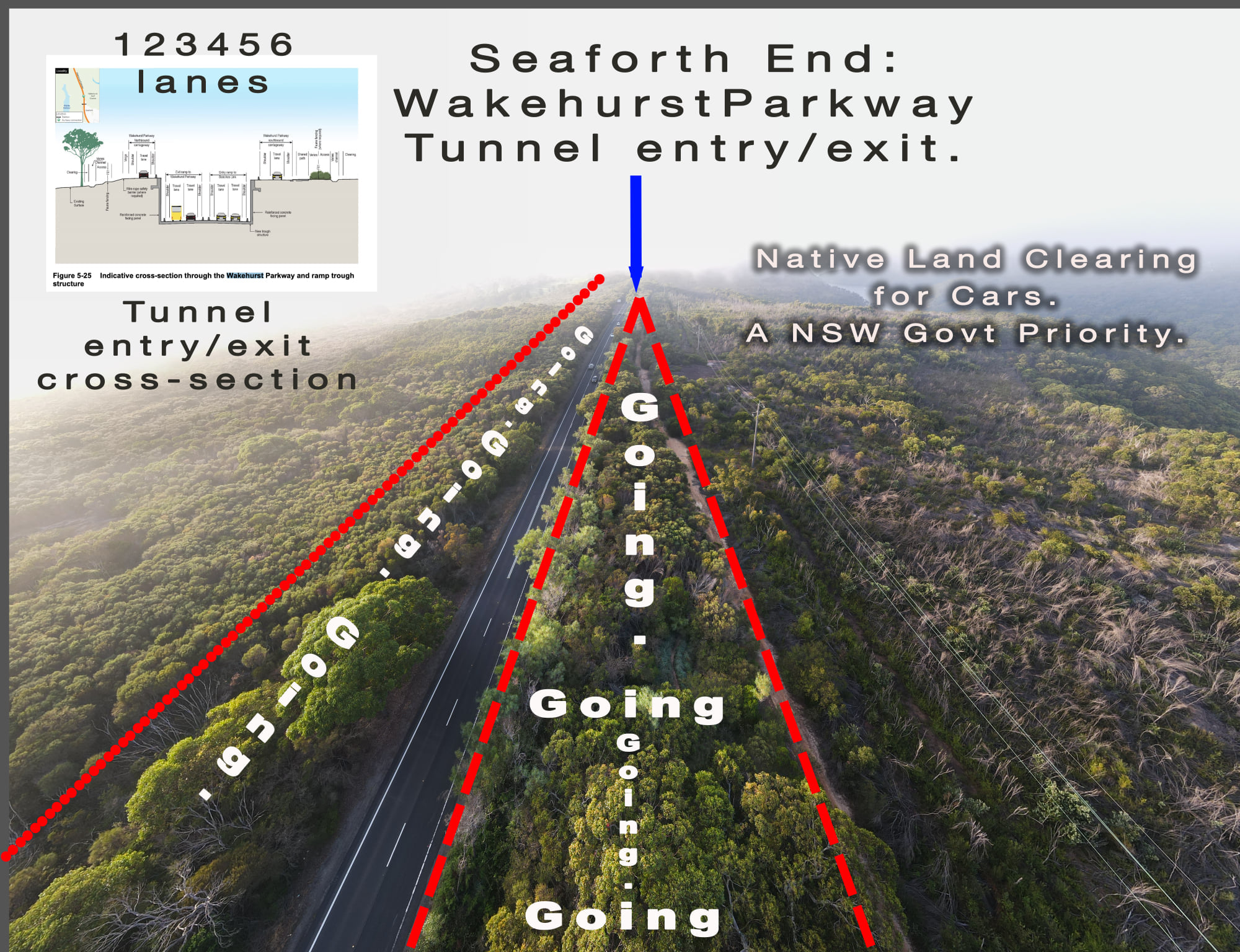
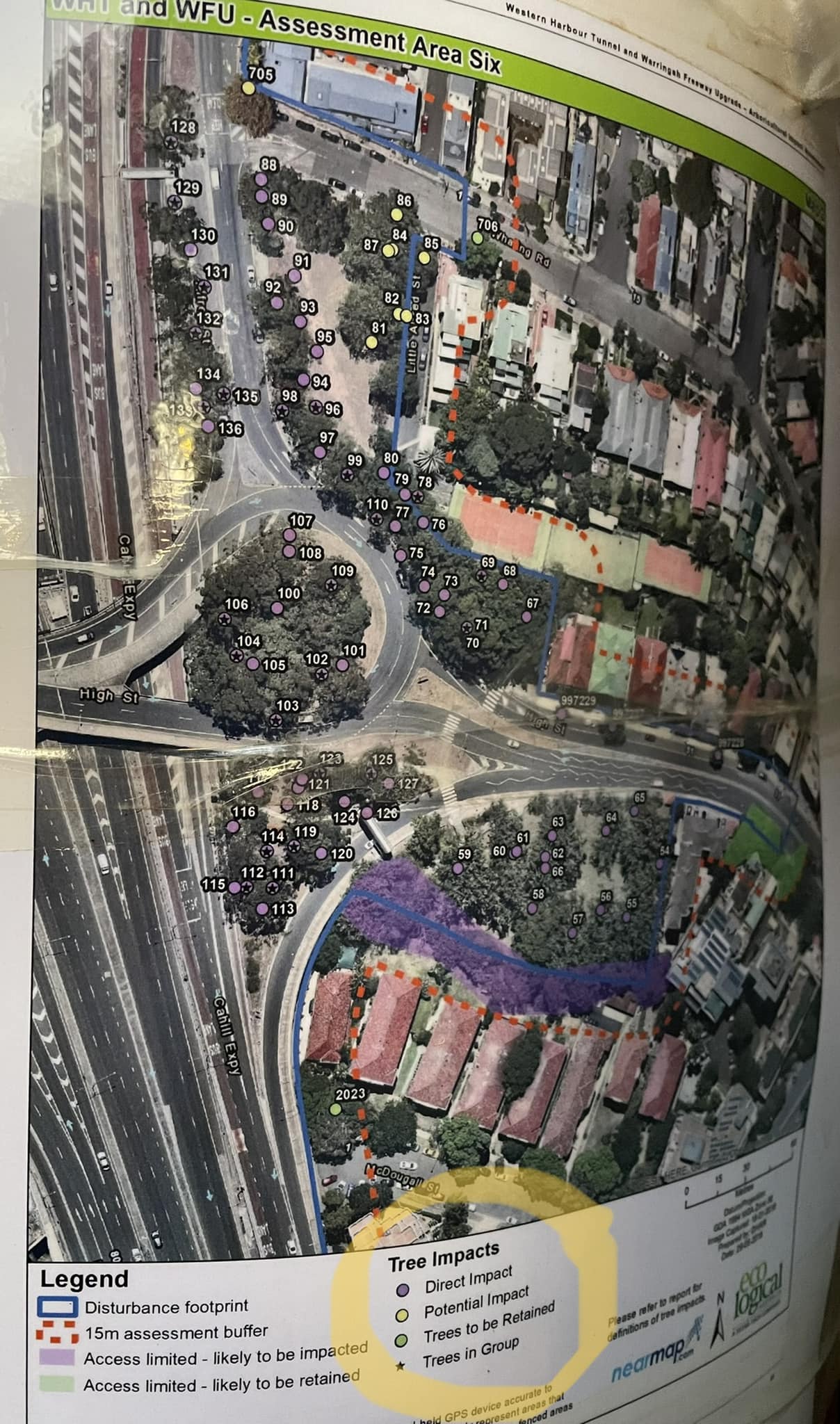
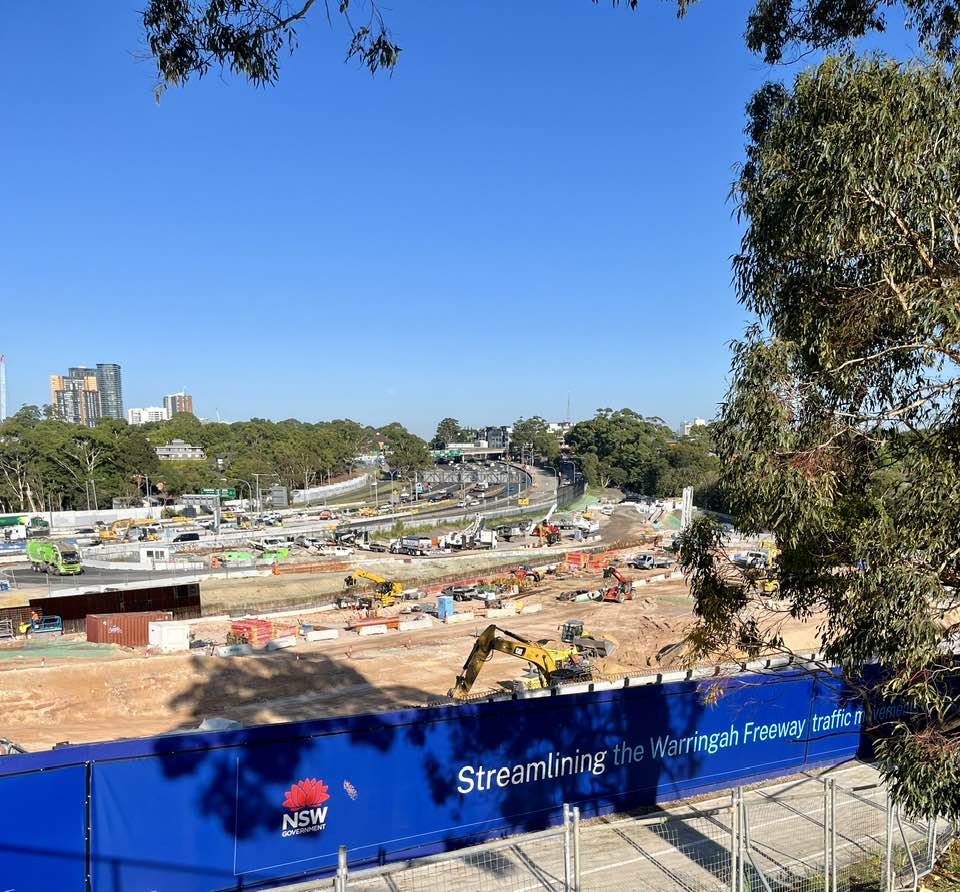
Open Letter To Tim James MP
Western Harbour Tunnel Statement From North Sydney Mayor:
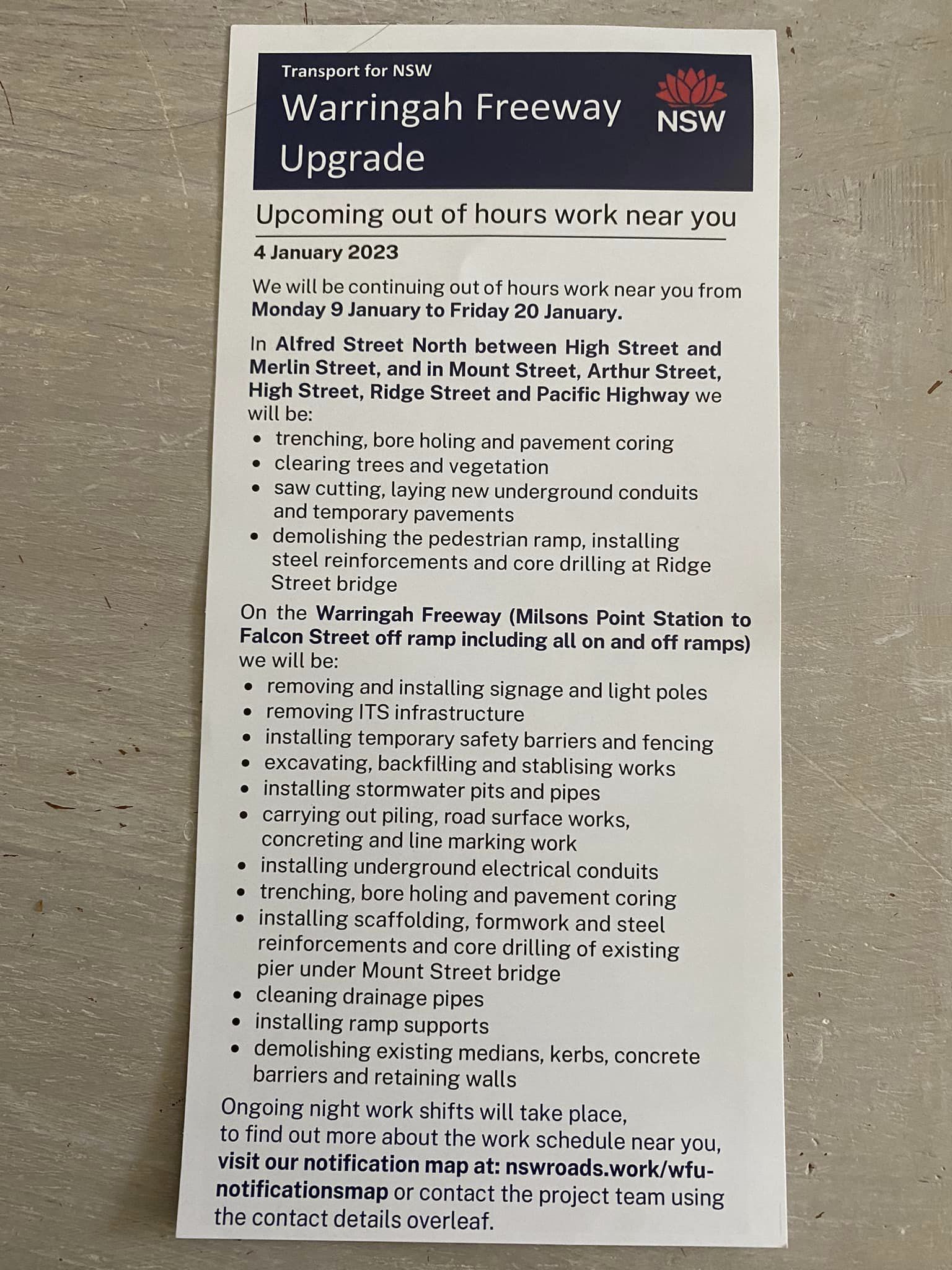

North Sydney Council: When Will The Destruction End?
North Sydney Council:A sad update on this story: three of the ducklings have died. Mama duck remains lost, so the other two ducklings have been re-homed in Lane Cove under the care of another duck.With the significant loss of canopy created by the Western Harbour Tunnel project, it’s more important than ever for us to protect the bushland we have left and our native fauna. The tunnels impact register describes the risk to fauna as ‘low’. They are required to rescue fauna during tree clearing.
Who Owns The Beach?
The Australian Coastal Society (ACS) is proud to present the podcast “Let’s Talk Coast” a short series that brings you conversations on coastal issues and projects from around Australia.
Episode 1 – Who owns the beach?
In our very first episode of “Let’s Talk Coast”, Emeritus Professor Bruce Thom and coastal engineer, Angus Gordon, explore issues around beach management, beach access, private ownership and coastal policy.
Known as the founding father of the Australian Coastal Society, Professor Bruce Thom is Emeritus Professor at the University of Sydney and a member of the Wentworth Group of Concerned Scientists. In 2010, Bruce was awarded a member of the Order of Australia for his services to the environment and advocacy for the ecological management of the coastal zone and as a contributor to a public debate on natural resource policy. Bruce regularly writes blogs for ACS, which can be found here.
Angus Gordon is a coastal engineer and former General Manager of Pittwater Council. Angus has worked on coastal engineering, coastal zone management and planning projects across Australia and the globe, and in 2018 he received an Order of Australia for his services to the environment planning and the community. You can read more about Angus Gordon here.
Both guests bring a wealth of knowledge to the discussion around the question of “Who owns the beach?” and suggest a way forward in protecting Australians right to the beach through national standards.
This podcast is an Australian Coastal Society podcast, produced and hosted by Gretchen Miller.
If you would like further information about this episode, contact us at admin@australiancoastalsociety.org.au
Let’s Talk Coast, was created through the financial support of our donors over the years.
To become a member and find out more about membership benefits, follow this link: https://australiancoastalsociety.org.au/membership-account/acs-membership/
To make a tax-deductible donation and help us continue to be a voice for the coast, follow this link: https://australiancoastalsociety.org.au/get-involved/donate/
This episode was recorded on the lands of the Garigal or Caregal people.
Ringtail Posse 2023: The Generation Witnessing An Extinction Of Urban Wildlife
Australian Shorebird Monitoring Program: Critically Endangered Eastern Curlew Chased Out Of Port Hacking On December 10, 2022 + January 12 2023 - Occurs In Our LGA As Well
The Eastern Curlew is listed as critically endangered in Australia, with global populations estimated to have declined by 80% in the last 30 years. As a wading bird that travels across our earth, they rely on intertidal mudflats for food and habitat.
Australia is a signatory of the East Asian – Australasian Flyway. The East Asia/Australasia Flyway extends from Arctic Russia and North America to the southern limits of Australia and New Zealand. It aims to protect migratory waterbirds, their habitats and the livelihoods of people dependent upon them.
On Saturday December 10, jetskis and people disturbed this group of Eastern curlews at Port Hacking. One of the monitors that works as a volunteer to protect this bird when it visits our shores filmed the following. This bird comes to Careel Bay too - where people are frequently seen taking dogs in a 'no dogs' area for this very reason.
The volunteer tells us ;
''Yesterday the Port Hacking eastern curlews put up with 6 hours of disturbance in order to get an afternoon feed. This morning after 1 hr and 4 disturbances they decided the energy needed to stay was too great, so flew out to Botany Bay. I had asked these 2 charmers if they wouldn’t mind turning around rather than walk to end of beach to avoid disturbing the roosting curlews. They had already walked almost 2 km having left their kayaks at the other end of the Spit, surely they wouldn't mind giving up the last 100m. Rude response and on they walked.''
Pittwater Online News forwarded this to the Office of James Griffin, NSW Environment Minister for a response - Monday, December 12, 2022.
Late on Friday December 16th a Department of Planning and Environment spokesperson replied with the statement so readily found on the OEH webpages, nothing specific about addressing what is occurring to these critically endangered birds at Port Hacking was broached.
The statement reads:
''Remember to keep your distance. If shorebirds take off or run away as you approach, you are too close.
Eastern Curlews fly thousands of kilometres to get here, typically from Russia and north-eastern China
Every unnecessary flight uses energy and potentially affects their ability to fly home.
There is a saying: Birds in sight – don’t make them take flight!
Migratory shorebirds have travelled a long way so it’s really important they are allowed to roost and feed in peace, to build up their fat reserves before they migrate north.
There are four ways you can help protect our shorebirds -
1. Pay attention to signs or fences
2. Leash your dog whenever you’re on the beach, and only walk dogs on designated beaches
3. Stick to the wet sand and leave the birds space
4. Respect beach-closure signs and beach-driving rules. Only drive on designated beaches
BACKGROUND INFORMATION
Within Australia, the Eastern Curlew has a primarily coastal distribution, and in NSW is mainly found in estuaries such as the Hunter River, Port Stephens, Clarence River, Richmond River and the south coast.
The Eastern Curlew breeds in Russia and north-eastern China but its distribution is poorly known. During the non-breeding season a few birds occur in southern Korea and China, but most spend the non-breeding season in north, east and south-east Australia.''
It could have been a very expensive day out for these people had Sutherland Shire Council rangers been there. Once again these critically endangered birds were chased from their feeding and resting area, this time by a dog whose owners deemed themselves a part of that growing pack of humans to whom the law does not apply.
An Australian Shorebird Monitoring volunteer points out for this January 12th 2023 incident they witnessed:
1. Dog in dog prohibited area.
2. Dog off leash in public space that is not a declared off-leash area.
3. Dog rushing at wildlife.
Not shown in this clip:
4. People pointing at birds encouraging dog to “get the birdie”.
The Eastern curlew is listed as critically endangered in Australia, with global populations estimated to have declined by 80% in the last 30 years. As a wading bird that travels across our earth, they rely on intertidal mudflats for food and habitat.
Australia is a signatory of the East Asian – Australasian Flyway. The East Asia/Australasia Flyway extends from Arctic Russia and North America to the southern limits of Australia and New Zealand. It aims to protect migratory waterbirds, their habitats and the livelihoods of people dependent upon them.
These birds are now in a critical phase as they are preparing for the approx. 10 day non-stop flight towards their breeding grounds. Breeding plumage is starting to appear. They are trying to put on weight. This type of behaviour, causing birds to fly, puts their lives at risk. They are using up energy rather than stacking on the weight needed to sustain them during their long flight. They don’t stop along the way to eat. It is only the weight they are carrying that can keep them alive. It’s easy to point fingers at developers or forestry but we also need to consider our own personal behaviour and the impact we are having on wildlife. If we don’t start looking after our wildlife, we are going to lose it.
SECTION 16: COMPANION ANIMALS ACT: DOG ATTACKS
16(1) Dog attacks generally
There is a maximum penalty of $11,000 for owner’s of dogs that rush at, attack, bite, harass or chase an animal (other than vermin) whether or not any injury is caused.
SECTION 17: ENCOURAGING DOG TO ATTACK
17(1) Encouraging a dog to attack generally
There is a maximum penalty of $22,000 for anyone who ‘sets on or urges a dog’ to attack, bite, harass or chase any person or animal (other than vermin).
Section 23(2)(c) gives the Court power to disqualify a guilty person from owning a dog for a specified period of time.
Video: Australian Shorebird Monitoring volunteer, JK
A Failure To Protect Local Wildlife
There is a local context here as well.Careel Bay is a WPA (Wildlife Protected Area) and also part of or one of the places where the Eastern Curlew will land and feed during its Summer sojourn in Pittwater.
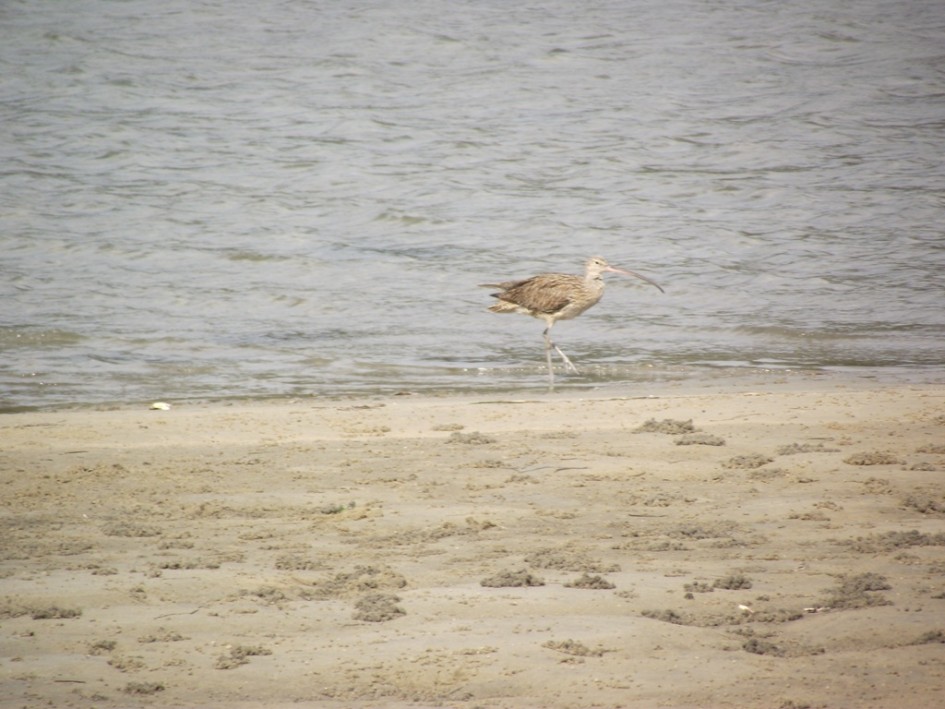
Eastern Curlew at Careel Bay foreshore in October 2011 - A J Guesdon photo
Unfortunately, here too, people report the same people doing the same things and their same pet dogs chasing off the wildlife at the same time - for months in a row - with little or no actions taken - again for months in a row. - and despite these being 'no dogs' areas.
People have witnessed owners setting their dogs on wildlife - in WPA's, in creeks, on playing fields that are not offleash areas.
The belief now is the Northern Beaches Council simply does not have enough rangers tasked with curtailing what has become a growing problem.
Rangers will turn up at a place where this is occurring for an hour after months of reports and then be absent again for months in a row. The 'above the law' followers are back within hours, the same day.
As a consequence our area is losing its wildlife.
As another consequence this Council is not honouring its part of Australia being a signatory of the East Asian – Australasian Flyway.
Not only the critically endangered are impacted. The Pacific Black Duck, which has a traditional songline running through our area, going back thousands of years, is being destroyed under this Council's watch by dog attacks on ducklings - on babies - every Spring and every Summer.
These birds are bringing their young along the 'old ways' - the playing fields or drains where creeks once ran - and meet, once again, dogs offleash where they are banned and the same people doing the same thing at the same time - for months on end, unchallenged, or if challenged, threatening physical violence or online and physical stalking and threats of violence.
''People just want these public spaces back.'' the parents of children who have been chased in these areas state.
''We are distressed by the amount of wildlife we are rescuing after a dog has attacked. Many of these we are unable to save.'' wildlife rescuers state. ''There has been so much lately, so many 'rescues'.''
''We did not have this problem under Pittwater Council.'' another states ''They knew where people were doing the wrong thing and made daily patrols to look after residents and wildlife. They made sure they had enough people doing this work. The problem has occurred under the council which was imposed on us and which makes the right noises, those the dog lobbyists like.''
The Ringtail Posse
The critically endangered Eastern Curlew being chased by dogs, along with the thousands of residents who have contacted Pittwater Online News about dogs offleash where they are not meant to be has led to what will be one of the 'subject' series this Community News Service will run in 2023.
This has been named the 'Ringtail Posse' as what is called the 'Common Ringtail Possum' is not so common in this LGA anymore, and a core group of volunteers are collating data, penning insights, saving wildlife, taking photographs, investigating local, state and federal laws and much more.
Residents state that we are, alike those still alive who witnessed the extinction of local koalas, the people witnessing the extinctions of all our urban wildlife.
There has been generation after generation of humans living alongside and with wildlife, until this one.
There is a growing silence at night for those species that forage for food then - owls, wallabies, bandicoots. The same is occurring for those that are active during daylight.
The impacts are not just dog attacks due to irresponsible owners. There is what is termed the 'inconvenient possum' in a roof or garden shed, because its home tree has been cut down. These are caught by those hired, some of whom have little knowledge or scruples, and release them into areas out of their home range - a death sentence for that possum as this species is territorial, along with requiring certain food trees in order to eat, to survive.
There is predation by other introduced species - readers regularly send in photos and videos of foxes or cats roaming and killing at night.
There are roadkill black spots, places where wallabies or turtles or possums used to cross the area where a road has been cut through and a speed limit that means death for wildlife. There are no 'speed humps' in place, and no plan at a local, state or federal government level to do so. Residents and wildlife rescuers have reported some drivers 'aiming straight for' a stricken animal.
There is the razing of blocks of land for development prior to any required assessment of the environment taking place to circumvent those requirements so a report can state 'nothing present'. There is nothing present because its habitat has been cleared or the wildlife killed by these actions.
At the 2021 LGNSW a Motion to address the same was passed - but has not, as yet, been ratified at NSW State Government level. In fact, the incumbent government is still passing approvals to raze Listed critically endangered woodlands and species - such as Sydney's Koalas.
An overview of that long overdue structure is available in the October 2022 report:
Coupled with those who will illegally or legally kill trees that 'block their view' this generation is witnessing local extinctions, and a possibly permanent silence.
Our area already has thousands of local wildlife impacted annually and that number has risen from around 4000 each year to over 5000.
Data to 30 June 2021 lists of the 5, 235 animals rescued during that 2020 to 2021 period just 1,573 were released. There have been thousands more rescued since then, the bulk of which are not re-released.
As a result of those thousands of resident voices Pittwater Online News is finalising that series of Reports/Profiles that will run. At present we would like to hear from anyone who knows they have bandicoots still living in or visiting their yard.
Please email us if you do, we would like to hear from and talk to you - pittwateronlinenews@bigpond.com - Thank you very much in advance.
There's some background on our local bandicoots, also now seldom heard, in Bandicoots: Friends Or Foes? - a 2016 report by one of our local wildlife rescuers and carers.
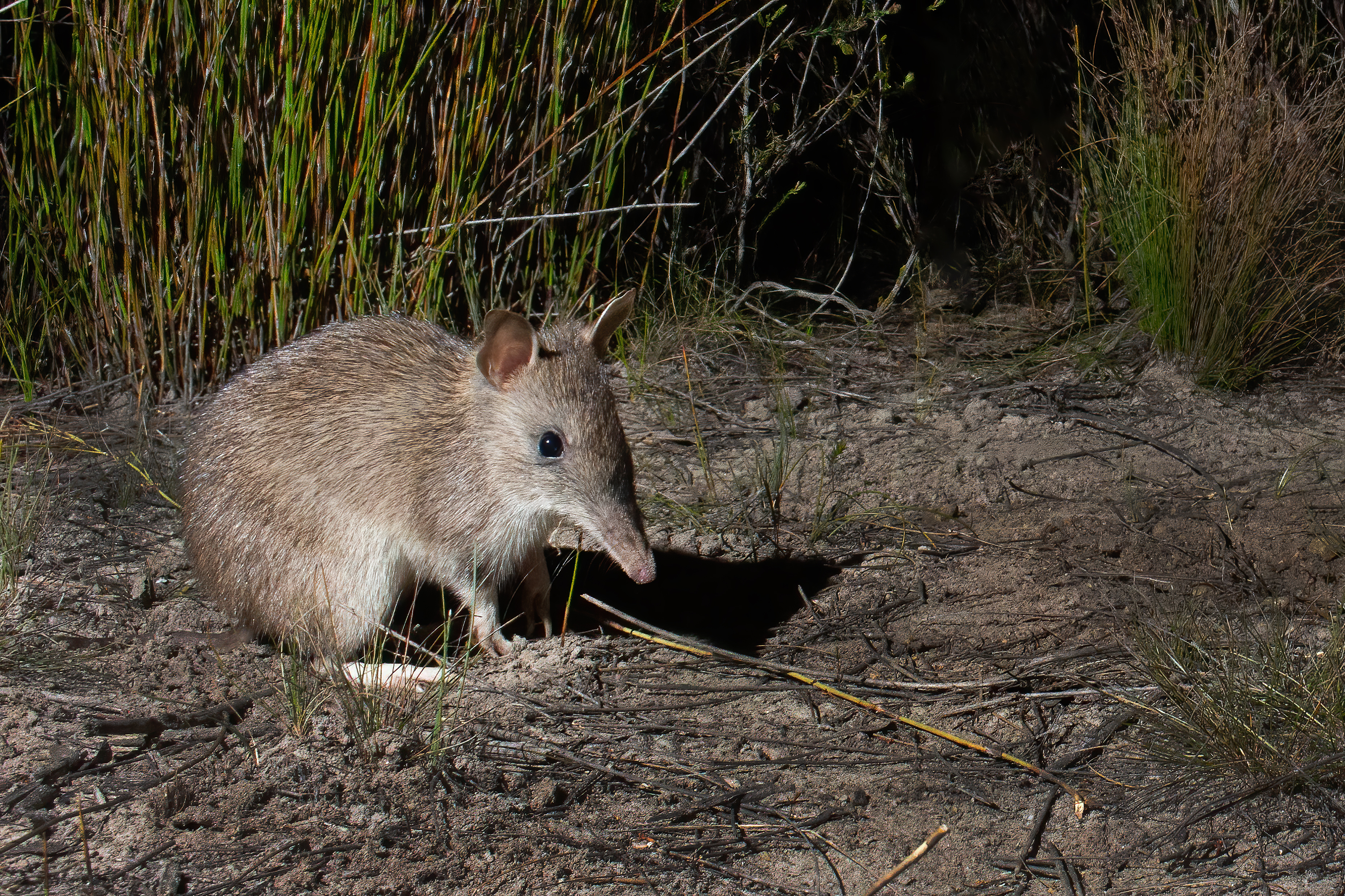
Long-nosed Bandicoot, Northern Beaches, New South Wales. Photo: J J Harrison.
Prune Viburnum Hedge Agapanthus Flowers To Prevent Spread Into Bush Reserves
PNHA: January 11, 2023
Now is the time to prune the berries off the Viburnum hedge and dehead those old Agapanthus flowers. Put these prunings into your green waste bin. Both are now weeds of bushland as their seeds travel.
Photos: Pittwater Natural Heritage Association (PNHA)
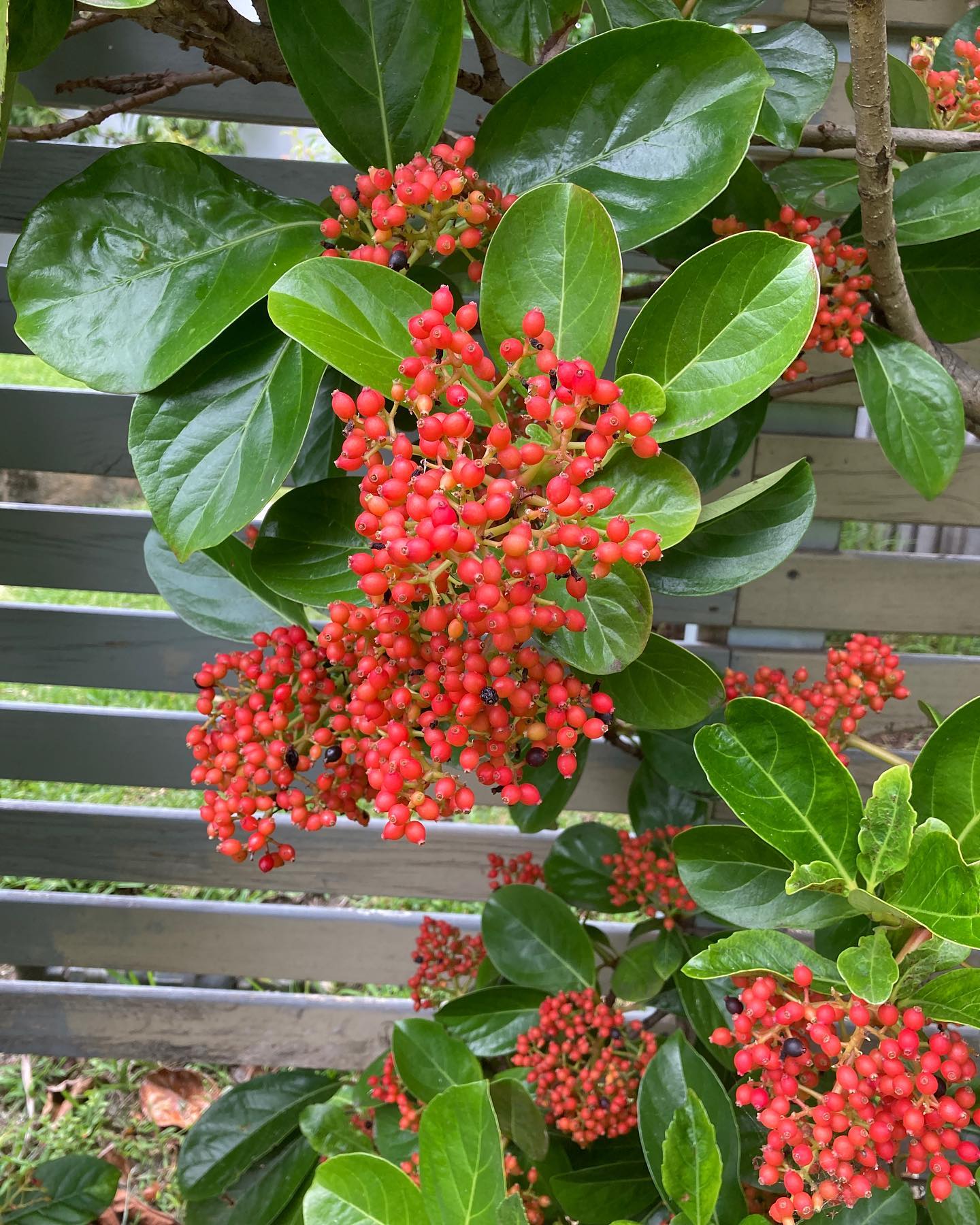
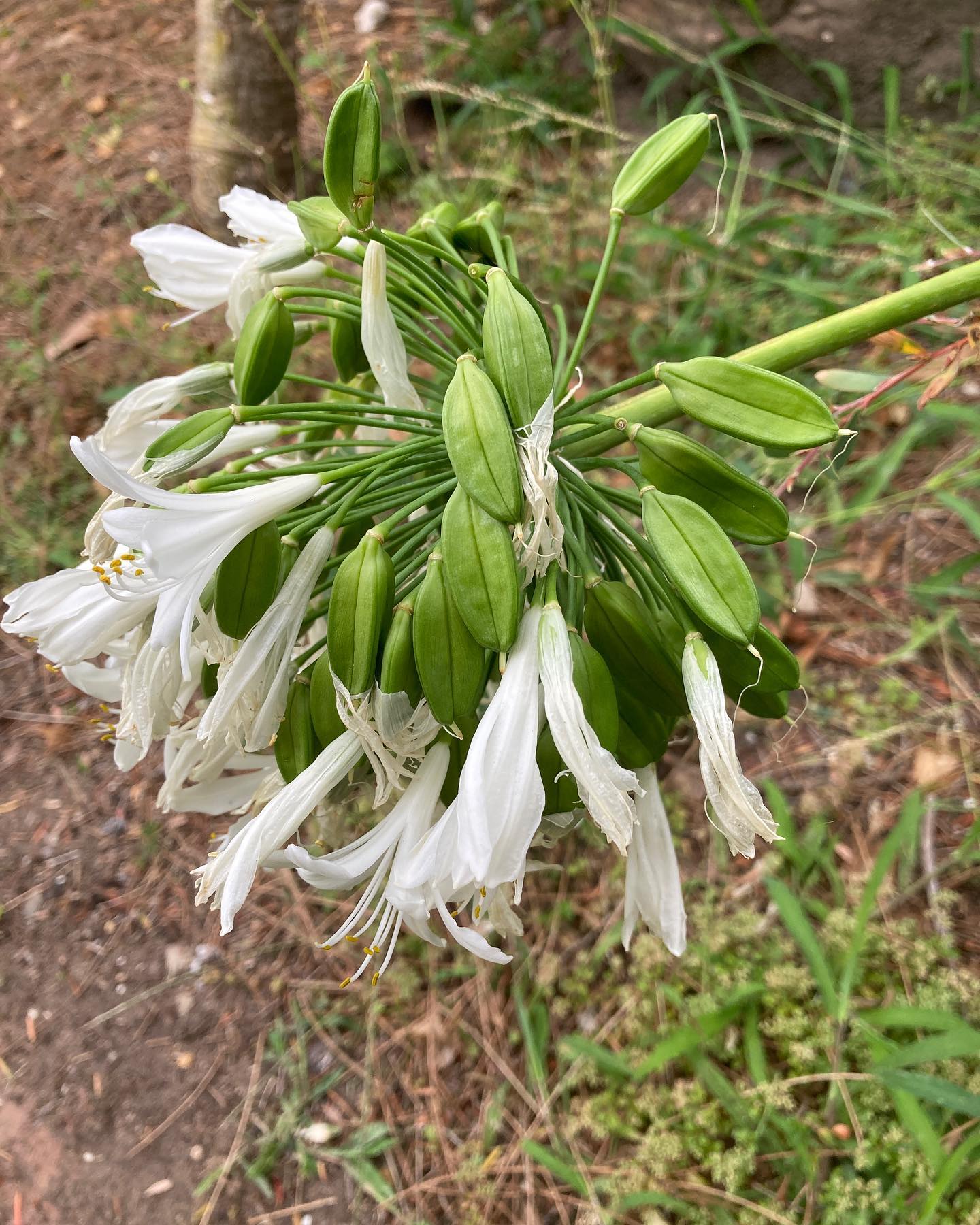
Sydney Wildlife (Sydney Metropolitan Wildlife Services): Rescue Care Course - February 2023
Our next course starts on the 4th of February. It runs for 3 weeks in a self-paced format online and then a 1 day practical session at the end on the 26th February. Both sessions must be passed to join Sydney Wildlife Rescue and rescue and care for our native wildlife.
Visit the sign on page for full details: https://smws.wildapricot.org/RCC-Trainee-Application-Form
The cost of the course is $120 and you will receive membership, manuals and equipment to help you. All new members are fully supported with a mentor when they join. Join us and make a difference to the wildlife in your area.

Summer Visitors: Scaly-Breasted Lorikeet Pair
The Scaly-breasted lorikeet, Trichoglossus chlorolepidotus, was first described by German zoologist Heinrich Kuhl in 1820. Other names this bird is known by include the gold and green lorikeet, greenie, green lorikeet, green and yellow lorikeet, and green leaf. It is often colloquially referred to as a "scaly''. Their specific epithet is derived from the Ancient Greek root khlōros 'green, yellow', and lepidōtos 'scaly'. Sexes appear the same, with green upper-wings and body, marked with yellow 'scales' on the breast and neck. In flight, Scaly-breasted Lorikeets have two-tone, red-orange underwings with grey trailing edges. They are much shorter-tailed than Rainbow Lorikeet. Their call is similar to Rainbow Lorikeet, but smoother and less squawky.
Scaly-breasted Lorikeets feed in flocks, sometimes joining flocks of Rainbow Lorikeets. They feed on nectar and pollen that they harvest with their brush-tongues, mostly from eucalypts, but also from shrubs such as melaleucas, callistemons and banksias.
Scaly-breasted Lorikeet females lay their eggs on a bed of decayed wood in a hollow limb, or where a branch has broken from the trunk of a eucalypt tree, at a height of between 3 m and 25 m above the ground. Both the male and female modify the nest hollow by chewing off pieces of wood, and this can take six weeks. Only the female incubates the eggs, but the male feeds her on the nest. Both sexes feed the young.
Information: BirdLife Australia. Photos: A J Guesdon/Pittwater Online News, taken PON yard 7.15am January 11, 2023
New Marine Wildlife Group Launched On The Central Coast
A new wildlife group was launched on the Central Coast on Saturday, December 10.
Marine Wildlife Rescue Central Coast (MWRCC) had its official launch at The Entrance Boat Shed at 10am.
The group comprises current and former members of ASTR, ORRCA, Sea Shepherd, Greenpeace, WIRES and Wildlife ARC, as well as vets, academics, and people from all walks of life.
Well known marine wildlife advocate and activist Cathy Gilmore is spearheading the organisation.
“We believe that it is time the Central Coast looked after its own marine wildlife, and not be under the control or directed by groups that aren’t based locally,” Gilmore said.
“We have the local knowledge and are set up to respond and help injured animals more quickly.
“This also means that donations and money fundraised will go directly into helping our local marine creatures, and not get tied up elsewhere in the state.”
The organisation plans to have rehabilitation facilities and rescue kits placed in strategic locations around the region.
MWRCC will also be in touch with Indigenous groups to learn the traditional importance of the local marine environment and its inhabitants.
“We want to work with these groups and share knowledge between us,” Gilmore said.
“This is an opportunity to help save and protect our local marine wildlife, so if you have passion and commitment, then you are more than welcome to join us.”
Marine Wildlife Rescue Central Coast has a Facebook page where you may contact members. Visit: https://www.facebook.com/profile.php?id=100076317431064
- Ph: 0478 439 965
- Email: marinewildlifecc@gmail.com
- Instagram: marinewildliferescuecc

Watch Out - Shorebirds About
.JPG.opt1460x973o0,0s1460x973.jpg?timestamp=1663629195339)
Possums In Your Roof?: Do The Right Thing

Aviaries + Possum Release Sites Needed

Bushcare In Pittwater
Where we work Which day What time
Avalon
Angophora Reserve 3rd Sunday 8:30 - 11:30am
Avalon Dunes 1st Sunday 8:30 - 11:30am
Avalon Golf Course 2nd Wednesday 3 - 5:30pm
Careel Creek 4th Saturday 8:30 - 11:30am
Toongari Reserve 3rd Saturday 9 - 12noon (8 - 11am in summer)
Bangalley Headland 2nd Sunday 9 to 12noon
Bayview
Winnererremy Bay 4th Sunday 9 to 12noon
Bilgola
North Bilgola Beach 3rd Monday 9 - 12noon
Algona Reserve 1st Saturday 9 - 12noon
Plateau Park 1st Friday 8:30 - 11:30am
Church Point
Browns Bay Reserve 1st Tuesday 9 - 12noon
McCarrs Creek Reserve Contact Bushcare Officer To be confirmed
Clareville
Old Wharf Reserve 3rd Saturday 8 - 11am
Elanora
Kundibah Reserve 4th Sunday 8:30 - 11:30am
Mona Vale
Mona Vale Beach Basin 1st Saturday 8 - 11am
Mona Vale Dunes 2nd Saturday +3rd Thursday 8:30 - 11:30am
Newport
Bungan Beach 4th Sunday 9 - 12noon
Crescent Reserve 3rd Sunday 9 - 12noon
North Newport Beach 4th Saturday 8:30 - 11:30am
Porter Reserve 2nd Saturday 8 - 11am
North Narrabeen
Irrawong Reserve 2nd Saturday 2 - 5pm
Palm Beach
North Palm Beach Dunes 3rd Saturday 9 - 12noon
Scotland Island
Catherine Park 2nd Sunday 10 - 12:30pm
Elizabeth Park 1st Saturday 9 - 12noon
Pathilda Reserve 3rd Saturday 9 - 12noon
Warriewood
Warriewood Wetlands 1st Sunday 8:30 - 11:30am
Whale Beach
Norma Park 1st Friday 9 - 12noon
Western Foreshores
Coopers Point, Elvina Bay 2nd Sunday 10 - 1pm
Rocky Point, Elvina Bay 1st Monday 9 - 12noon
Friends Of Narrabeen Lagoon Catchment Activities

Gardens And Environment Groups And Organisations In Pittwater
Updated Report On Koala Response To Timber Harvesting Released By NSW Government's Natural Resources Commission: States Logging Does Not Impact Koala Density
On December 22nd 2022 the NSW Government's Natural Resources Commission released the final updated report on koala response to harvesting in NSW north coast state forests. This report includes new findings from recently completed DNA diet analysis for koalas and additional advice on implications for management and recommendations.
The authors of The 'Koala response to harvesting in NSW north coast state forests' - Final report (updated) December 2022, state the overall research findings and their substantive advice outlined in the previous version of the report (2021) have not changed.
''The research found selective harvesting did not adversely impact koala density, nor the nutritional quality of koala habitat. This suggests the koala protections and wider landscape protections codified the Coastal Integrated Forestry Operations Approval (Coastal IFOA) are effectively mitigating the risks from selective harvesting to date at the research sites.'' their statement reads
Research insights included that koala density was higher than anticipated in the surveyed forests and, as noted above was not reduced by selective harvesting according to the authors
the report states koala density was mostly similar between state forest and national park sites, selective harvesting at the treatment sites did not significantly change canopy tree species composition and, therefore, is not expected to impact on nutritional quality of koala habitat, and tree species composition is the key determinant of habitat nutritional quality for koalas
Tallowwood (Eucalyptus microcorys) and small-fruited grey gum (E. propinqua) were confirmed to be important diet species, in alignment with the Coastal IFOA koala browse tree list
Spotted gum (Corymbia maculata) and ironbarks (E. paniculata, E. siderophloia), while not included on the Coastal IFOA browse tree list were browsed by koalas to a considerable extent.
The report recommends opportunities to improve outcomes for koalas, including reviewing koala browse trees listed under the Coastal IFOA.
The 2021 version was met with scorn by the North East Forest Alliance (NEFA) which stated that the assertion by the Natural Resources Commission (NRC) report that logging of koala feed trees doesn’t have any impact on koalas is ‘dangerous propaganda’.
‘It further threatens their survival by denying koalas the increased protection they urgently need,’ said NEFA said spokesperson Dailan Pugh.
NEFA explained that the use of koala recordings that indicate the presence of a koala somewhere in the vicinity is not appropriate for detecting the impact of logging on koalas. They said they do not accept the NRC claim from DPI Forestry’s fundamentally flawed study that ‘the Coastal IFOA conditions and protocols did not adversely impact koala density’.
‘This is contrary to the EPA’s 2016 study that found “areas of higher activity positively correlated with greater abundance and diversity of local koala feed trees, trees and forest structure of a more mature size class, and areas of least disturbance”,’ said Mr Pugh.
‘The NRC’s pretence that the Forestry Corporation can log the large trees that koala’s are preferentially feeding on and have no impact on koalas maintains a dangerous fallacy. That fallacy is one of the reasons why koala populations on the north coast had declined by 50 per cent in the 20 years before the 2019/20 fires.’'
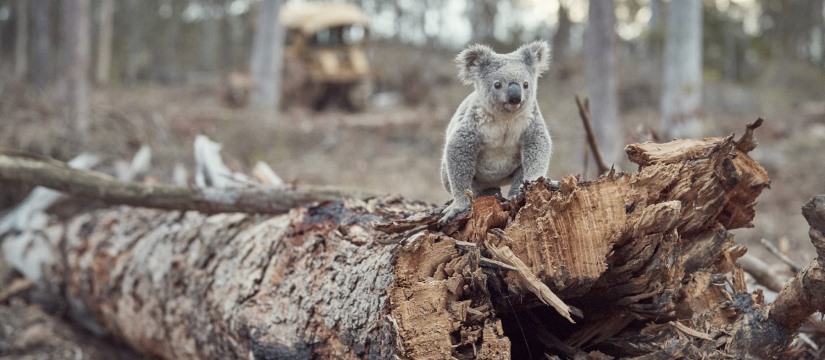
The significant impact on koalas of the 2019/20 fires was confirmed by the NRC, however, Mr Pugh said the NRC failed to propose anything ‘to mitigate impacts’ of logging on those areas.
‘It is particularly concerning that the NRC has not reconsidered its decision in 2016 to over-ride the advice of the EPA and the government’s Expert Fauna Panel that minimum retentions of koala feed trees should be 15–25 feed trees/ha greater than 25cm diameter at breast height (DBH) in modelled habitat.
‘The NRC intervention to reduce the retentions to 5–10 feed trees/ha and sizes to 20cm DBH is not supported by this study.
‘Strangely the NRC have not released results from this study on koala preferences for tree sizes, instead stating their results are “consistent with previous studies at sites in northern NSW and the Sydney region that found koalas use trees ranging from 30 to 80 centimetres DBH”. This is far greater than 20cm trees.
‘This study reaffirms that koalas chose certain tree species for food, and then individual trees with relatively low amounts of toxic compounds, emphasising the need to retain all individuals of preferred feed species rather than the arbitrary 5–10 feed species per hectare specified by NRC (2016).
‘The study also identifies that koalas use Flooded Gum as a feed tree and Turpentine as a roost tree, yet the NRC makes no attempt to add these to the species requiring retention for Koalas.
‘The NRC were meant to review the adequacy of the existing logging prescriptions, but instead have relied upon a fundamentally flawed assessment by DPI Forestry to claim that logging has no impact on Koalas to justify not reviewing the clearly inadequate logging rules. Even though NRC admitted the impacts of the fires it similarly failed to recommend any changes to account for them. The NRC have failed koalas in their time of greatest need,’ Mr Pugh said.
In its 2022 updated version the Commission recommends that the Committee should review the Coastal IFOA koala browse tree list, with support from experts for the upper and lower north-east subregion, to ensure that the highest value browse species are retained and to advise on whether to list ironbarks (particularly E. paniculata and possibly E. siderophloia), flooded gum (E. grandis) and spotted gum (C. maculata) as secondary browse species and elevate small-fruited grey gum (E. propinqua) from a secondary to primary browse species.
Further, the Committee should analyse the potential impacts to wood supply and other environmental risks of such adjustments to the Coastal IFOA koala browse tree list.
Current regulations to retain clumps of habitat that provide a mix of species and tree size classes for both food and shelter throughout the landscape should be maintained, taking habitat connectivity into consideration.
After consideration by the Committee, the Commission will advise the Chief Executive Officer of the NSW Environmental Protection Authority and the Director General of NSW Department of Primary Industries to inform the NSW Government’s five yearly review of the Coastal IFOA.
The Commission also recommends that the EPA and DPI request the Coastal IFOA monitoring program undertake further analysis of nutritional value and contribution to koala diet of New England blackbutt (E. andrewsii) and other potentially low-use koala species (including: narrow-leaved peppermint, E. radiata; ribbon gum, E. nobilis and E. viminalis; messmate stringybark, E. obliqua; snow gum, E. pauciflora; mountain gum, E. dalrympleana; New England blackbutt, E. campanulata) with the view of improving the Coastal IFOA koala browse tree list.
The 2022 updated report is available to download at: https://www.nrc.nsw.gov.au/koala-research
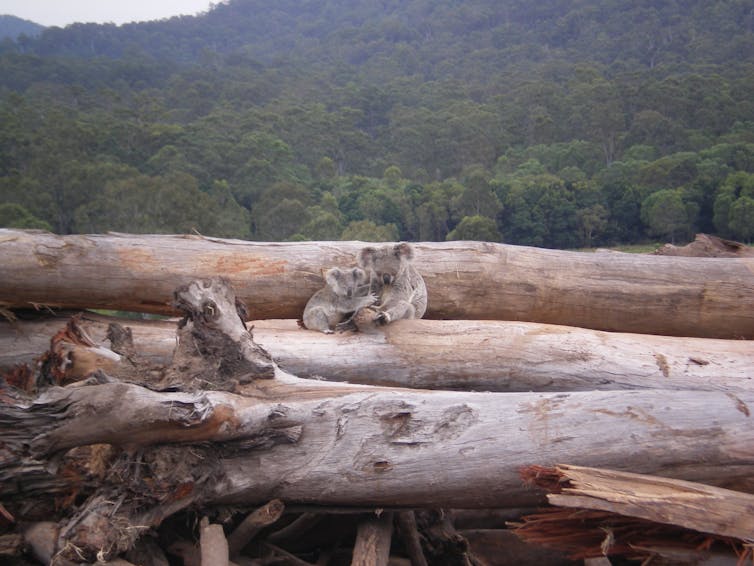
Photo: WWF
NEFA Campaigner Susie Russell Arrested At Save Bulga Forest Protest: Protest Spreads To Lorne Forest As Well
In related koala and NSW Forestry Corporation news, long-time forest campaigner and North East Forest Alliance (NEFA) spokesperson, Susie Russell, was arrested on Monday January 9th at Bulga State Forest, and given bail conditions prohibiting her from entering into any part of the Bulga Forest.
The arrest came as the Save Bulga Forest community ramped up their campaign of civil disobedience calling for an end to logging native forests and in particular the Bulga Forest.
“It was clear I was singled out for arrest”, Ms Russell said. “There were about 30 people on site supporting the young tripod-sitter. I was there, but diligently keeping outside the boundary of the closed area, which was tricky because the distance that was closed was not specified in the closure notice, so I erred on the side of caution.
“Police arrived on the scene just after 7am and spent half and hour walking around talking to different participants. They then went back to their vehicles for a huddle, presumably discussing how they were going to approach the situation. During that time the forest protectors were milling around and chatting in small groups.
“I left the area near my vehicle and walked the 30 odd meters to make sure the tripod-sitter was ok. When I got there, there was a child hugging an adult size koala. I took a couple of photos and then walked back around to my vehicle. The whole exercise took about 5 minutes.
“Almost immediately afterwards the police inspector approached me by name and said I was under arrest for entering a prohibited area. This while there were plenty of people making merry in the “prohibited” area and several colleagues in a similar situation to mine, freely moved backwards and forwards to chat.
“I have no doubt I was arrested in order to try and limit my involvement in the campaign. It has however, made my resolve stronger.
“I have watched the forests of my region being steadily degraded over three decades. In the 1990’s a spotlighting trip through these forests would reveal dozens of Greater Gliders. Now we are lucky to see one. There is nothing ecologically sustainable about this logging. It is smash and grab and runs at a loss. These forests will take centuries to recover.
“I feel I owe it to young people and to those lives without voice, to not stand by in silence while the destruction continues. I will continue to speak for the trees,” Ms Russell said.
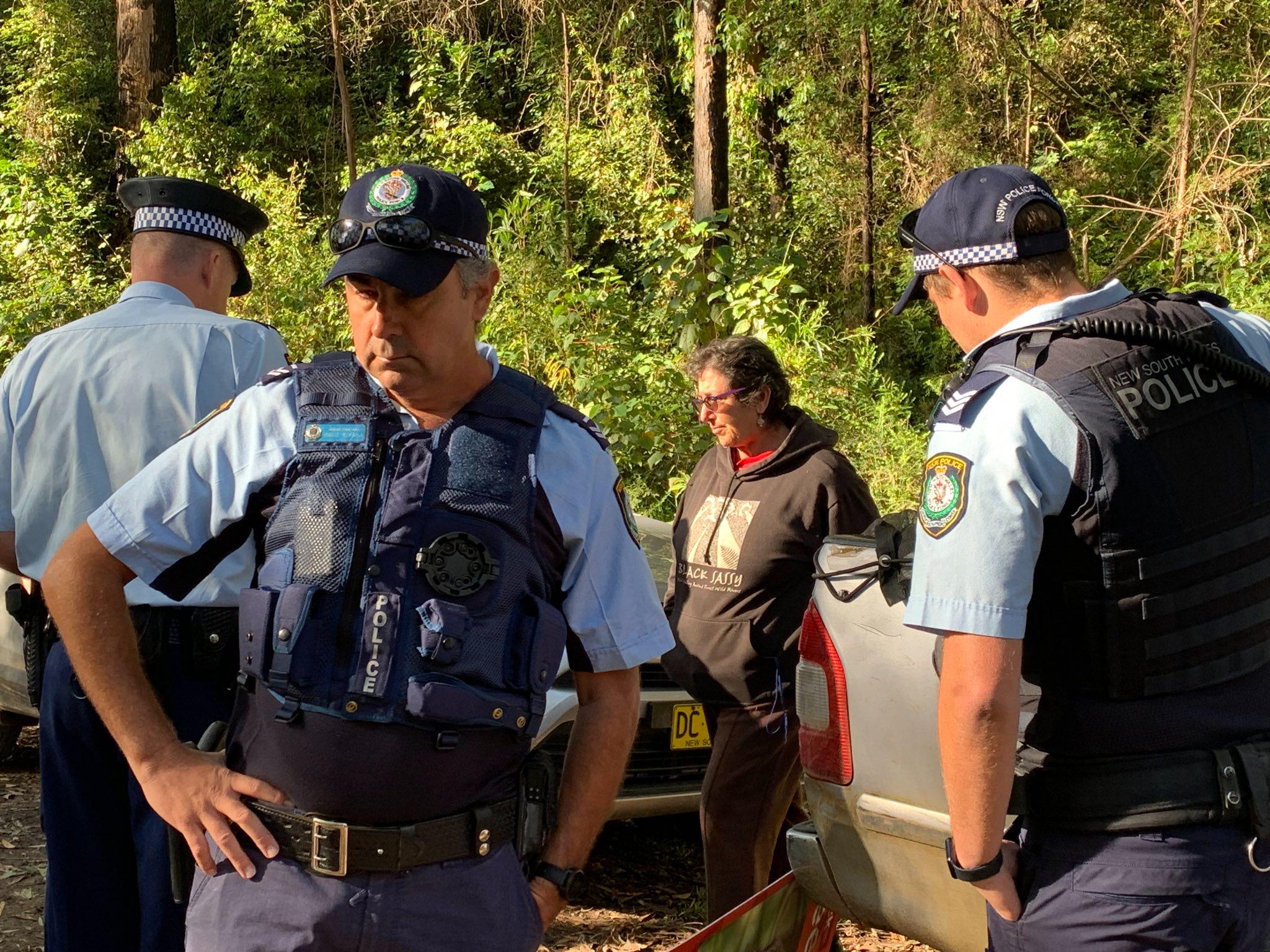
Susie Russell at Bulga Forest. Image supplied.
The Bulga Forest is found between the Biriwal Bulga National Park, Tapin tops National Park and The Cottan-Bimbang National Park.
The Save Bulga Forest group states that logging forests where surviving koalas are seeking refuge, forests that didn’t burn as fast and hot as the surrounding area, makes absolutely no sense.
On Thursday January 12th the members released the following:
Forest Action Spreads To Lorne Forest
Media Release January 12, 2022
At 5am this morning, access to the logging machines that have been actively munching their way through Lorne State Forest, on the mid north coast, was blocked by a forest protector on a tree platform suspended over the road.
Barry, a Lorne local, doesn’t want to give his surname, but his neighbour, Jane McIntyre, was the spokesperson for the action. She said there was a growing concern among Lorne locals about the destruction happening in the forests, and that she could no longer stand by and see their local forest and water catchment security, heading down the road on trucks.
Jane McIntyre has lived in Lorne for 14 years. She has lived adjacent to state forests since 1980, and has witnessed the escalating industrialisation of the logging industry, and the simultaneous degradation of the forests to young regrowth without habitat trees to support wildlife.
Now retired, Jane has worked as a science educator and community development coordinator. This grandmother of 3 small children fears that they will grow up in a world without healthy forests that shelter wildlife such as quolls, gliders and koalas.
She is determined to do all she can to prevent that. “Yes, of course we need wood “, she says, “but instead of clearfelling our remaining native forests, we should be leaving them alone and growing genuine plantation on marginal farmland. These forests have been hit by unprecedented droughts, fires and floods- and now the survivors are being intensively logged. Trees are the best known way of drawing down carbon in our climate emergency. Even the NSW Government’s own Natural Resources Commission states that native forest logging is uneconomical and unsustainable. It’s time to stop now, before we lose more species.”
“Inspired by the action of the Elands community standing up for the Bulga Forest, we reached out for some assistance to enable us to do the same, and make a public statement that we will no longer stand idly by and watch the daily destruction.
“We know that a majority of people in NSW, think that the ongoing logging of our publicly owned forests is sheer madness. The time is now. It has to stop".
Background
On February 21st 2018 the NSW Dept. of Primary Industries announced the NSW Regional Forest Agreement (RFA) were undergoing a review and renewal process, which included an opportunity to update and improve the content to capture emerging issues.
NSW Department of Primary Industries (DPI) Group Director, Forestry, Nick Milham, said then stakeholder feedback is imperative at this stage and views will help shape the renewed agreements.
“The consultation is a genuine chance to influence what form the NSW RFAs take for the sustainable management of our native forests for decades to come,” he said.
Mr Milham said they and the then coalition federal governments had conducted in-person stakeholder meetings and public drop in sessions in Lismore, Coffs Harbour, Bulahdelah, Eden, Batemans Bay, Tumut and Sydney throughout February.
“In the sessions, we have heard from many environmental groups, industry members, local governments, the community and recreational forest users – providing a great insight into the key priorities and opinions of each group,” he said.
“Feedback, questions, criticisms and endorsements have been welcomed throughout the sessions and it has been great to hear the community’s views first-hand.
“The NSW Government has the difficult role of balancing the economic, social and environmental demands on forests, but there is sound logic, underpinned by peer-reviewed, internationally published science, to renew RFAs.
“The only decisions that have been made so far are that the RFAs will be renewed and that their objectives and geographical regions will remain unchanged – the rest is on the table.”
At that time the NSW Nature Conservation Council stated the Berejiklian government was putting threatened forest wildlife and an historic 20-year peace deal at risk by pushing ahead with a sham consultation process designed to lock in unsustainable logging indefinitely.
- Consider whether the RFAs are a suitable model for forest management.
- Complete the RFA 10- and 15-year reviews before beginning negotiations on the RFA renewal.
- Complete a socioeconomic assessment of all land-use options that considers, among other things, climate change impacts and the potential use of forests for carbon capture and storage.
- Establish a fair process for RFA renewal negotiations, with balanced representation and moderation by a credible, independent third party.
- Guarantee there would be no pre-emptive decisions (i.e., no new Wood Supply Contracts) before the end of the process.
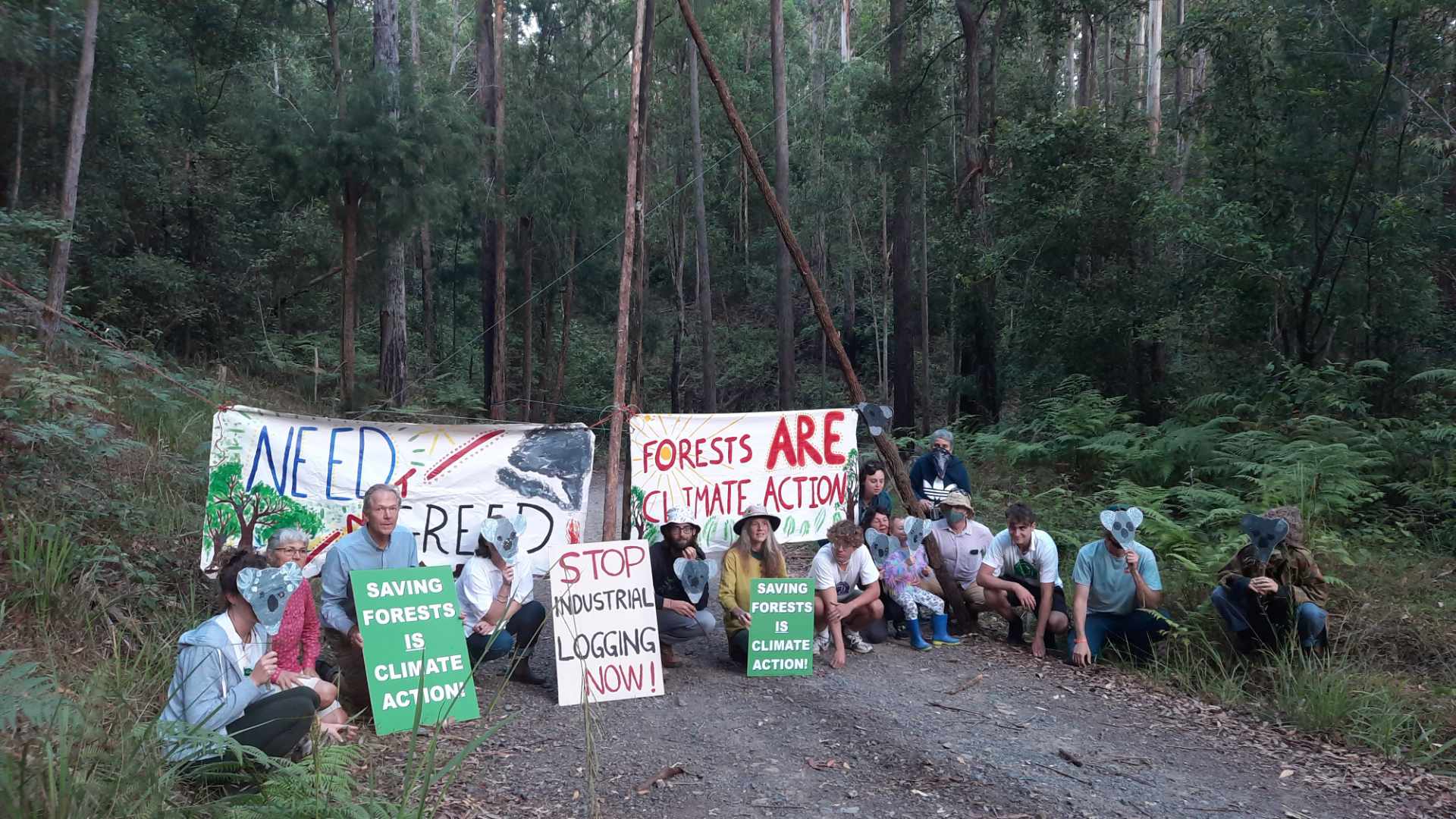
January 12th, 2023. Photo: Save Bulga Forest on Biripi Country 2429
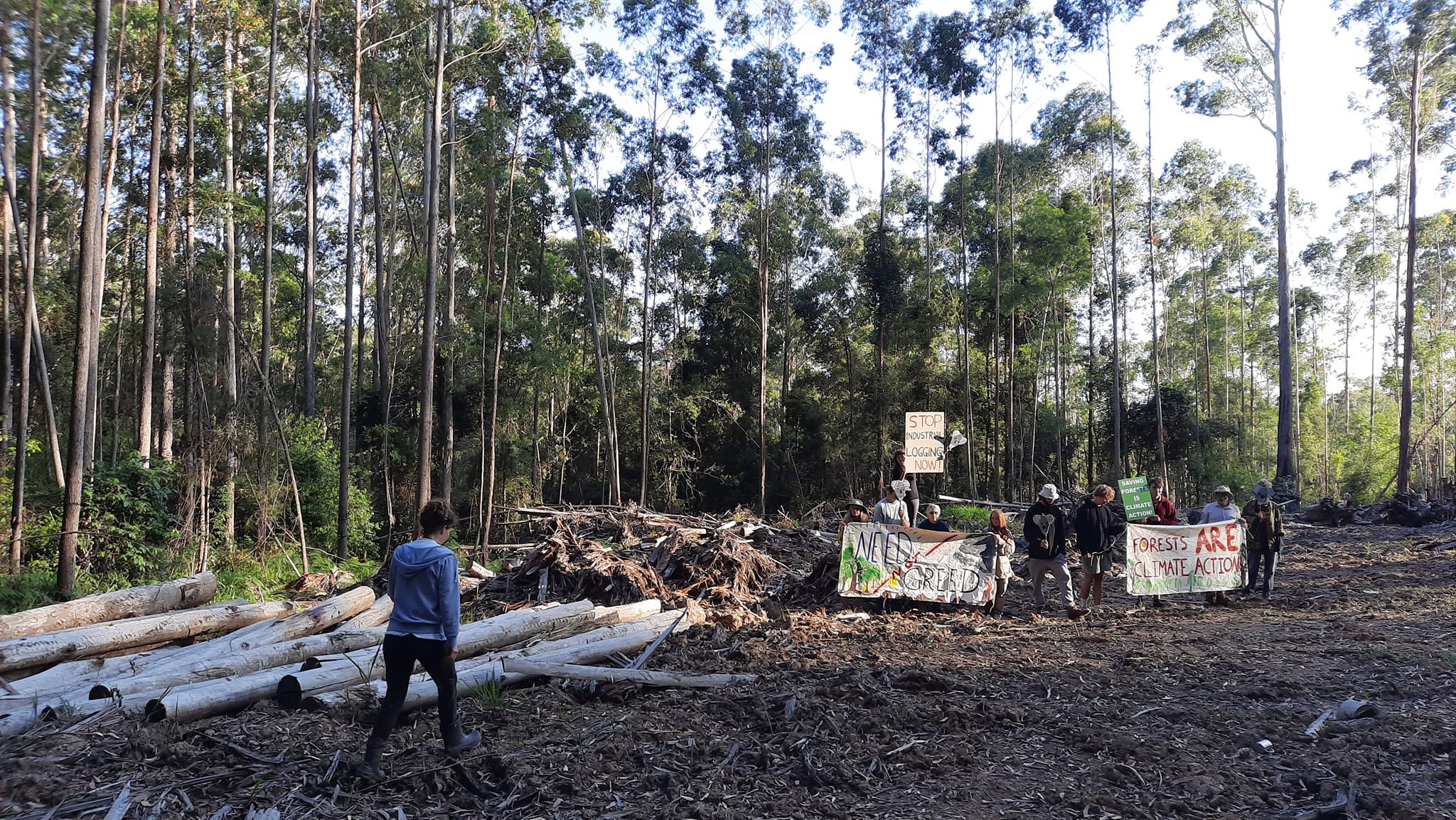
January 12th, 2023. Photo: Save Bulga Forest on Biripi Country 2429
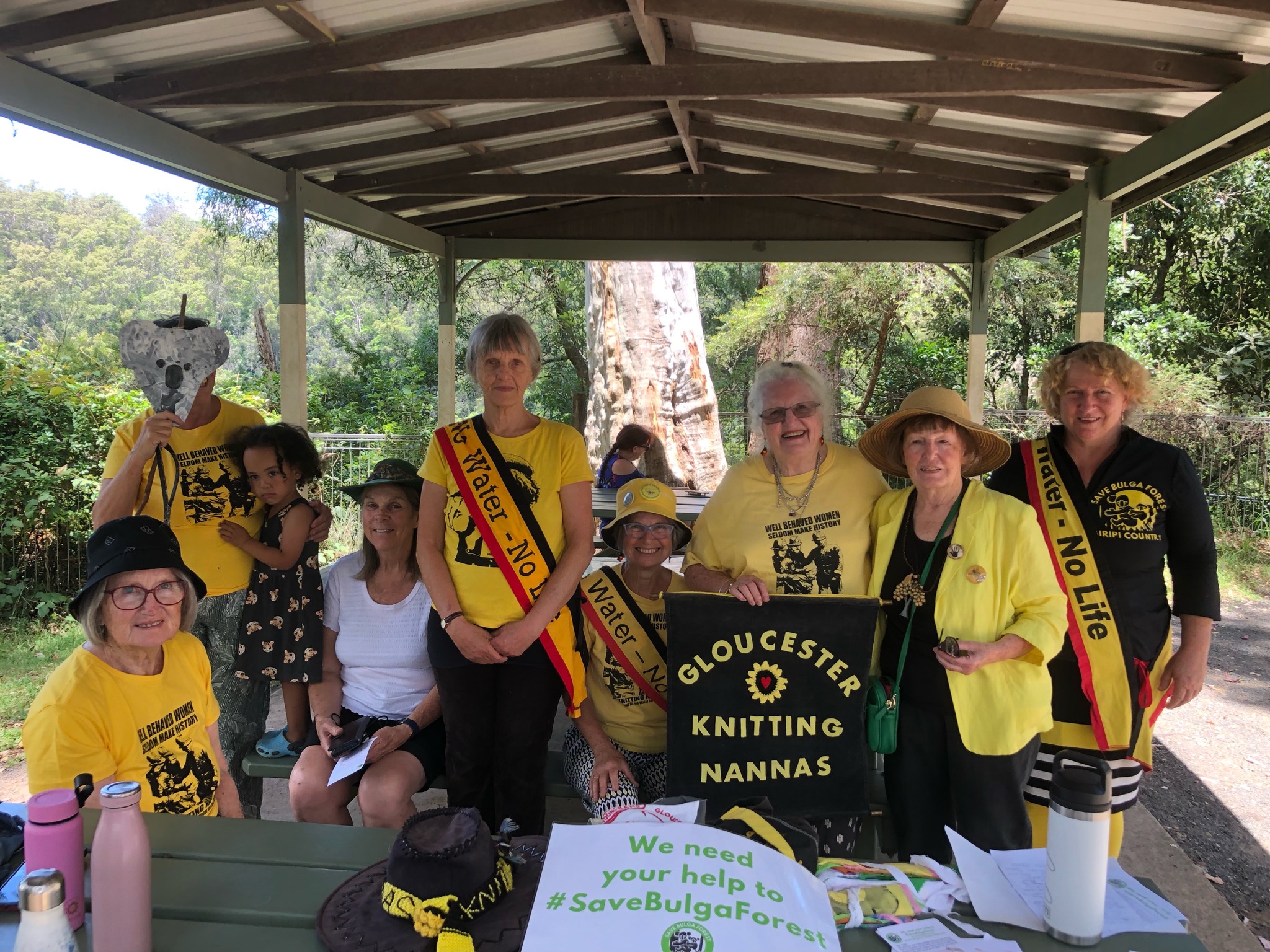
Gloucester Knitting Nannas at Save BulgaForest Falls Camp, January 12th, 2023. Photo: Save Bulga Forest on Biripi Country 2429
Kurri Kurri Lateral Pipeline Approved By NSW State Government
December 27, 2022
The NSW Government has granted planning approval for a new pipeline to deliver natural gas to the future 660 mega-watt gas-fired power station in Kurri Kurri.
Minister for Planning and Minister for Homes Anthony Roberts said the underground pipeline was the crucial link to deliver natural gas from the transmission network to the Hunter Power Project.
“This pipeline will enable the Hunter Power Project to improve energy reliability and security in the National Energy Market, supporting the surge of renewable energy projects,” Mr Roberts said. “The power station will provide on-demand energy when the grid needs it, and will operate on average two percent over a year.”
Snowy Hydro Acting CEO Roger Whitby said the project, coupled with the Hunter Power Project, would be a huge win for the region.
“Together, this pipeline and the Hunter Power Project equate to more than $800 million in spending and 650 construction jobs,” Mr Whitby said.
APA CEO Adam Watson welcomed the NSW Government’s approval of the Environmental Impact Statement.
“As coal is withdrawn across the National Electricity Market at ever increasing rates, gas and gas infrastructure will continue to play an important role in our energy mix by complementing renewables and helping to underpin the energy transition,” Mr Watson said.
“The approval follows a thorough review of the EIS which addresses how the pipeline will be built and operated safely, and how APA plans to continue to work collaboratively with landholders and the community.” Mr Watson stated
The pipeline will provide natural gas to the Hunter Power Project at Kurri Kurri via a connection to the existing gas transmission network at Lenaghan. The power station is being built on part of the site of the former Kurri Kurri Aluminium Smelter, which ceased operations in 2012, and has since been demolished.
However, the Institute for Energy Economics and Financial Analysis had stated the Kurri Kurri Gas Lateral Pipeline project should have been rejected.
''The Kurri Kurri Lateral Pipeline project – Environmental Impact Statement points to a vastly different project to the Kurri Kurri Gas Power project that was approved by the Independent Planning Commission.'' the Institute said in May 2022
''Snowy Hydro maintained that the Kurri Kurri gas power project would cost $600m with a further $100m for the gas lateral. The budget has blown out by $164m to $600m for the power plant and $264m for the gas lateral and storage system. Snowy Hydro will lease the gas lateral and storage system off APA. The $264m cost for the gas lateral understates the true cost to Snowy Hydro as it is before financing costs and a profit margin for APA, the owner of the asset.''
Further, ''The Kurri Kurri Gas power project is not “hydrogen ready” for even the smallest percentages of hydrogen blends as the gas storage system proposed in the Kurri Kurri Lateral pipeline EIS is not hydrogen compatible.''
The Kurri Kurri Lateral Pipeline project is a plan to develop a ~21 km underground gas pipeline from the existing Sydney to Newcastle pipeline to the Hunter Power Project near Kurri Kurri, a compressor station and a 24 km underground gas storage pipeline and ancillary infrastructure.
The application, Environmental Impact Statement and accompanying documents were on exhibition from Wednesday 13 April 2022 until Tuesday 10 May 2022 and the project was listed as 'State Significant Infrastructure' by the Liberal-Nationals Government.
The project will now be submitted to the Commonwealth for final approval, which if granted, with the State Government stating they expected to allow construction to begin in the following months.
For more information, visit the NSW Planning Department's For more information, visit the NSW Planning Portal Kurri Kurri Lateral Pipeline Project webpage.
NSW Government Lists 99-Year Lease For Historic Cadman's Cottage Consultation During End Of Year Break: Closes Same First Week Of New Year
The NSW Government's Department of Environment and Heritage listed historic Cadman's Cottage as open for a 99 year lease on December 14th, 2022, with public submissions on their proposal closing on January 4th 2023, a 21 day 'consultation' period.
The webpage listing the 'Have your say' details states;
'Pursuant to Section 151 of the National Parks and Wildlife Act 1974, the Minister administering the National Parks and Wildlife Act proposes to grant Place Management NSW ABN: 51 437 725 177 (PMNSW) a lease to use Cadmans Cottage Historic Site for the purposes of:
- heritage interpretation
- provision of tourist information for the lessee and lessor
- use as a museum
- use as an Aboriginal cultural centre
- provision of food and beverage facilities and amenities for visitors and tourists
- event activation
- provision of facilities to enable the hosting of conferences or functions ancillary to facilities and amenities for visitors and tourists in accordance with all applicable building codes, safety regulations and laws
- any purpose that enables the adaptive reuse of an existing building or structure or the use of a modified natural area as mutually agreed between the parties in writing.
The proposed term of the lease is 99 years.'
Opponents of the proposal state this is just another example of the Liberal-National Government excising a public owned property from the public, and point to the timing of the consultation as flawed and yet another instance of the incumbent government making announcements or conducting consultations when the community has effectively 'clocked off' from politics and politicians for the year.
''Yet another 'done deal' snuck through by this government under their usual tick a box modus operandi, and as usual, it wouldn't matter how many people oppose this, they will push it through anyway ''.
Cadmans Cottage or Cadman's Cottage is a heritage-listed former water police station and sailor's home and now visitor attraction located at 110 George Street in the inner city Sydney suburb of The Rocks in the City of Sydney local government area of New South Wales, Australia. The property is overseen by the NSW Office of Environment and Heritage, an agency of the Government of New South Wales. It was added to the New South Wales State Heritage Register on 2 April 1999.
Free guided tours of the grounds and bottom level of the house were available. They ran on the 1st and 3rd Sunday of each month from 9.45am to 10.15am, excluding public holidays.
However, NSW National Parks and Wildlife Service advises on their Cadmans Cottage webpage that these are currently suspended and will resume later in 2023.
Place Management NSW is a State Government Entity. Place Management NSW (part of Place Design & Public Spaces) is responsible for managing Sydney’s most historically and culturally significant waterfront locations, including Sydney’s heritage and cultural precincts at The Rocks and Darling Harbour.
Place Management NSW was also responsible for the management of the Public-Private Partnership delivering the new ICC Sydney convention, exhibition and entertainment venues in Darling Harbour.
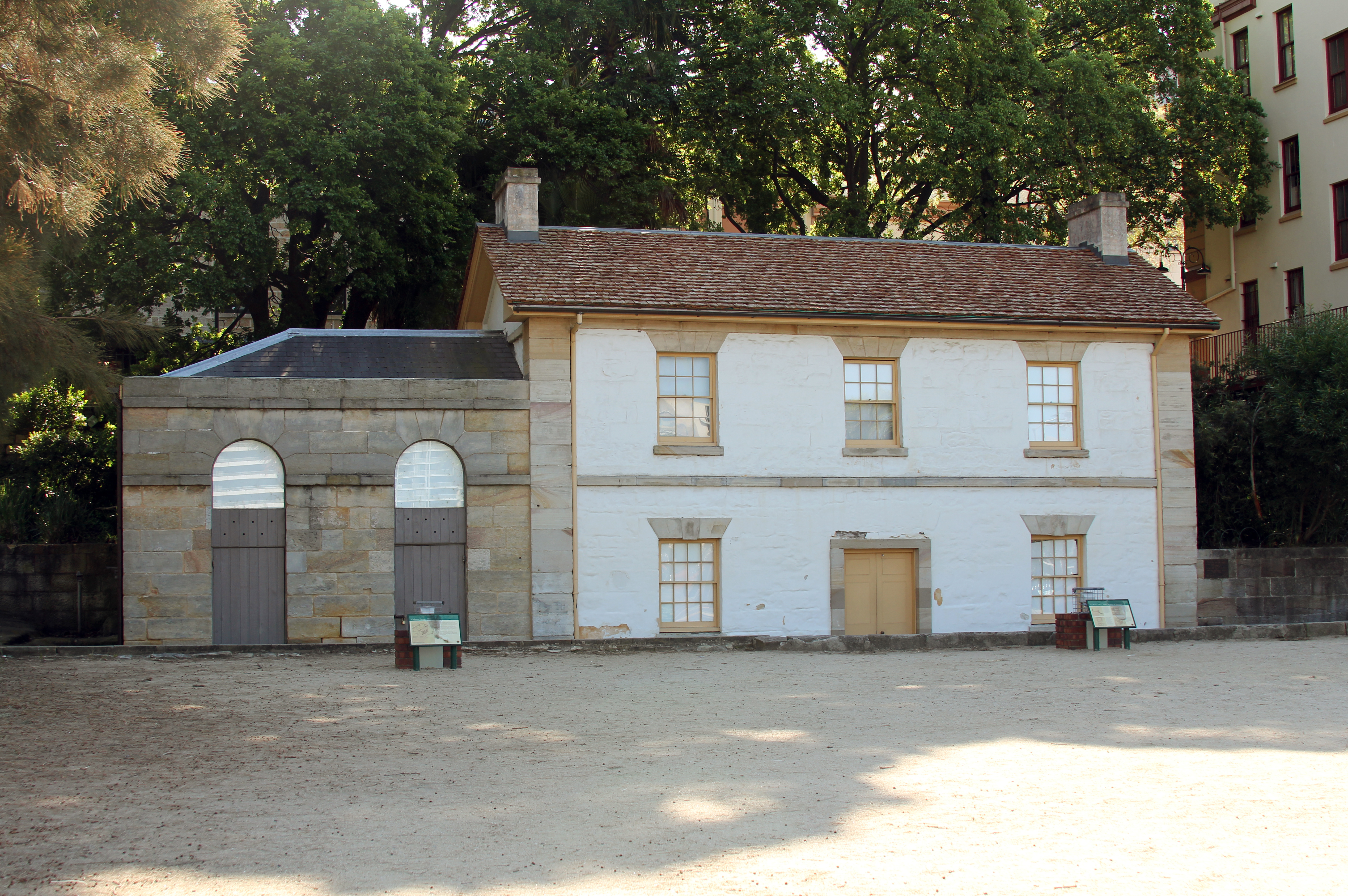
Front view of Cadman's Cottage at The Rocks. Photo: Julioenrekei
A 20+ Years Of Excluding The Public From A Public Asset?: Gardens Of Stone Leases To Privatise Yet Another NSW National Park 'Consult' Listed Over Christmas-New Years Break By State Government - Same Announces Tourism Company For 'Lost City' Tourist Accommodation In Gardens Of Stone
The new Gardens of Stone State Conservation Area Plan of Management was adopted by the Minister for Environment and Heritage, Manly MP James Griffin on 7 November 2022 - this included 'proposed' Commercial activities of a lease of 4 of the 5 areas identified as supported accommodation AND the development and operation of elevated walkways, zip-lines (the 'longest one in Australia'), rope swings, high ropes, via ferrata and flying-fox infrastructure in the Lost City adventure activity precinct.
On December 21st 2022 the incumbent State Government listed a 'Have your Say' page Notice of intention to grant a 20 year lease to Wild Bush Luxury Pty Ltd and Trees Adventure Holdings for what was in that PoM ticked off just weeks before. The 'consultation' closes January 18th 2023 - while residents of NSW are coming back from having clocked off.
Under the National Parks and Wildlife Regulation 2019, section 24 'Commercial activities', (1) A person must not in a park—
(c) compete with or hinder the commercial operations of any person, business or corporate body possessing a lease, licence, occupancy or franchise from the Minister or the Secretary for a specific purpose or purposes
This instance points to the 'step by step' process of those following the incumbent government's policies, as instructed, and shows what could/or is planned to happen at Barrenjoey. That too lists 'Commercial Activities' for the Barrenjoey Headland precinct.
In November 2021, the Liberal-National Government declared 31,500 hectares of the Gardens of Stone north of Lithgow would become a state conservation area, with Premier Dominic Perrottet stating their plan the "most important environmental announcement this government has ever made".
The new reserve were established by legislation introduced that same month by
- Gardens of Stone State Conservation Area (total 28,944 ha) created by the transfer of Newnes, Ben Bullen and Wolgan State forests and Crown land
- additions to Gardens of Stone National Park (342 ha) from Crown land
- additions to Wollemi National Park (2259 ha) from Newnes State Forest.
The coalition government's plans differed from what had originally been proposed by the group, called the Gardens of Stone Alliance, which wanted low-impact eco-tourism ventures, like bushwalking and camping. In a bid to campaign for the full protection of the Gardens of Stone The Blue Mountains Conservation Society has joined forces with two other prominent environmental organisations, Colong Foundation for Wilderness and Lithgow Environment Group.
"[The government] is thinking that will generate more people, more money into the area at a quicker rate," Julie Favell from the Lithgow Environment Group told the ABC
Listed as critically endangered koalas, spotted-tailed quolls and regent honeyeaters are some species which call the area home.
The Gardens of Stone Alliance is asking NSW residents to object to these lease proposals, stating:
''When the Gardens of Stone State Conservation Area was announced on November 13, 2021, the NSW Government also announced an adventure theme park at Lost City and exclusive accommodation in association with a Great Walk.
The National Parks and Wildlife Service is seeking public comments on its intention to grant 20 year leases for these two proposals in parts of the Gardens of Stone State Conservation Area. The period for comments is in the holiday period closing on 18 January. The parent company involved with these proposals is Experience Co, the same company that has plans to develop the Tasmanian Wilderness World Heritage Area.
[we ask people to ]Object to these leases, that will privatise parts of this conservation reserve, [and this being done so] before the public has an opportunity to comment on the details of these developments.
The proposed locations and extent of the accommodation are only approximate and not clearly defined on the simple map provided. Likewise the location of “ziplines, via ferrata and suspension bridges” and other requirements for the Lost City Adventure Precinct. This means that the possible environmental impacts of the proposed lease are hard to identify, let alone avoid them and protect the area.'' the group states
''Ticking the consultation box without information is a sham process. Very limited information is available in the public exhibition of the notice to grant leases.
[Please] Express your concerns about the development threat to this important Blue Mountains reserve before close of business, 18 January 2023.
For more information and assistance with making a submission, go to the gardensofstone.org.au website''. the Gardens of Stone Alliance states
You can provide your written submission via email to: Commercial.Enquiries@environment.nsw.gov.au
On November 16th 2022 the State Government announced it had adopted its Gardens of Stone State Conservation Area (SCA)Plan of Management. This includes drive-in camping facilities in the former Forest Camp, including 100 plus tent sites, toilets, camp kitchen shelter, access to adjoining walking and a MTB track network.
It also includes 'parking and a varied range of other facilities (toilets, picnic tables) at relevant trailheads, to 'Improve facilities to lookout points generally', NSW's first Via Ferrata rock-climbing opportunity, a protected climbing route employing steel cables, rungs or ladders fixed to the rock, Australia's longest zipline and an elevated canyon walk'.
On December 21st 2022 the coalition government announced the Lost City precinct was now ready to move forward through a partnership between the NSW National Parks and Wildlife Service (NPWS) and Experience Co.
The government states ''the partnership follows a competitive Expressions of Interest (EOI) process which will see Experience Co working with NPWS to bring to life plans for the park's new multi-day walk including overnight accommodation and the Lost City zipline adventure experience.''
Head of NSW National Parks Atticus Fleming said the 31,500 hectare Gardens of Stone reserve will deliver diverse experiences catering for all visitors, alongside dedicated conservation programs to protect the exceptional values of the new reserve.
"Thanks to a $50 million dollar investment from the NSW Government, the new reserve will host an array of nature-based options including accessible family-friendly camping areas, bushwalks, lookouts and four-wheel driving routes.
"There will be something for everyone as the reserve will also feature a network of mountain bike tracks catering for all abilities, canyoning and rock climbing.
"The Gardens of Stone's ancient sandstone pagoda formations and canyons will be showcased by the Great Walk, which will link the new State Conservation Area to Wollemi National Park, providing visitors an opportunity to take in outstanding views of this special place, which is home to over 80 rare and threatened species, including koalas and regent honeyeaters."
The first stages of the multi-day walk will be open in mid-2024, the government states.
The zip line and via ferrata experiences at Lost City are projected to open in December 2023.
The planned 'low impact eco-accommodation and public campsites' are also part of this announced private-government partnership.
Experience Co Chief Executive Officer John O'Sullivan said the company was delighted to be selected to partner with NPWS to help deliver 2 exciting new tourism experiences.
"Building on our expertise developing sustainable tourism products in sensitive locations, we are looking forward to creating new experiences that elevate the region and engage with this unique area of NSW as well as recognise the importance of this ancient landscape to Wiradjuri people," he said.
The Government states the Gardens of Stone SCA is expected to attract up to 200,000 new visitors, create around 190 local jobs and generate up to $30 million in regional economic activity each year.
It also states all visitor infrastructure will be subject to rigorous environmental and cultural approvals to ensure effective protection of ecological and cultural values.
The '$50 million dollar investment from the NSW Government' is, of course, from the pockets of taxpayers, despite these announcements keyed to sound as though the government has given the money from the pockets of the politicians who make these announcements.
One resident of the area has stated, ''This is an environmental disaster in the making. All the result of grubby political deals done behind closed doors. The government should hang its head in shame if this is what it calls protecting the unique conservation values of this special place.''
In Tasmania, the only state or territory other than NSW where a Liberal government is still in power, there has been widespread opposition to that incumbent government's privatisation of National Parks.
On June 8th 2022 the Wilderness Society coolly welcomed proposed minor changes by the Tasmanian Government to its discredited ‘tourism expressions of interest’ process that lets commercial tourism developers into the national parks there.
“Given the near-universal unpopularity of and widespread public opposition to the Hodgman, Gutwein and now Rockliff Government’s continued parks privatisation push, business as usual wasn’t really tenable although these changes don’t go far enough,” said Tom Allen, Tasmanian campaign manager for the Wilderness Society.
“Thanks to the public standing up for their public national parks, these proposed changes are the result of strong, sustained and near-universal public opposition to the parks privatisation push and show the need for stronger Community Rights.
“While everyone else has to abide by the state planning laws and environmental assessment requirements, the tourism EOI process creates a low-bar loophole, through which can waltz commercial tourism operators to exploit some of the most ecologically-important lands anywhere, with minimal obligations or oversight. This makes a mockery of the Tasmanian Government’s aspirations to be a global ‘ecotourism’ leader. They should be raising not lowering the bar for these special places.
“It continues to be unacceptable that the Tasmanian Government solicits commercial tourism proposals that breach the Statutory Management Plan for the world’s highest-rated World Heritage wilderness.
“As Experience Co/Wild Bush Luxury’s current plans to commercialise the South Coast Track show, until the Rockliff Government takes the parks privatisation policy and the tourism EOI ‘process’ off the table, the threat to the ecological integrity – and to that of palawa/Aboriginal cultural values – of national parks and World Heritage wilderness remains,” said Mr Allen.
The privatisation and excluding the NSW public from the Gardens of Stone is not the only 'development' proposed of NSW National Parks. On June 19th 2022 the State Government announced upgrades to Dorrigo National Park which will encompass a brand-new Arc Rainforest Centre featuring a huge boardwalk and a new multi-day walk along the escarpment edge through Gondwana World Heritage rainforests, with hut and camping accommodation.
The November 4th 2022 update on same announces 'Planning has commenced on a new multi-day walk and a spectacular new visitor centre as part of a $56 million investment on Gumbaynggirr Country in Dorrigo National Park.'
The Dorrigo Escarpment Great Walk project webpage states it proposes 2 main components to be constructed in stages:
The Dorrigo Arc Rainforest Centre – a new visitor centre and treetop walkway on the footprint of the existing Dorrigo Rainforest Centre, that will provide an improved rainforest experience and accessible access to the existing Balaminda welcome platform and Wonga Walk.
The Dorrigo Escarpment Great Walk – a 46-kilometre multi-day walk ''with 4 purpose-built communal low impact walkers' huts and camping areas'', including a number of additional shorter walking options.
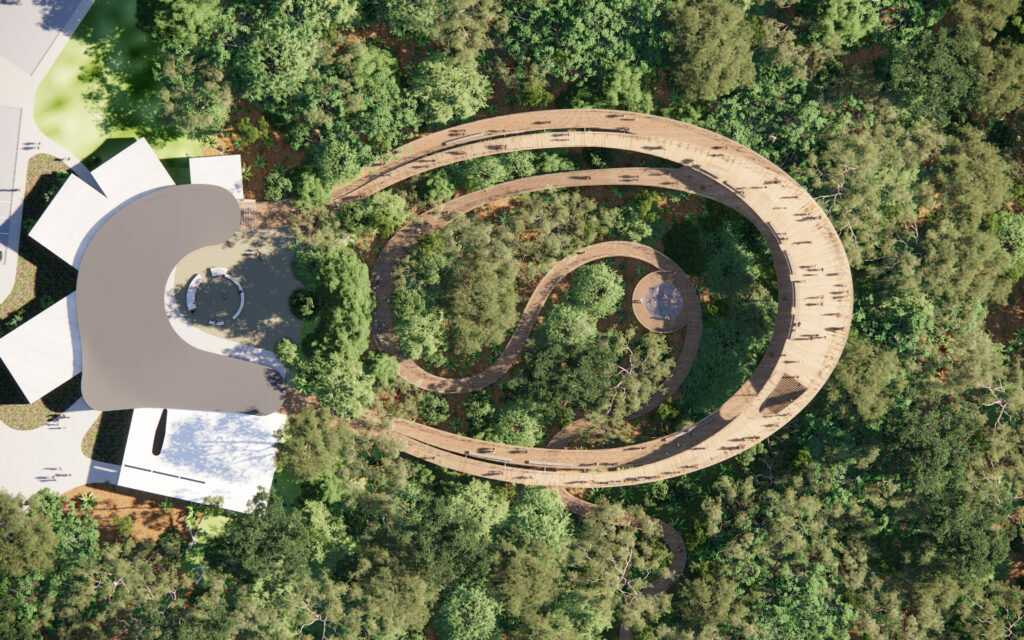
Artistic render of draft plan for the proposed Arc Rainforest Centre. Credit: Studio Hollenstein
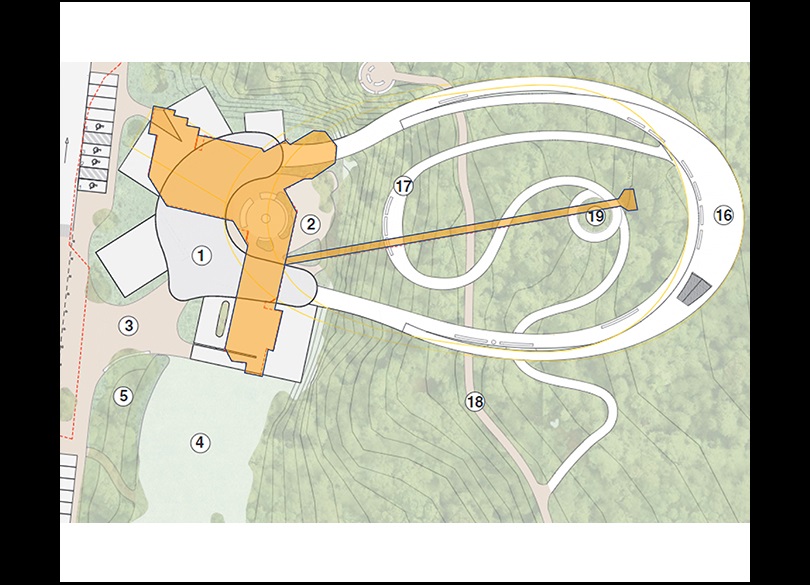
Concept drawing for the proposed new Dorrigo Arc Rainforest Centre, with an overlay of the footprint of the existing rainforest centre existing footprint Credit: DPE
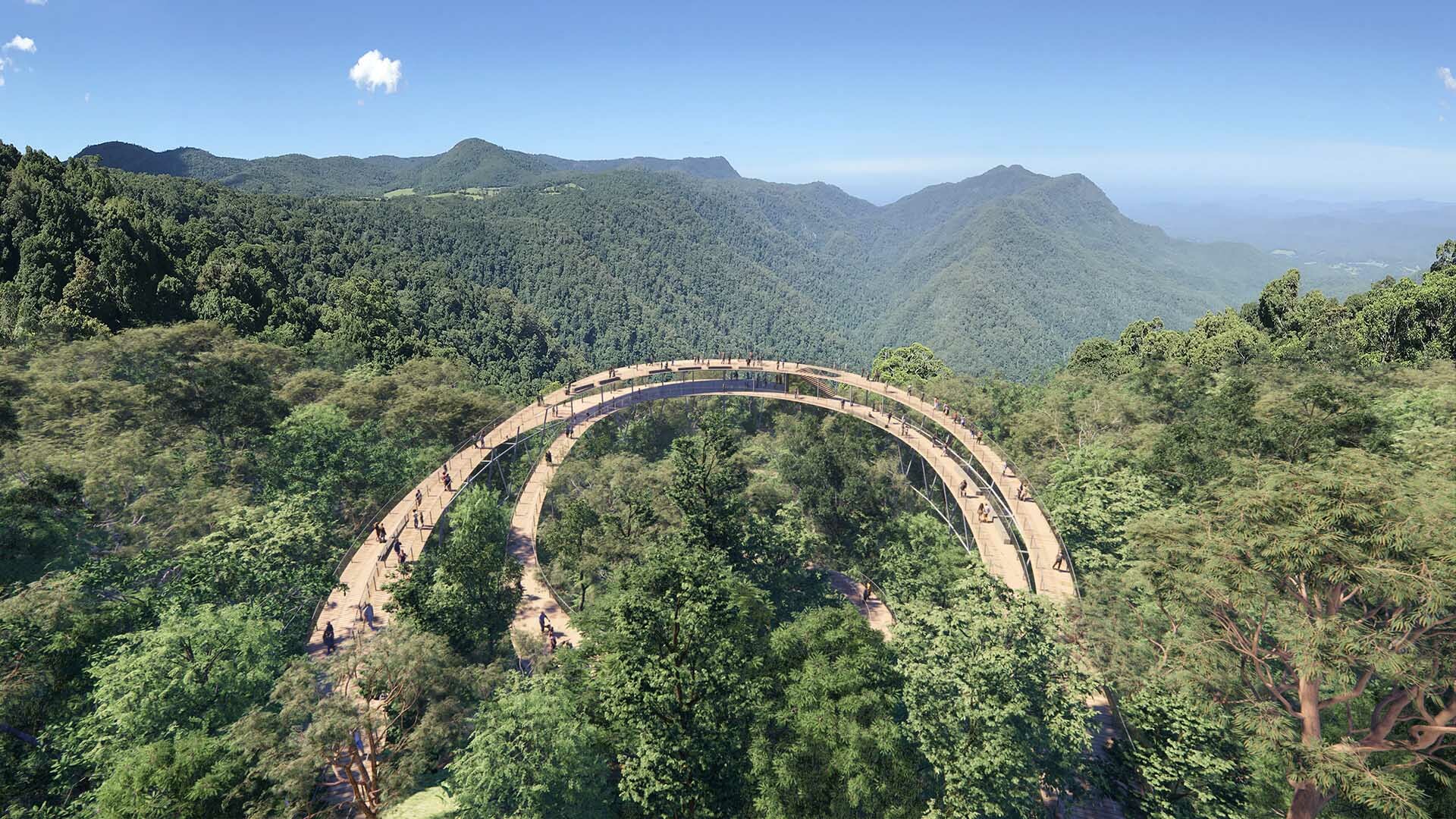
Artistic render of proposed Arc Rainforest Centre with elevated lookout platform. Credit: Studio Hollenstein
Preparation of a new plan of management for Dorrigo National Park, Bindarri National Park and Bindarri State Conservation Area is underway, the NSW Department of Environment states. Once a draft plan of management has been prepared, it will be placed on public exhibition for community feedback.
''We will keep you informed of an opportunity to 'have your say' on the draft plan of management, with public exhibition planned for 2023. We are also planning to exhibit the draft project master plans with the draft plan of management.''
An August 29, 2022 article 'Stealth privatisation’ in iconic national parks threatens public access to nature’s health boost' by Ralf Buckley, International Chair in Ecotourism Research, Griffith University and Alienor Chauvenet, Senior Lecturer, Griffith University stated;
'The public almost always opposes permanent accommodation in parks, whoever owns it, based on the belief private lodges and camps should be on private land.
But state governments in New South Wales, Queensland, Tasmania and South Australia have enabled this regardless. Think of the pristine Ben Boyd National Park near Eden in NSW, slated for eco-tourism cabins at the expense of campers.
The examples go on: ecotourism cabins in Main Range National Park in Queensland, Tasmania’s private Three Capes walk in Tasman national park and a resort in Freycinet National Park, as well as Kangaroo Island in South Australia.
Private developments exclude the wider public, both physically and financially.'
Visit:
Residents Call On Everyone In Sydney To Join Community Protest Against The Commercialisation Of Barrenjoey Headland - January 2023 report
Plan To Commercialise Barrenjoey Lighthouse Precinct On Timetable To Be Pushed Through Prior To 2023 State Election - December 2022 report
Proposal For Barrenjoey Lighthouse Cottages To Be Used For Tourist Accommodation Open For Feedback - Again - October 2022 report
The second Barrenjoey Rally takes place on Sunday January 22nd alongside Station Beach, where the first occurred in 2013.
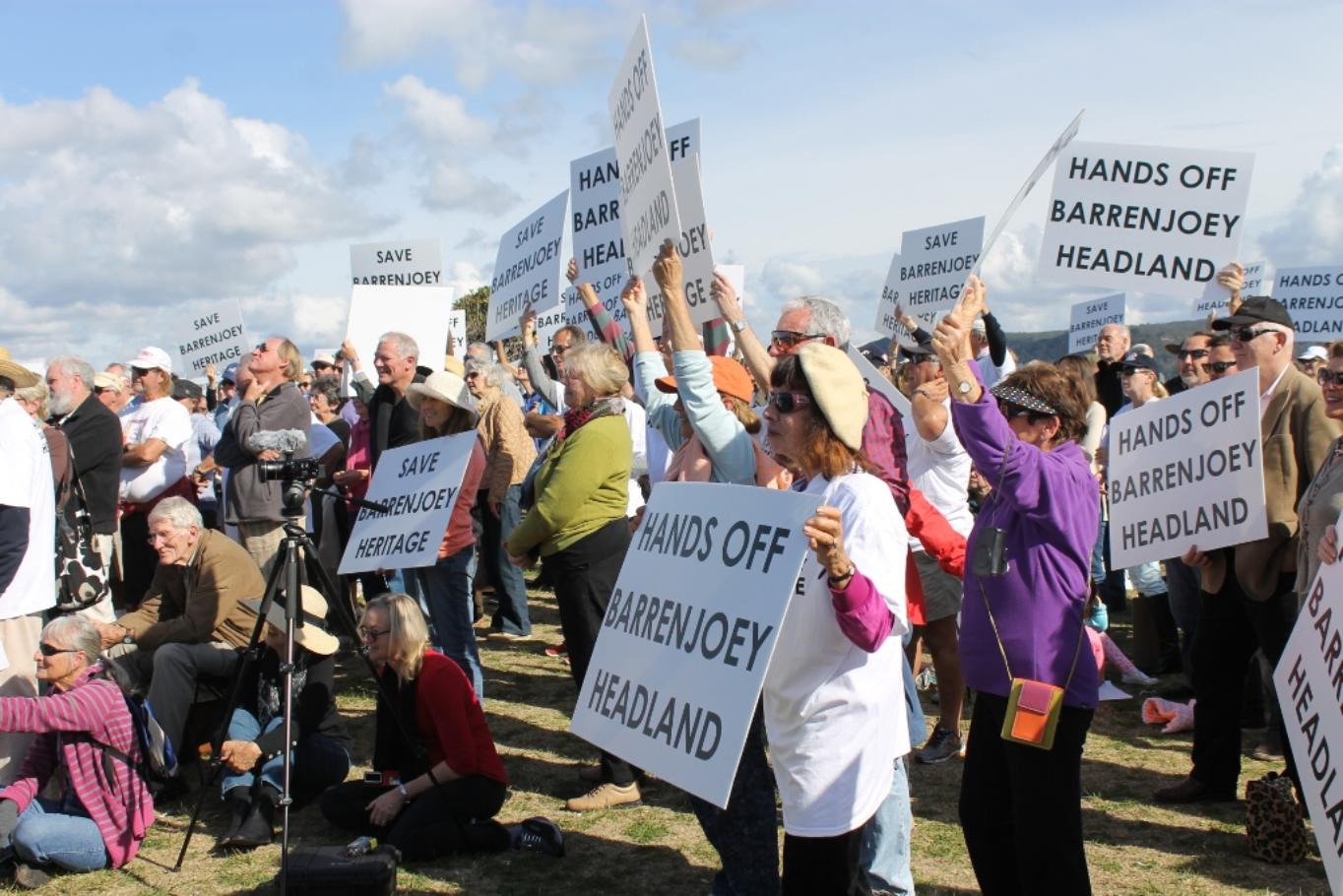
2013 Barrenjoey Rally. Photo: Pittwater Online News

Heritage Listed Walka Water Works To Provide Tourist Accommodation State Government Announces
On January 11, 2022 the Liberal-National Government announced the historic Crown land reserve at Maitland, Walka Water Works, will receive a $10 million boost via Round Two of the NSW Government’s Regional Tourism Activation Fund.
Parliamentary Secretary for the Hunter Taylor Martin said Maitland City Council, Reflections Holiday Parks and Crown Lands had partnered on a joint bid for the funding.
“Walka Water Works is one of the state’s most unique public sites serving the Hunter since 1887 as a source of water, then power and now recreation and heritage,” Mr Martin said.
“This plan aims to restore Walka Water Works to its former glory and invest in additional improvements that can make it a tourism magnet for the Hunter Valley.”
CEO of Reflections Holiday Parks Nick Baker said Reflections would also contribute a further $1.6 million to the project.
"Reflections is excited to partner with Maitland City Council on this successful grant application which will deliver new accommodation options for visitors to Maitland, while enhancing community access and amenity,” Mr Baker said.
“We look forward to working with Council and the community to develop plans for a mix of accommodation offerings, including cabins and powered caravan and camping sites.''
Reflections is a Crown Land Manager and Australia’s only social enterprise holiday park group, reinvesting profit into Crown Land across New South Wales.
Walka Water Works is a heritage-listed 19th-century pumping station at 55 Scobies Lane, Oakhampton Heights, City of Maitland. Originally built in 1887 to supply water to Newcastle and the lower Hunter Valley, it has since been restored and preserved and is part of Maitland City Council's Walka Recreation and Wildlife Reserve.
It was added to the New South Wales State Heritage Register on 2 April 1999.
The complex had been classified by the National Trust in 1976.

Walka Water Works, West Maitland, NSW, Australia [c1893], courtesy University of Newcastle Living Histories node
Presently the area is open as a free public reserve, with barbecues, picnics areas, a playground, walking trails and a 7 1/4 inch gauge miniature railway that operates passenger rides each Sunday.
The reservoir and surrounding bush make it a unique environment for birds and animals in the area.
The proposed works include:
- Restoring the 1885 pumphouse building and chimney back to their original condition to preserve their heritage and allow tourism and hospitality businesses to flourish, such as an interpretive centre, cafés, restaurants, craft brewery or distillery, and event functions.
- Establishing overnight visitor accommodation starting with 10 eco-cabins, 12 glamping tents and 40 powered caravan sites, as well as a camp kitchen and barbecue area.
- Upgrading the Eastern Lawn with landscaping and infrastructure for weddings and other events.
- Redeveloping the miniature train railway station as an improved visitor experience.
- Upgrading walking trails to improve accessibility and include interpretive information.
- Developing a centralised amenities building, upgrading car parking to meet accessibility standards, and other infrastructure improvements.
Clean-Up Notice Issued For Flat Rock Creek Fish Kill At Naremburn And Cammeray
December 22, 2022
The NSW EPA, with the help of Department of Planning and Environment (DPE) scientists, has been sampling and monitoring Flat Rock Creek to better understand the impacts of a recent pollution incident which caused a fish kill.
On 6 December 2022, the EPA received reports of a fish kill and pollution incident in Flat Rock Creek in Naremburn and Cammeray.
The EPA, with the help of DPE, has been sampling and monitoring Flat Rock Creek during and after clean-up of the pollution incident to understand the cause of the fish kill.
This includes sampling to test for contaminants and continuing to monitor dissolved oxygen levels in Flat Rock Creek.
Water quality monitoring has shown a general trend of improvement in dissolved oxygen levels in some parts of Flat Rock Creek.
However, full results are required to determine the cause of the fish kill as there are a number of factors that may have contributed.
The EPA will continue to keep the community informed as the investigation progresses.
Clean-up and advice
As a precautionary measure, residents are advised to be cautious around the creek and keep pets out of the water until investigations are finalised.
The EPA has issued a Clean-Up Notice to Cleanaway Pty Ltd requiring sampling of Flat Rock Creek on a weekly basis until further notice to inform ongoing clean-up efforts.
This follows a fire at Cleanaway’s Artarmon waste storage facility on 5 December 2022 which the EPA believes may have caused a pollution incident at the creek.
The EPA will continue to work with Willoughby Council to monitor the condition of Flat Rock Creek.
Failure To Do Rehabilitation Work Leads To $320,000 In Fines For Central Coast Petrol Station
December 20, 2022
A company has been convicted and fined $320,000 in the Land and Environment Court for failing to comply with a contaminated land Management Order issued by the NSW Environment Protection Authority (EPA) in relation to a petrol station in Kanwal on the Central Coast.
Zoya Investments Pty Ltd plead guilty to the offence, which occurred when it failed to undertake rectification works on its underground petrol storage system and provide a report to the EPA detailing those works.
EPA Executive Director Steve Beaman said the site had been declared significantly contaminated following an assessment by the EPA in 2018.
“The EPA found the soil and groundwater beneath the site was contaminated by petrol and had potential to impact human health and the surrounding environment,” Mr Beaman said.
“We have a high standard for protecting local communities and by not rectifying the identified problems, Zoya Investments has fallen short of this standard.”
The Court found that Zoya Investments had breached the Contaminated Land Management Act 1997 and issued a fine of $180,000 and a further penalty of $140,000 for the time it took for Zoya Investments to ultimately comply with the Management Order.
Mr Beaman said the severity of the fine, particularly the additional cost for not complying with the Management Order for approximately a year, served as a strong deterrent to other operators.
“The EPA expects timely responses to environmental issues and the punishments are severe when companies ignore orders and continue to put the environment and human health at risk.
“The rectification works at the site have now concluded and a report has been provided to the EPA.”
The Court also ordered Zoya to publish notice of the offence in two publications with the Australasian Convenience and Petroleum Marketers Association (ACAPMA), and to pay the EPA’s legal costs.
Zoya Investments’ Director, Rizwan Rana, was separately convicted and fined last month for failing to comply with an EPA investigation notice.
People can report concerns regarding pollution and other environment incidents to the EPA on 131 555.
For more information about the EPA’s regulatory tools, see the EPA Compliance Policy at www.epa.nsw.gov.au/legislation/prosguid.htm
Green streets: why protecting urban parks and bush is vital as our cities grow and become denser
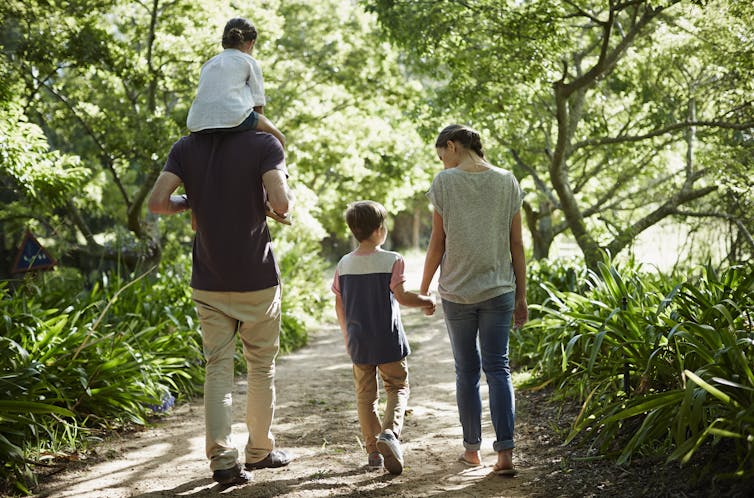
More than half of the world’s population lives in cities. In Aotearoa New Zealand, the proportion of people who live in towns or cities exceeds 86%. With our lives increasingly lived in urban environments, it’s vital for our personal wellbeing – and the planet’s – that city planners find ways to foster a connection with nature.
The evidence is clear – people need direct, personal experiences with nature to care enough to protect it. As evolutionary biologist Stephen Jay Gould argued,
we cannot win this battle to save species and environments without forging an emotional bond between ourselves and nature as well – for we will not fight to save what we do not love.
In our recently published study, we explored the perceptions and experiences of nature that Hamilton residents had in their city.
Hamilton City Council is responsible for 1,142 hectares of open space, including more than 200 parks and reserves. In 2019, the council outlined its goal to have 80% of households with access to a park or open space within 500 metres of home.
Green spaces are any areas of unsealed urban land with some form of vegetation cover. We focused on three types – private gardens, parks dominated by native vegetation (“bush parks”), and parks dominated by introduced vegetation (“lawn parks”, large expanses of mown lawn scattered with individual trees).
Residents took us on tours of different green spaces around the city. During these visits, we asked them about the importance of these places, how they engaged with them and about their plant and animal encounters. We interviewed 21 residents – seven restoration volunteers, seven people who frequently visited bush parks, and seven who visited lawn parks.
We were particularly interested in how people perceived urban green spaces and the benefits they got from them. We also looked at the experiences and connection gained from different natural environments.
Ringing With Birdsong
Kaelin was one of the Hamilton residents who took us on a tour of her garden and local park, one of Hamilton’s many branching gullies.
The gully was cool and quiet, the only sounds the murmurs of the tiny stream at its centre and the occasional indignant cheeps of our fellow fantail. As bell-like flutes punctuated by rude coughs and gurgles announced the presence of a tui, Kaelin turned to me with a delighted smile and said:
You can be down here in the right time of the year and you think, where am I? It’s not the city, it’s just ringing with birdsong.
Our interviewees described native bush parks as special places that provided a relaxing and restorative escape from city life. These green spaces, dominated by native vegetation, were the ones respondents commonly identified as places to sit peacefully and observe nature.
Lawn parks, on the other hand, acted more as “backdrops” for other activities – picnics, sports or farmers’ markets. Residential gardens, like bush parks, allowed for deeper observation and engagement with nature, but as private spaces, they didn’t provide the social benefits that parks do.
The Value Of Diversity
Lawn parks are the most common type of green space in cities. Yet our study highlights that participants valued a diversity of green spaces that would meet a range of needs – their own, those of their community and those of other creatures such as birds, bats and weta.
Interviewees voiced a desire to have spaces in cities where unique New Zealand plants and animals could thrive. Respondents enjoyed sharing their parks and gardens with birds, bats and insects, recognising these animals contributed to the meaning of the place.
Creating habitat in cities for wildlife, however, was only one of the multiple purposes of green spaces that respondents believed were important. They wanted to see a variety of parks that meet a range of community needs.
Just as respondents held multiple priorities for their own gardens, not always just as habitats for native flora and fauna, interviewees also wanted urban green spaces to support multiple uses and not serve exclusively as wildlife habitat.
The Threat Of Densification
But the benefits of green spaces are threatened by the loss of parks and gardens to redevelopment and densification.
New Zealand’s ongoing housing crisis has intensified political debates about urban green spaces, and Hamilton is no different.
The council recently completed consultation on significant changes to density rules in Hamilton’s central city and surrounding areas. The plan will allow three homes of up to three storeys to be developed on most properties, though the council says it is committed to maintaining its public green spaces.
As urban populations continue to rise, our research supports a renewed call for the importance of reserving space for parks and nature in cities. Instead of being a dispensable luxury, green space is crucial for the health and wellbeing of both people and native species.
Finding ways to foster personal experiences of green spaces, and the plants, animals, people and stories that provide meaning, is one way to increase city dwellers’ emotional involvement with local nature. Such subjective bonds can spur the motivation required for people’s everyday actions to nurture and protect what they love.![]()
Elizabeth Elliot Noe, Postdoctoral Fellow, Lincoln University, New Zealand and Ottilie Stolte, Senior Lecturer, University of Waikato
This article is republished from The Conversation under a Creative Commons license. Read the original article.
Five ways you can help stop biodiversity loss in your area – and around the world

Biodiversity refers to the variety of life found on Earth and underpins the natural systems which grow our food, cleanse our air and water and regulate our climate. Human life cannot exist without it. But around one million animal and plant species are now threatened by extinction.
At the recent UN biodiversity conference (COP15) in Montreal, parties agreed on a set of targets for reversing global biodiversity loss by 2030. This includes protecting 30% of the Earth’s surface and reforming subsidies for farming and fishing. Meeting these targets will require coordination between governments and businesses.
Yet the pace at which legislation and policies take effect is exceeded by the global rate of biodiversity loss. Here are some of the most effective actions you can take to help reverse biodiversity loss and restore nature now.
1. Donate
The total area of protected land and sea in the UK increased from 27.6 million hectares in 2017 to 40.6 million hectares in 2022. Much of this area is managed by charities, legal bodies and local authorities.
These organisations, such as the RSPB and the Wildlife Trust, restore biodiversity by creating new habitats, improving existing ones and ensuring that wild areas are connected with forested corridors and reserves to allow species to roam. For example, the Wildlife Trust has reintroduced beavers to fenland in Kent, where wet grassland habitats are now thriving as a result.
But the funds available for nature conservation in the UK are often insufficient. Individuals and businesses can donate money to support the work of these organisations.
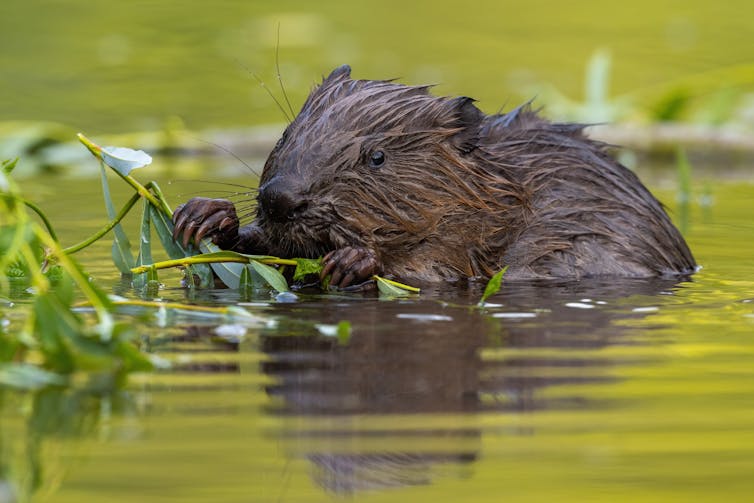
2. Volunteer
Many charitable organisations are dependent on volunteers to undertake administration and marketing, site management or to spread the message about the biodiversity crisis. With new digital ways of working, people could volunteer from their own home at suitable times. Experience is not necessary in most cases and volunteers often benefit from on the job training.
Volunteering can also have other benefits. Research has revealed spending just two hours in nature each week can benefit health and well-being.
3. Change What You Eat
No one likes being lectured about their diet. But unsustainable farming methods, the expansion of agricultural land and our meat-based western diets all threaten biodiversity.
Converting natural habitats to agricultural land has resulted in one-quarter of all remaining mammal species being threatened with extinction. Research has also shown that agricultural intensification now means that more than half of European bird species are threatened or in decline.
To reverse biodiversity loss, we must change both what we eat and how much we consume.
The UK’s National Food Strategy and the Food and Land Use Coalition’s “Better Futures Report” recommend a diet that is less reliant on meat. The Food and Land Use Commission, for example, suggest that, from 2030, a sustainable adult male diet should consist of 14g of red meat per day, 29g of chicken and other poultry, 250g of dairy products, 500g of fruits and vegetables, 50g of nuts and 75g of soya bean and other legumes.
4. Nature-Friendly Gardens
Urbanisation is increasingly fragmenting natural habitats and, as such, species decline is highest in cities. As cities continue to grow it will become more important to have multiple approaches for biodiversity conservation.
Our gardens, although typically not spacious enough to maintain species diversity, can be important habitats in urban environments. Working with our neighbours, we can scale up our gardens by growing networks of flowers to help insects feed and planting trees for birds to nest in. This will increase biodiversity by creating a patchwork of habitats across a whole neighbourhood. Wildlife-friendly gardens can create corridors for a wide range of species and improve connectivity, provide shelter or nesting sites, maintain genetic diversity and increase the abundance of native plants even in the smallest spaces.
A study in 2009 found that there were up to 28.7 million trees, 3.5 million ponds and at least 4.7 million bird nesting boxes in UK gardens. Nesting bird numbers can be increased if we know where trees can be planted for maximum effect. Networks of pollinating flowers across gardens could also help insects and butterflies feed.

5. Indoor Cats And Responsible Dog Owners
Cats are natural predators and allowing your pet to roam freely around the neighbourhood means it – and all the other free-roaming pet cats out there – could be responsible for the deaths of millions of animals each year. Research in Australia revealed that by allowing cats to freely roam, predation on local prey per square kilometre in residential areas is 28–52 times larger than predation rates by feral cats in natural environments. Cats have caused such devastating impacts to Australian wildlife that cat predation is listed as a key threat to native wildlife within national legislation.
In the UK, cat ownership in the UK has increased by 13% on average each year over the past 40 years so that roughly 90% of the UK’s cats are now pets. This has correspondingly increased the threat to our native wildlife.
There are several ways we can reduce the impact of pet cats on biodiversity. Keeping a cat well fed reduces their need to hunt. Another option is to keep them indoors for parts of the day, during the night or entirely. The impact of pet cats on Australian wildlife has grown so severe that local authorities have introduced bylaws and curfews to contain cat predation.
Cats predominantly threaten biodiversity in urban areas. Yet the interaction between dogs and wildlife occurs more frequently in rural situations.
The issue here arises primarily as a result of predation and disease transmission. But dog faeces and urine fertilise soils with nutrients and can change the type of plants that grow in an area. This carries knock-on effects on a habitat’s structure. By picking up dog faeces and correctly disposing of it, dog owners can reduce the input of nitrogen to the soil by 57% and phosphorus by 97%.
The best antidote to despair about the state of the natural world is to immerse yourself in it. Give these steps a try and you should hopefully discover more ways to not only lessen your footprint, but enjoy a more vibrant local environment.

Don’t have time to read about climate change as much as you’d like?
Get a weekly roundup in your inbox instead. Every Wednesday, The Conversation’s environment editor writes Imagine, a short email that goes a little deeper into just one climate issue. Join the 10,000+ readers who’ve subscribed so far.![]()
Kate Hiseman, Senior Lecturer Practitioner in Environment and Sustainability, Anglia Ruskin University
This article is republished from The Conversation under a Creative Commons license. Read the original article.
Meet the eastern bristlebird: tragically under-appreciated, and one fire away from local extinction
Dominique Potvin, University of the Sunshine CoastAm I not pretty enough? This article is part of The Conversation’s series introducing you to unloved Australian animals that need our help.
In 1962, renowned American conservationist Rachel Carson wrote a book entitled “Silent Spring” after she noticed the birdsong she used to wake up to as a child had been thinning. Its eventual absence had become almost deafening.
This deep dive into one of the tragedies of biodiversity loss eventually became one of the most influential works contributing to changes in legislation and practices surrounding the use of pesticides in the United States, and worldwide.
Its title, however, continues to resonate with many of us: birds (and frogs, insects, and many other animals) seem to announce their arrivals with songs and calls. Their absence becomes notable when the singing stops, and silence takes over.
Such has been the case in Australia for the under-appreciated, endangered eastern bristlebird (Dasyornis brachypterus).
Once common, its numbers have declined so dramatically in the past 40 years that only three populations remain in the central east coast of Australia. The northernmost population, found in southeast Queensland, has as few as 70 birds.
So why should we care about one more, seemingly unremarkable little brown bird in the forest?
Australia’s Canary In A Coal Mine
At first glance, the eastern bristlebird doesn’t seem like a vulnerable bird. There is nothing too unique about its propensity to nest in clumped grasses or its territorial behaviours. Its song, while beautiful, doesn’t stand out in a typical Australian forest or heathland soundscape.
But this small, unassuming bird may be Australia’s canary in the coal mine when it comes to fire.
Since the 1980s, researchers have been trying to understand why the eastern bristlebird has seen such rapid decline. Time and again, fire regimes come up as the main factor predicting whether an eastern bristlebird population is stable or under threat. Fire regimes refer to the periods between fires, and their relative intensity and coverage.
While Australian landscapes are generally well adapted to fire, not all fires are created equal. Burn offs often take place without adequate research or knowledge, and at the wrong times. This – along with the increase in fire frequency, climate change and habitat loss – has contributed to dramatic losses of this species.
Fire can be devastating for many wild animals, but there is something special about the bristlebird that makes it particularly vulnerable to large, frequent fires.
Its Greatest Threats
Eastern bristlebirds, despite being able to fly, appear not to appreciate the view of a top story dwelling. They don’t choose to live in the canopy, or even on lower branches of trees. Over millennia, the bristlebird has evolved a strong, almost exclusive preference for low, dense vegetation.
This habitat structure is important for many invertebrates and other small animals even less noticeable than the bristlebird, such as spiders, beetles and worms. This means the bristlebird can act like an indicator for how the entire understory ecosystem is doing.
Unfortunately, low, dense vegetation is often the first thing to burn and disappear during a fire. It also appears to take quite some time for bristlebirds to establish themselves again in an area, once a fire has come and gone.
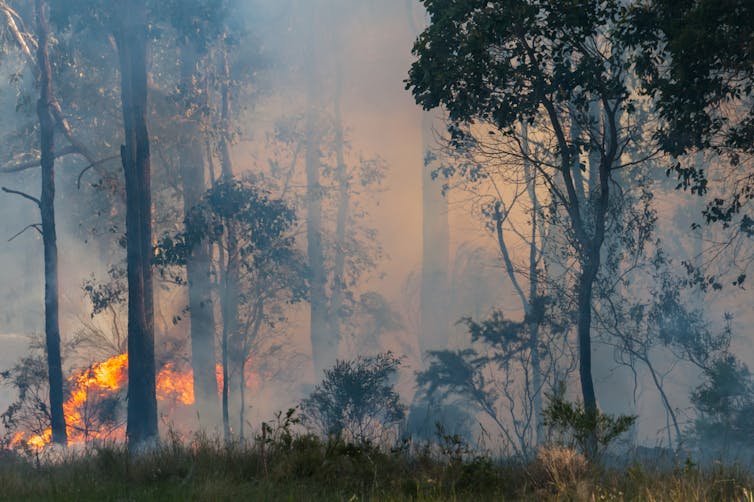
While we often see fire recovery as being green and lush, it can take years for an understory to recover fully and thus support its full community, including bristlebirds.
If fire was the only issue, it might be easy (or, at least, straightforward) to help this species recover. However, because of the distances between populations, the eastern bristlebird also suffers from genetic isolation. This means small populations can be more susceptible to inbreeding, and thus disease or general ill health.
We then compound the inbreeding effects with introduced predators such as cats and foxes, invasive weeds, habitat loss due to agriculture, and general roadkill, and we have a perfect storm of threats.
Isolated, vulnerable populations may only be one fire away from local extinction, signalling a potential collapse of their ground-level ecosystem.
This knowledge prompted emergency helicopter rescues of bristlebirds in Victoria to captivity at the height of the horror 2019-2020 bushfire season. This likely saved the species in the state.
In Queensland and New South Wales, the release of captive birds from breeding programs to recovering areas helped bring the species back from the brink.
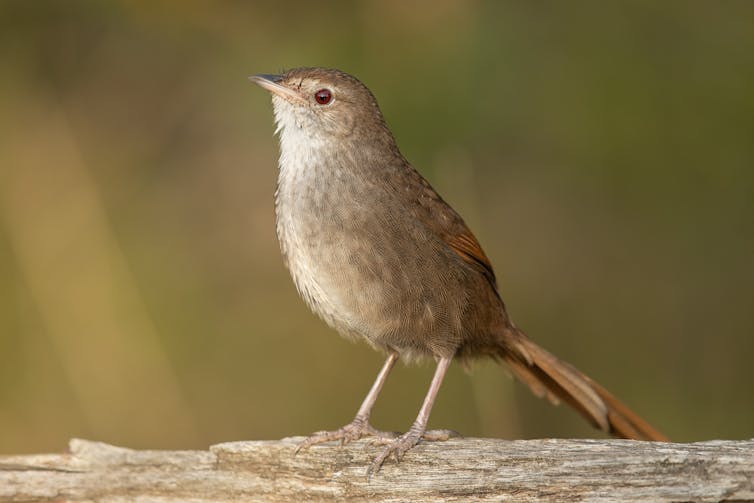
But We Have Reason To Hope
All is not lost, however. Captive breeding and translocation (moving individual animals from one population to another, to help boost genetic diversity) programs are in place for this little unassuming bird.
It’s important these programs are put in place alongside habitat-based strategies to ensure their success. This includes keeping feral animals away from where birds are released back into the wild, removing weeds and, perhaps most important, slowing fire regimes in certain areas.
Removing invasive species and recovering habitat are important strategies for saving just about every vulnerable native Australian species, from plants, to invertebrates, to charismatic larger animals such as koalas.
The eastern bristlebird may therefore be the little brown bird that could save entire ecosystems. Move over, canaries.![]()
Dominique Potvin, Senior Lecturer in Animal Ecology, University of the Sunshine Coast
This article is republished from The Conversation under a Creative Commons license. Read the original article.
Chubb review of Australia’s carbon credit scheme falls short – and problems will continue to fester
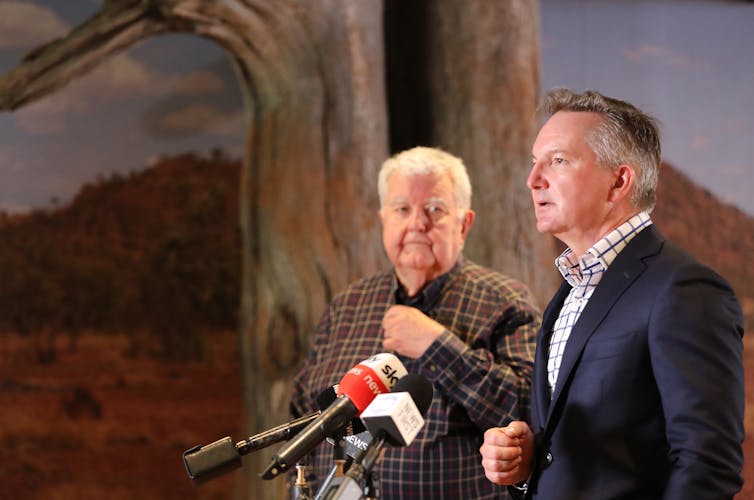
An independent review of Australia’s controversial carbon credit system released today concluded the scheme is essentially sound. But key questions remain unaddressed – a fact that will continue to undermine confidence in Australia’s central climate policy.
The review, led by former chief scientist Ian Chubb, followed concerns raised by our research team that the scheme lacked integrity and was not delivering genuine reductions in greenhouses gas emissions. The review panel, however, says it does “not share this view”.
Climate Change and Energy Minister Chris Bowen on Monday said the government accepted all 16 of the review panel’s recommendations.
But more must be done to ensure the Albanese government truly delivers the emissions reductions it has promised.
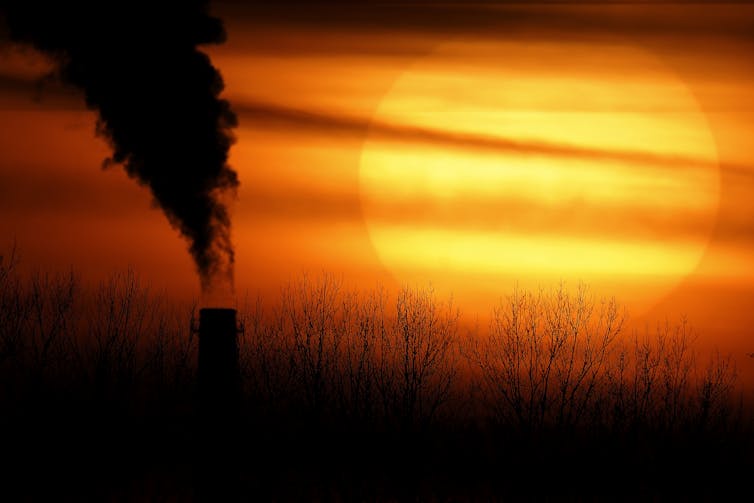
Carbon Credits Underpin Our Climate Policy
Australia’s carbon credit system is central to reaching the federal government goal of 43% emissions reduction by 2030 and net-zero by 2050.
The scheme provides carbon credits to projects that reduce greenhouse gas emissions using a number of approved methods, such as avoiding deforestation. These credits can be sold on the carbon market to entities that want to offset their emissions.
In March last year, our research team raised serious concerns about the scheme. In a series of papers, we outlined systemic flaws in the way carbon credits were issued.
We concluded Australia’s Emissions Reduction Fund – under which the scheme operates – has serious governance flaws, has issued a large number of low integrity credits and is wasting billions of dollars in taxpayers’ money.
Our analysis focused on three of the fund’s most popular methods – avoiding deforestation, human-induced regeneration of native forests and combusting methane from landfills. These account for 75% of the credits issued under the scheme.
We found that more than 70% of the credits issued under these methods do not represent genuine emissions abatement.
Following that criticism, in July last year, the Albanese government commissioned an independent review of the scheme. Those findings were released today.
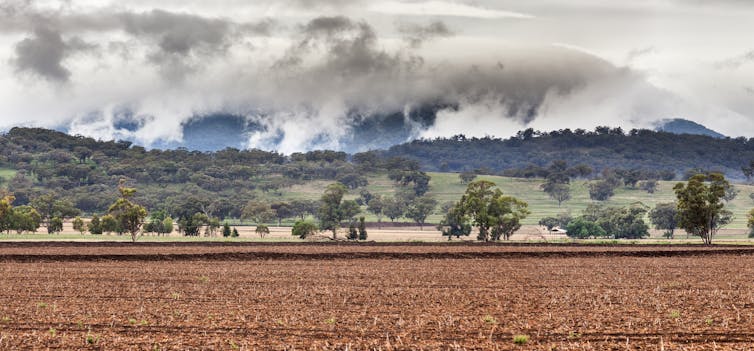
A ‘Bewildering’ Assessment
The panel concluded the carbon credit arrangements are largely sound. How the panel reached this conclusion is hard to fathom.
Discussion of the rules governing human-induced regeneration, landfill gas and avoided deforestation projects spans less than six pages.
The report does not contain references to the evidence relied upon to reach its conclusions, and includes very little analysis to support its findings. And importantly, the panel does not address key questions around the integrity of the scheme’s rules.
Bewilderingly, in its assessment of the methods, the panel does not refer to the findings of a review it commissioned from the Australian Academy of Science to inform its considerations.
The academy reviewed the three main methods my research team analysed and a fourth, concerning carbon capture and storage.
It found numerous flaws in the methods and the associated governance processes. For example, consistent with our analysis, it found a risk the human-induced regeneration method is crediting vegetation change brought on by rainfall, rather than project activities.
The academy also found problems with the landfill gas method – namely, that so-called “baselines” used to calculate carbon abatement don’t adequately account for other financial and regulatory incentives offered to operators for capturing and combusting methane.
This means credits are sometimes issued for actions the industry would take anyway. As I wrote in The Conversation in September last year, so great are the problems with the landfill gas method that several large companies profiting from it have called for changes to the system.
The academy is not alone in recognising these problems. The CSIRO and Wentworth Group of Concerned Scientists also found problems with the rules governing the issuance of credits.
The review panel acknowledged the scientific evidence criticising the carbon credit scheme, but says “it was also provided with evidence to the contrary”. Yet it did not disclose what that evidence was or what it relates to. The public is simply expected to trust that the evidence exists.
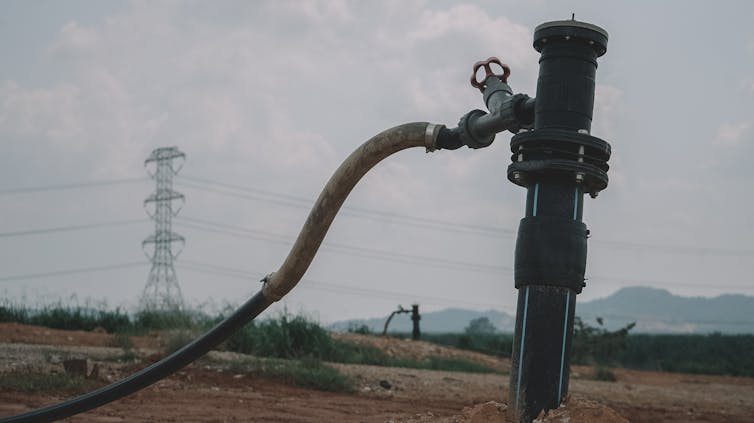
Integrity Is Essential
The panel recommended significant changes to governance arrangements under the carbon credits scheme. It’s hard to understand the need for such changes if there are no material problems with the credits.
Nonetheless, most recommended governance changes are welcome, including:
reducing the roles performed by the Clean Energy Regulator, to “enhance confidence and transparency” and reduce potential conflicts of interest
amend the scheme’s legislation to improve transparency to support greater public trust and confidence in the scheme.
But these governance changes are not enough. Measures should be taken to prevent low-integrity credits being issued to existing projects. And polluting facilities should not be allowed to use low-integrity credits to meet their emission reduction obligations.
Without these changes, problems with the scheme will continue to fester, jeopardising the operation of the government’s climate policy.![]()
Andrew Macintosh, Professor and Director of Research, ANU Law School, Australian National University and Don Butler, Professor, Australian National University
This article is republished from The Conversation under a Creative Commons license. Read the original article.
6 reasons 2023 could be a very good year for climate action

Many people think of the annual UN climate talks as talkfests which achieve only incremental change, at best. Activist Greta Thunberg has described them as “blah blah blah” moments – grossly inadequate and too often hijacked by fossil fuel producers who would like the world to keep buying their main exports.
Look more closely. The world is slowly but surely shifting away from fossil fuels. When historians look back, they will likely see the 2015 Paris agreement as the key pivot point. It achieved a global consensus on climate action and set the goal for nations to decarbonise by mid-century.
In recent years, the enormous task of switching from fossil fuels to clean energy has been given a boost by tailwinds from the need to get off Russian gas, to the plummeting cost of clean energy.
Focusing on the success of global talks is no longer the only game in town. To see real progress, look to countries like China, Germany and the United States, who are moving faster to invest in clean energy technologies – not just for the world’s sake, but because it’s in their own interests to move first.
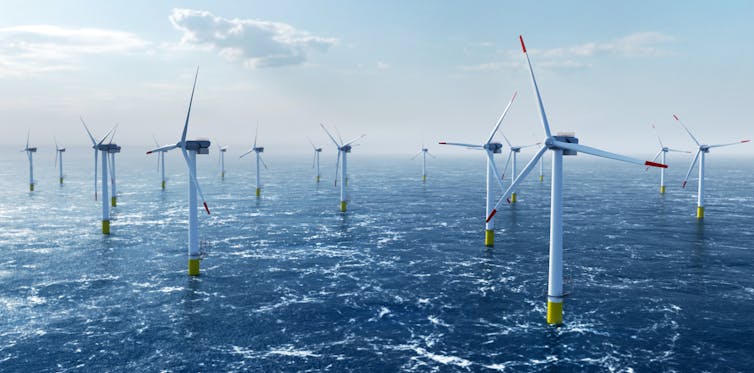
From Paris With Love: Why The Paris Agreement Is So Vital
After decades of torturous negotiations and bitter disappointment at the UN COP climate talks, the hard-won 2015 Paris agreement was a major diplomatic breakthrough. Achieved with rare consensus, it has huge legitimacy. That’s what makes it powerful. It sets the standard for all nations to follow.
So what did it do? It introduced a new global norm: achieving net-zero. Countries agreed to keep the world’s heating “well below 2℃ […] and to pursue efforts to limit the temperature increase to 1.5℃”.
To get there, the globe must achieve net zero emissions by around mid-century. All countries need to set national targets to cut emissions and strengthen them every five years. Since 2015, well over 100 countries have pledged to achieve net zero. These countries represent more than 90% of the global economy.
The pledges made in Paris and afterwards are beginning to drive faster change. In the five years to 2020, global clean energy investment grew by 2%. Since 2020, the pace of growth has accelerated significantly to 12% a year. The International Energy Agency (IEA) now expects global fossil fuel use to peak this decade, before the world economy switches irreversibly to clean energy.
At present, the transition is not happening fast enough. But it is happening. And there’s no turning back. Here are six encouraging trends to watch in 2023.
1. G7 Economies Will Form A ‘Climate Club’
In December, the G7 grouping of the world’s richest democracies agreed to form a “climate club”. Conceived by Nobel Prize-winning economist William Nordhaus, the club is an arrangement where countries develop common standards for climate ambition and share benefits among club members. The club will focus first on decarbonisation of industries such as steelmaking.
2. New Carbon Tariffs Will Be Introduced In The EU
To avoid the problem of European companies becoming less competitive with companies from nations without a carbon price, EU nations agreed in December to bring in carbon tariffs.
That means imports from countries without an adequate carbon price will be taxed. It also means European companies can’t offshore production to avoid the carbon price.
This is just the tip of the spear, with other rich nations like Canada looking to follow suit. Over time, these tariffs will have a ripple effect, forcing countries reliant on exporting to these markets to move faster toward decarbonisation.
3. The Ukraine War Boosted Renewables, As Nations Focus On Energy Security
When Russia invaded Ukraine, Western nations slapped sanctions on Moscow and cut imports of Russian gas. Fossil fuel prices spiked. Bad news, right? Not so fast. The IEA says the war has actually supercharged clean energy investment by making clean energy a matter of security.
In response to Putin’s invasion, major European economies increased renewable energy targets as they moved to end reliance on Russian gas. With renewables ramping up, the EU now intends to set a stronger 2030 emissions target before the COP28 climate summit later this year.
4. The United States And China Are Competing To Lead The Shift To Clean Energy
Climate action doesn’t have to rely on cooperation. Competition is an excellent driver as well. Last year, the United States passed legislation investing over A$530 billion in clean energy.
The largest climate spend in US history was also intended to compete with China, which dominates global production of solar panels, batteries, wind turbines and electric vehicles.
5. Rich Nations Are Paying Developing Economies To Quit Coal
In 2021, a grouping of rich nations offered South Africa $A12 billion to shift away from its reliance on coal power. At the Bali G20 summit last year, rich nations offered Indonesia almost A$30 billion to get off coal, while a similar offer was made to Vietnam in December. This year all eyes will be on India, with hopes a similar package will be offered.
6. Coalitions Of The Willing
In September, UN Secretary General Antonio Guterres will host a “no nonsense” climate ambition summit, ahead of the formal COP talks in November. Why? He wants big economies to bring new commitments to cut emissions earlier – as in this decade. There will be “no room for back-sliders, greenwashers, blame-shifters or repackaging of announcements”, he declared.
It’s not the only parallel push. Alongside the formal UN talks, we’re seeing a flowering of groupings dubbed coalitions of the willing. These range from the Powering Past Coal Alliance diplomatic alliance to the Global Methane Pledge to more ambitious proposals like the Fossil Fuel Non-Proliferation Treaty, put forward by Vanuatu and Tuvalu last year.
So while the UN climate talks are the bedrock of global cooperation, we’re also seeing a patchwork quilt forming of extra measures. These under the radar efforts will be vital to driving ever-faster climate action.![]()
Wesley Morgan, Research Fellow, Griffith Asia Institute, Griffith University
This article is republished from The Conversation under a Creative Commons license. Read the original article.
Nine UNSW Projects To Receive Funding Under The ARENA Research And Development Program
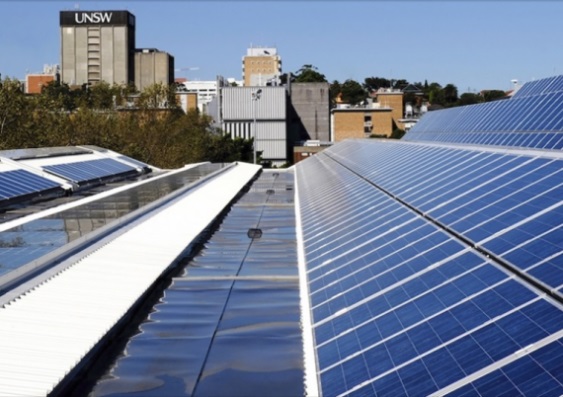 UNSW Sydney researchers have been awarded a share of $41.5 million from the Australian Renewable Energy Agency (ARENA) Research and Development (R&D) Program to support research and development (R&D) and commercialisation activities that aim to significantly reduce the cost of solar.
UNSW Sydney researchers have been awarded a share of $41.5 million from the Australian Renewable Energy Agency (ARENA) Research and Development (R&D) Program to support research and development (R&D) and commercialisation activities that aim to significantly reduce the cost of solar.Team Projects Two Out Of Three Glaciers Could Be Lost By 2100
January 6, 2023
Carnegie Mellon University Assistant Professor David Rounce of Civil and Environmental Engineering led an international effort to produce new projections of glacier mass loss through the century under different emissions scenarios. The projections were aggregated into global temperature change scenarios to support adaptation and mitigation discussions, such as those at the recent United Nations Conference of Parties (COP 27). His work showed that the world could lose as much as 41 percent of its total glacier mass this century—or as little as 26 percent—depending on today’s climate change mitigation efforts.
Specifically, Rounce and his team found that in a future scenario with continued investment in fossil fuels, over 40 percent of the glacial mass will be gone within the century, and over 80 percent of glaciers by number could well disappear. Even in a best-case, low-emissions scenario, where the increase in global mean temperature is limited to +1.5° C relative to pre-industrial levels, over 25 percent of glacial mass will be gone and nearly 50 percent of glaciers by number are projected to disappear. A majority of these lost glaciers are small (less than one km2) by glacial standards, but their loss can negatively impact local hydrology, tourism, glacier hazards, and cultural values.
His work provides better context for regional glacier modelling, and he hopes it will spur climate policymakers to lower temperature change goals beyond the 2.7° C mark that pledges from COP-26 are projected to hit. Smaller glacial regions like Central Europe and Western Canada and the United States will be disproportionately affected by temperatures rising more than 2° C. At a 3° C rise, glaciers in these regions almost disappear completely.
Rounce noted that the way in which glaciers respond to changes in climate takes a long time. He describes the glaciers as extremely slow-moving rivers. Cutting emissions today will not remove previously emitted greenhouse gasses, nor can it instantly halt the inertia they contribute to climate change, meaning even a complete halt to emissions would still take between 30 and 100 years to be reflected in glacier mass loss rates.
Many processes govern how glaciers lose mass and Rounce’s study advances how models account for different types of glaciers, including tidewater and debris-covered glaciers. Tidewater glaciers refer to glaciers that terminate in the ocean, which causes them to lose a lot of mass at this interface. Debris-covered glaciers refer to glaciers that are covered by sand, rocks, and boulders. Prior work by Rounce has shown that the thickness and distribution of debris cover can have a positive or negative effect on glacial melt rates across an entire region, depending on the debris thickness. In this newest work, he found that accounting for these processes had relatively little impact on the global glacier projections, but substantial differences in mass loss were found when analysing individual glaciers.
The model is also calibrated with an unprecedented amount of data, including individual mass change observations for every glacier, which provide a more complete and detailed picture of glacier mass change. The use of supercomputers was thus essential to support the application of state-of-the-art calibration methods and the large ensembles of different emissions scenarios.
Global glacier change in the 21st century: Every increase in temperature matters. David R. Rounce, Regine Hock, Fabien Maussion, Romain Hugonnet, William Kochtitzky, Matthias Huss, Etienne Berthier, Douglas Brinkerhoff, Loris Compagno, Luke Copland, Daniel Farinotti, Brian Menounos and Robert W. McNabb, 5 January 2023, Science. DOI: 10.1126/science.abo1324
Reef Fish Must Relearn The 'Rules Of Engagement' After Coral Bleaching
Antarctica’s emperor penguins could be extinct by 2100 – and other species may follow if we don’t act
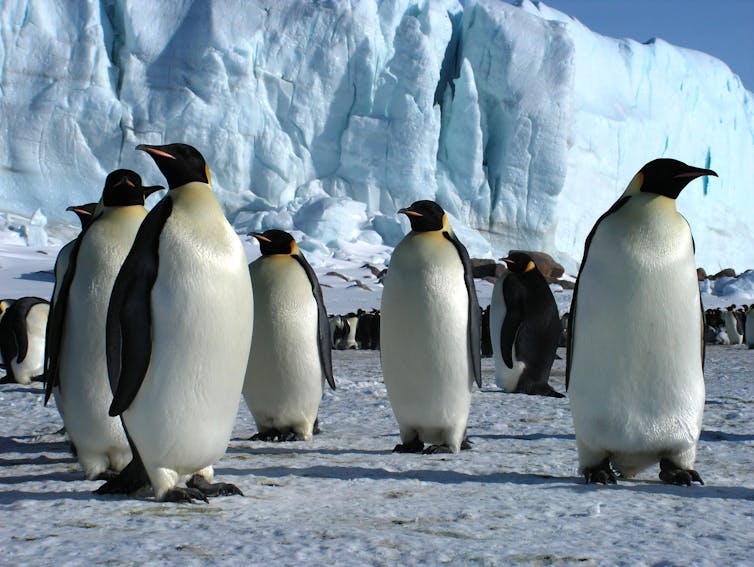
Greater conservation efforts are needed to protect Antarctic ecosystems, and the populations of up to 97% of land-based Antarctic species could decline by 2100 if we don’t change tack, our new research has found.
The study, published today, also found just US$23 million per year would be enough to implement ten key strategies to reduce threats to Antarctica’s biodiversity.
This relatively small sum would benefit up to 84% of terrestrial bird, mammal, and plant groups.
We identified climate change as the biggest threat to Antarctica’s unique plant and animal species. Limiting global warming is the most effective way to secure their future.
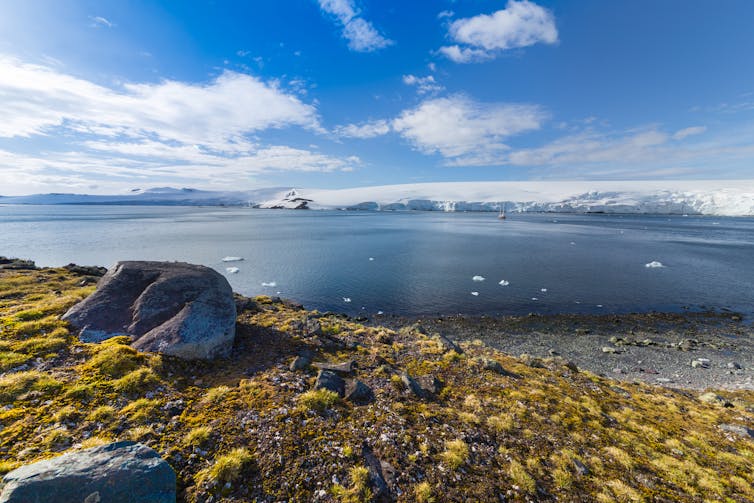
Threats To Antarctic Biodiversity
Antarctica’s land-based species have adapted to survive the coldest, windiest, highest, driest continent on Earth.
The species includes two flowering plants, hardy moss and lichens, numerous microbes, tough invertebrates and hundreds of thousands of breeding seabirds, including the emperor and Adélie penguins.
Antarctica also provides priceless services to the planet and humankind. It helps regulate the global climate by driving atmospheric circulation and ocean currents, and absorbing heat and carbon dioxide. Antarctica even drives weather patterns in Australia.
Some people think of Antarctica as a safe, protected wilderness. But the continent’s plants and animals still face numerous threats.
Chief among them is climate change. As global warming worsens, Antarctica’s ice-free areas are predicted to expand, rapidly changing the habitat available for wildlife. And as extreme weather events such as heatwaves become more frequent, Antarctica’s plants and animals are expected to suffer.
What’s more, scientists and tourists visiting the icy continent each year can harm the environment through, for example, pollution and disturbing the ground or plants. And the combination of more human visitors and milder temperatures in Antarctica also creates the conditions for invasive species to thrive.
So how will these threats affect Antarctic species? And what conservation strategies can be used to mitigate them? Our research set out to find the answers.
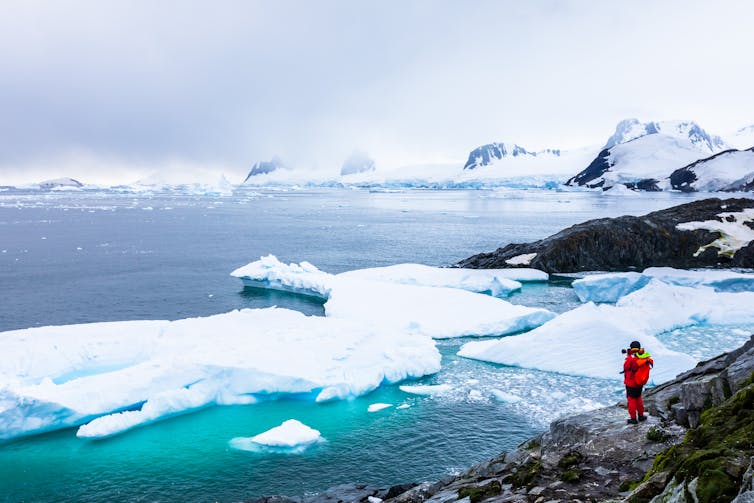
What We Found
Our study involved working with 29 experts in Antarctic biodiversity, conservation, logistics, tourism and policy. The experts assessed how Antarctica’s species will respond to future threats.
Under a worst-case scenario, the populations of 97% of Antarctic terrestrial species and breeding seabirds could decline between now and 2100, if current conservation efforts stay on the same trajectory.
At best, the populations of 37% of species would decline. The most likely scenario is a decline in 65% of the continent’s plants and wildlife by the year 2100.
The emperor penguin relies on ice for breeding, and is the most vulnerable of Antarctica’s species. In the worst-case scenario, the emperor penguin is at risk of extinction by 2100 – the only species in our study facing this fate.
Climate change will also likely wreak havoc on other Antarctic specialists, such as the nematode worm Scottnema lindsayae. The species lives in extremely dry soils, and is at risk as warming and ice-melt increases soil moisture.
Climate change won’t lead to a decline in all Antarctic species – in fact, some may benefit initially. These include the two Antarctic plants, some mosses and the gentoo penguin.
These species may increase their populations and become more widely distributed in the event of more liquid water (as opposed to ice), more ice-free land and warmer temperatures.

So, What To Do?
Clearly, current conservation efforts are insufficient to conserve Antarctic species in a changing world.
The experts we worked with identified ten management strategies to mitigate threats to the continent’s land-based species.
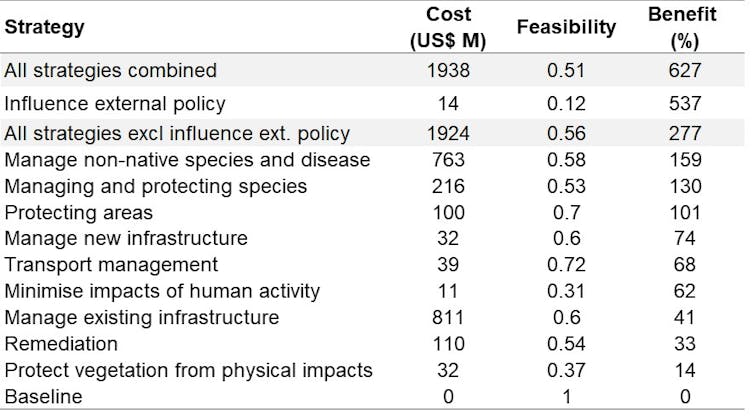
Unsurprisingly, mitigating climate change (listed as the “influence external policy” strategy) would provide the greatest benefit. Reducing climate change to no more than 2℃ of warming would benefit up to 68% of terrestrial species and breeding seabirds.
The next two most beneficial strategies were “managing non-native species and disease” and “managing and protecting species”. These strategies include measures such as granting special protections to species, and increasing biosecurity to prevent introductions of non-native species.
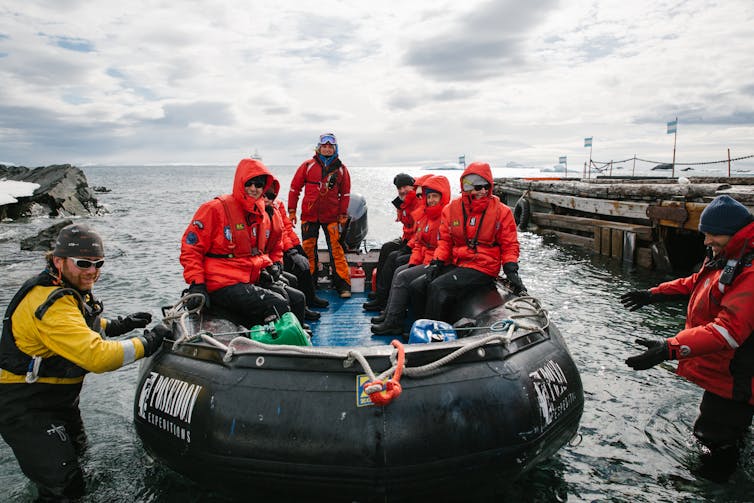
How Much Would It All Cost?
The United Nations’ COP15 nature summit concluded in Canada this week. Funding for conservation projects was a core agenda item.
In Antarctica, at least, such conservation is surprisingly cheap. Our research found implementing all strategies together could cost as little as US$23 million per year until 2100 (or about US$2 billion in total).
By comparison, the cost to recover Australia’s threatened species is estimated at more than US$1.2 billion per year (although this is far more than is actually spent).
However, for the “influence external policy” strategy (relating to climate change mitigation) we included only the cost of advocating for policy change. We did not include the global cost of reducing carbon emissions, nor did we balance these against the much greater economic costs of not acting.
As Antarctica faces increasing pressure from climate change and human activities, a combination of regional and global conservation efforts is needed. Spending just US$23 million a year to preserve Antarctica’s biodiversity and ecosystems is an absolute bargain.![]()
Jasmine Lee, Conservation biologist, Queensland University of Technology; Iadine Chadès, Principal research scientist, CSIRO, and Justine Shaw, Conservation Biologist, The University of Queensland
This article is republished from The Conversation under a Creative Commons license. Read the original article.
More than 100,000 tourists will head to Antarctica this summer. Should we worry about damage to the ice and its ecosystems?
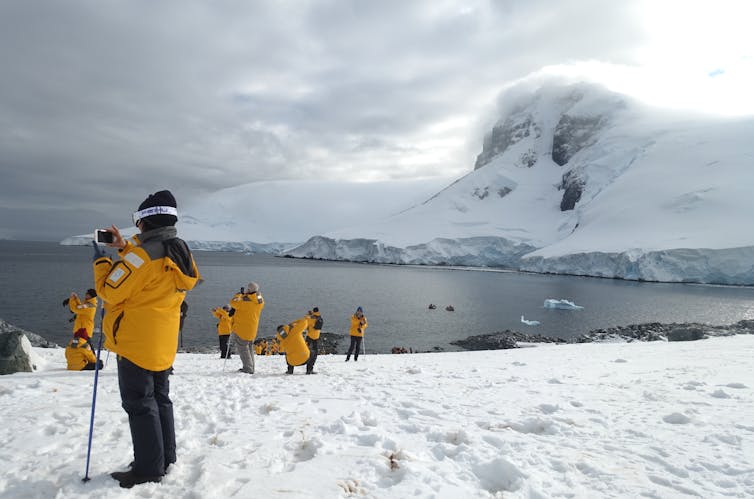
As the summer sun finally arrives for people in the Southern Hemisphere, more than 100,000 tourists will head for the ice. Travelling on one of more than 50 cruise ships, they will brave the two-day trip across the notoriously rough Drake Passage below Patagonia, destined for the polar continent of Antarctica.
During the COVID summer of 2020-21, just 15 tourists on two yachts visited Antarctica. But now, tourism is back – and bigger than ever. This season’s visitor numbers are up more than 40% over the largest pre-pandemic year.
So are all those tourists going to damage what is often considered the last untouched wilderness on the planet? Yes and no. The industry is well run. Tourists often return with a new appreciation for wild places. They spend a surprisingly short amount of time actually on the continent or its islands.
But as tourism grows, so will environmental impacts such as black carbon from cruise ship funnels. Tourists can carry in microbes, seed and other invasive species on their boots and clothes – a problem that will only worsen as ice melt creates new patches of bare earth. And cruise ships are hardly emissions misers.
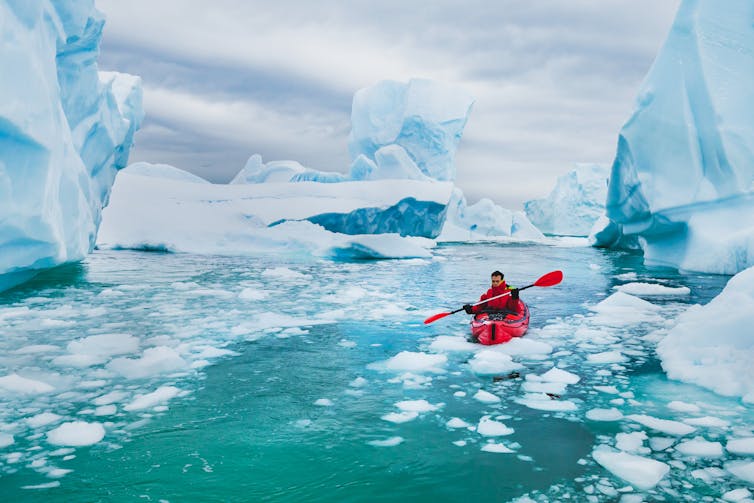
How Did Antarctic Tourism Go Mainstream?
In the 1950s, the first tourists hitched rides on Chilean and Argentinian naval vessels heading south to resupply research bases on the South Shetland Islands. From the late 1960s, dedicated icebreaker expedition ships were venturing even further south. In the early 1990s, as ex-Soviet icebreakers became available, the industry began to expand – about a dozen companies offered trips at that time. By the turn of this century, the ice continent was receiving more than 10,000 annual visitors: Antarctic tourism had gone mainstream.
What does it look like today?
Most Antarctic tourists travel on small “expedition-style” vessels, usually heading for the relatively accessible Antarctic Peninsula. Once there, they can take a zodiac boat ride for a closer look at wildlife and icebergs or shore excursions to visit penguin or seal colonies. Visitors can kayak, paddle-board and take the polar plunge – a necessarily brief dip into subzero waters.
For most tourists, accommodation, food and other services are provided aboard ship. Over a third of all visitors never stand on the continent.
Those who do set foot on Antarctica normally make brief visits, rather than taking overnight stays.
For more intrepid tourists, a few operators offer overland journeys into the continent’s interior, making use of temporary seasonal camp sites. There are no permanent hotels, and Antarctic Treaty nations recently adopted a resolution against permanent tourist facilities.
As tourists come in increasing numbers, some operators have moved to offer ever more adventurous options such as mountaineering, heli-skiing, underwater trips in submersibles and scuba diving.
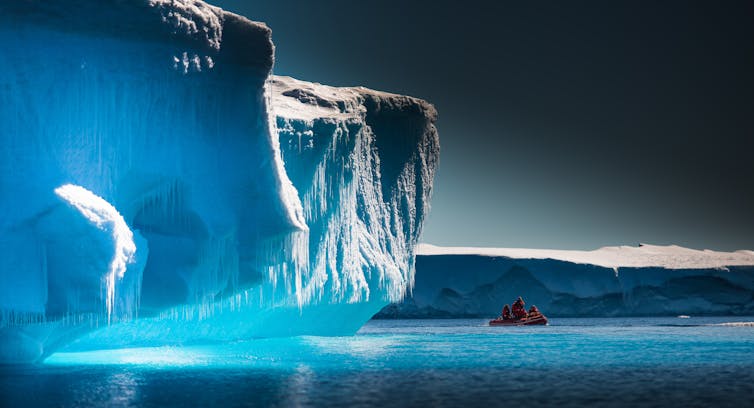
Is Antarctic Tourism Sustainable?
As Antarctic tourism booms, some advocacy organisations have warned the impact may be unsustainable. For instance, the Antarctic and Southern Ocean Coalition argues cruise tourism could put increased pressure on an environment already under significant strain from climate change.
In areas visited most by tourists, the snow has a higher concentration of black carbon from ship exhaust, which soaks up more heat and leads to snow melt. Ship traffic also risks carrying hitchhiking invasive species into the Southern Ocean’s vulnerable marine ecosystems.
That’s to say nothing of greenhouse gas emissions. Because of the continent’s remoteness, tourists visiting Antarctica have a higher per capita carbon footprint than other cruise-ship travellers.
Of course, these impacts aren’t limited to tourism. Scientific expeditions come with similar environmental costs – and while there are far fewer of them, scientists and support personnel spend far more time on the continent.
Antarctic Tourism Isn’t Going Away – So We Have To Plan For The Future
Are sustainable cruises an oxymoron? Many believe so.
Through its sheer size, the cruise industry has created mass tourism in new places and overtourism in others, generating unacceptable levels of crowding, disrupting the lives of residents, repurposing local cultures for “exotic” performances, damaging the environment and adding to emissions from fossil fuels.
In Antarctica, crowding, environmental impact and emissions are the most pressing issues. While 100,000 tourists a year is tiny by global tourism standards – Paris had almost 20 million in 2019 – visits are concentrated in highly sensitive ecological areas for only a few months per year. There are no residents to disturb (other than local wildlife), but by the same token, there’s no host community to protest if visitor numbers get too high.
Even so, strong protections are in place. In accordance with the Antarctic Treaty System – the set of international agreements signed by countries with an Antarctic presence or an interest – tourism operators based in those nations have to apply for permits and follow stringent environmental regulations.
To avoid introducing new species, tourists have to follow rules such as disinfecting their boots and vacuuming their pockets before setting foot on the ice, and keeping a set distance from wildlife.
Almost all Antarctic cruise owners belong to the International Association of Antarctica Tour Operators, the peak body that manages Antarctic tourism.
For the first time this year, operators have to report their overall fuel consumption as part of IAATO’s efforts to make the industry more climate-friendly. Some operators are now using hybrid vessels that can run partly on electric propulsion for short periods, reducing carbon dioxide emissions.
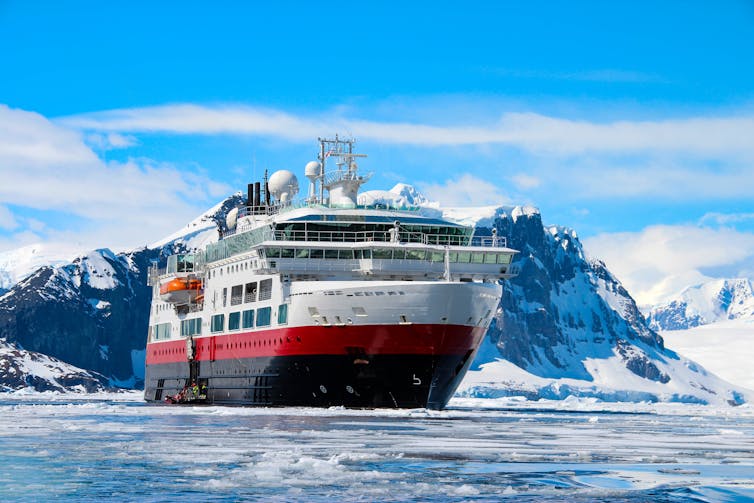
Returning From The Ice: The Ambassador Effect
Famed travel writer Pico Iyer recently wrote of his experience in the deep south of the world. The visit, he said, “awakens you to the environmental concerns of the world … you go home with important questions for your conscience as well as radiant memories”.
Iyer isn’t alone. This response is widespread, known in the industry as Antarctic ambassadorship. As you’d expect, this is strongly promoted by tourism operators as a positive.
Is it real? That’s contentious. Studies on links between polar travel and pro-environmental behaviour have yielded mixed results. We are working with two operators to examine the Antarctic tourist experience and consider what factors might feed into a long-lasting ambassador effect.
If you’re one of the tourists going to Antarctica this summer, enjoy the experience – but go with care. Be aware that no trip south comes without environmental cost and use this knowledge to make clear-eyed decisions about your activities both in Antarctica and once you’re safely back home. ![]()
Elizabeth Leane, Professor of English and Associate Dean, Research Performance, University of Tasmania; Anne Hardy, Associate Professor, Tourism and Society, University of Tasmania; Can Seng Ooi, Professor, University of Tasmania; Carolyn Philpott, Senior Lecturer in Musicology, Conservatorium of Music, School of Creative Arts and Media; Adjunct Senior Researcher, Institute for Marine and Antarctic Studies, University of Tasmania, University of Tasmania; Hanne E.F. Nielsen, Lecturer, University of Tasmania, and Katie Marx, PhD Candidate, Centre for Marine Socioecology, University of Tasmania
This article is republished from The Conversation under a Creative Commons license. Read the original article.
The lie of aqua nullius, ‘nobody’s water’, prevails in Australia. Indigenous water reserves are not enough to deliver justice
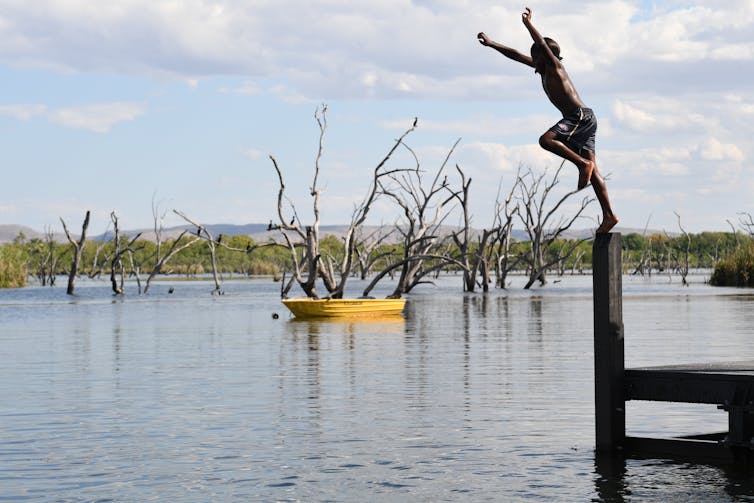
When the British colonised Australia they assumed terra nullius, “nobody’s land”, and aqua nullius, “nobody’s water”. In 1992, terra nullius was overturned – but aqua nullius remains.
Aqua nullius denies the existence of Indigenous peoples’ own water governance principles, laid down through ancestral “first laws”. These customary laws are carried through songlines, trade routes and ceremony, embedded in a deep reciprocal economy of sharing. First laws guide the custodianship of living waters, with attention to intergenerational equity.
Living waters – from rivers, to ancient aquifers to wetlands – are sacred and alive. As the source of energy to animate Country, living waters are critical to Indigenous Peoples’ collective survival. The responsibility of caring for waters (and land) are a central concern of Indigenous Peoples – but this responsibility is thwarted by aqua nullius.
Queensland, Northern Territory and Western Australia have sought to distribute water rights to Indigenous people by establishing “Indigenous (or Aboriginal) water reserves”, setting aside a portion of water from the consumptive pool for Indigenous people’s future use.
In our new policy brief, we unpack the benefits and limitations of these reserves. As it stands, the policy measure alone does not deliver justice for Indigenous peoples. A broader approach is needed.
The Right To Water
Indigenous people must be able to access water in their territories if they so choose.
A United Nations declaration recognises the right to water for Indigenous people. Yet First Nations water holdings in Australia and elsewhere are abysmally low. For example, Indigenous people or organisations hold less than 0.2% of surface water entitlements in the Murray Darling Basin.
In the struggle against aqua nullius, Indigenous people’s right to make decisions about water on Country is a priority. But importantly, when we talk about “water rights” for Indigenous people, the rights to access and use water is only one aspect.
The bigger picture problem is that the decision-making power over water remains with governments, and this power is not shared with Indigenous people.
We agree aqua nullius is unacceptable and must change. Establishing Indigenous water reserves is one option, but it’s far from clear it will deliver what Indigenous communities need.
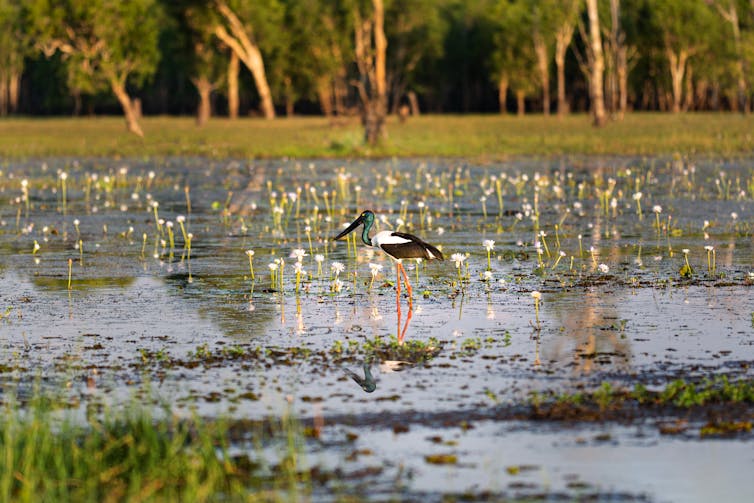
Indigenous Water Reserves
The Northern Territory, Queensland and Western Australia have each introduced Indigenous water reserves into water allocation plans.
Water allocation plans define the consumptive pool – that is, how much water can be taken each year for consumptive purposes, such as for drinking supplies or irrigation.
There are at least 19 Indigenous water reserves across Northern Australia. This approach has not yet been adopted by other Australian states and territories.
A major limitation of Indigenous water reserves is their narrow scope. In the NT and WA, their overall purpose is to provide economic opportunities for Indigenous people. Queensland reserves generally provide water to help Indigenous people achieve both economic and social aspirations.
A focus on using water for commercial purposes risks other crucial items – such as ensuring sufficient water for Country and to maintain ecosystem health – falling off the agenda, upholding the unacceptable status quo.
This is what Indigenous organisations have said repeatedly, and what our new policy brief reflects: that water for economic development is just one of many aspects to overcoming water injustice.
A Market-Based Lens
There are two main reasons Indigenous water reserves should not be viewed solely through a market-based lens.
First, water in Indigenous reserves in the Northern Territory are only distributed when there is surplus water. The Central Land Council has stated:
in the majority of cases where the SAWRs [Strategic Aboriginal Water Reserves] should be available, the water resources have been fully or over-allocated and there is no water available for SAWR.
In other words, if there is no water surplus left, as determined by Australian governments, then the reserve is considered “notional”: in reality, non-existent.
Second, land tenure rules and regulations are being used to determine the allocation to Indigenous water reserves.
For example, in the Northern Territory, Indigenous holders of non-exclusive possession native title (that is, native title that co-exists with other forms of land tenure, such as a pastoral lease) are ineligible for water reserves.
This splits native title holders into those with water and those without, based on native title rules, creating an unfair division.
Arbitrary rules about who is eligible for Indigenous water reserves does not respond to the injustice of land and water stolen or forcibly acquired from Indigenous nations. In response to this failing, the Northern Land Council noted it:
has been disappointed that one of its key recommendations throughout the development of the [Aboriginal Water Reserve] was not adopted through the legislative amendment – that is, that eligibility should be broadened to encompass Aboriginal people and communities who have neither land rights nor exclusive native title.
Are There Any Benefits?
In contrast with top-down and arbitrary water allocation planning policies, water reserves can also be established through Indigenous land use agreements. A negotiated agreement between Indigenous groups and Australian governments, potentially has more scope to respond to past injustice and deliver meaningful benefits.
This is because it’s a negotiated settlement intended to be between partners, rather than a top-down “one size fits all” process for an entire state or territory.
One possible example is the Yamatji Southern Regional Corporation (YSRC) lease of water to sand mining company Perpetual Resources in 2020. It is the first agreement between the WA government and an Indigenous nation to establish a negotiated access to water with an Indigenous Water Reserve.
Chief executive of YSRC, Jamie Strickland, has stated:
This agreement is the first of its kind and demonstrates how our Strategic Aboriginal Water Reserve can generate opportunities and economic benefits for the Yamatji Nation.
Missing Details
An holistic approach is needed to ensure water rights support living waters, the environment, and spiritual and cultural connections. If Indigenous water reserves are to benefit Indigenous people, then governments must listen and negotiate in good faith with Indigenous nations.
When applied in water allocation plans, Indigenous water reserves must be part of a cohesive and comprehensive approach – one that delivers sovereignty for water to Indigenous nations and responds to the gross injustice and lie of aqua nullius.
Importantly, Indigenous water reserves need to be one part of a bigger-picture approach to water justice if aqua nullius is to be overturned.![]()
Kat Taylor, Water Justice Hub Research Fellow, Australian National University; Anne Poelina, Adjunct Professor and Senior Research Fellow, University of Notre Dame Australia, and Quentin Grafton, Australian Laureate Professor, Crawford School of Public Policy, Australian National University
This article is republished from The Conversation under a Creative Commons license. Read the original article.
4 creepy crawlies you’ll see more of this wet summer – and one iconic beetle you’ll probably miss
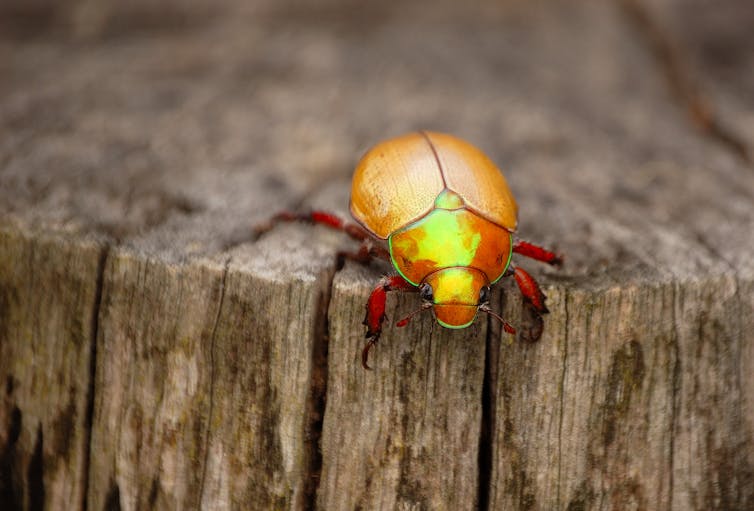
For Australians, memories of childhood Christmas often include gifts, prawns and shooing uninvited buzzing guests away from the pavlova.
But have you ever wondered why the air is full of bugs some years and almost empty in others? Insect populations boom and bust frequently.
This year is our third successive La Niña, and a wet summer is forecast yet again for Australia’s east.
Wet, warm weather is ideal for many of the insects, spiders and slugs that share our homes and gardens. That means we’re likely to have a very buggy Christmas.
Aren’t All The Insects Dying?
As we heat up the planet and take over natural areas, invertebrate species are responding in unpredictable ways. Many species are in trouble: researchers have warned of an insect apocalypse facing flying bugs like wasps, butterflies, and beetles in densely populated Europe.
Subsequent research has drawn less drastic conclusions, and some American researchers claim that population sizes haven’t significantly changed overall, with some species booming and others dying off.
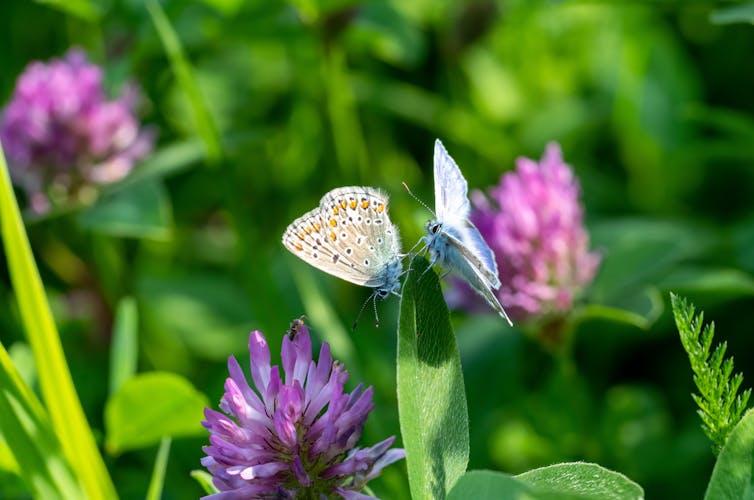
Longer term, climate change and human takeover pose real challenges for many bugs – but not all.
When ecosystems tip out of balance, the most adaptable species find opportunities despite – or because of – unpredictable and changing conditions. Consider the locust swarms vast enough to blot out the sun and threaten crops in many East African nations.
So what should you look for? Here are four creepy crawlies that might arrive at your place more often this summer.
Huntsman Spiders
Although spiders have shared our houses for thousands of years, huntsmans have rarely been popular roommates. That’s probably because of their heart-stopping habit of skittering across the wall when you least expect them.
Despite this, most of Australia’s 155 huntsman species are shy and rarely aggressive. They generally live solitary lives, although female huntsman spiders will actively guard their egg sacs after mating – and protect the up to 200 spiderlings which hatch from them.
Like many introverts, huntsman spiders prefer the indoors – especially in bad weather, when they like to enter houses and cars to get out of the rain. This is actually good news, believe it or not. Having huntsman spiders in residence means you’ll have less cockroaches and mosquitoes.
So be ready not to freak out. With recent heavy rains and the predicted influx of roaches and mozzies this summer, you can expect to see a few more eight-legged off-lease roommates than usual.

Mole Crickets
Nicknamed the platypus of insects, mole crickets look like several different creatures jammed together. Seeing one aboveground is always a shock. The shovel-like forelegs. The yabby-like carapace. The surprising size of it.
Don’t panic. These minibeasts are meant to be here. They live happily across Australia, preferring life beneath well-watered vegetation. They use their leg-shovels to dig tunnel networks where they can lay their eggs. After young adults dig their tunnels, they come to the surface in spring to find a mate.

So why are you likely to see them in summer? Rain. When heavy rain hits, underground creatures have to activate contingency plans. Tunnels and rain don’t mix. For mole crickets, that means digging upwards through sodden ground and clambering across the surface looking for higher ground.
You’ve probably heard the male mole cricket’s persistent chirping on rainy evenings as he looks for a mate. Their characteristic call is so loud it’s sometimes confused with a frog. The powerful sound is due to clever engineering. Mole crickets sculpt a horn-shaped burrow to maximise their noise. Think of it as building an underground bugle.
European Earwigs
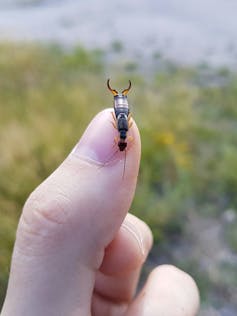
European earwigs are everywhere in Australia’s temperate south – even though they’re not from here. These invasive pinchy bugs from Europe are unmistakable, with elongated abdomens topped with forcep-like pincers. Most of our 85 earwig species are natives, but you’re likely to see the European variety.
Their name may come from the Old English phrase “ear wiggler”, which in turn comes from an enduring belief that earwigs invade people’s ears when you sleep. Thankfully, this is false. When researchers tested this story, they found earwigs weren’t interested. It’s actually cockroaches that can sometimes get stuck inside our ears.
While earwig pincers can hold onto human skin, they don’t usually hurt. The pincers are used for courting, defence, and catching prey. Earwigs are omnivores, eating plants and critters.
Rainy winters boost earwig numbers, as the increased rainfall keeps burrows moist. This helps their eggs and nymphs to survive and ensures plenty of plants for them to eat.
This winter was our wettest nationwide since 2016. This means conditions are perfect for an earwig bonanza. Researchers say grain-growing areas outside Melbourne and Adelaide are prime real estate for earwig expansion.
Red Triangle Slugs
These gaudy gastropods live happily in urban vegetation along the Queensland and New South Wales coastline. Australia’s largest native land slug can be cream, greyish-green, yellow or orange-red, but you’ll know them from the distinctive red triangle shield on their back. While it might not look it, this is actually camouflage. It helps these nocturnal slugs blend in with leaf litter.
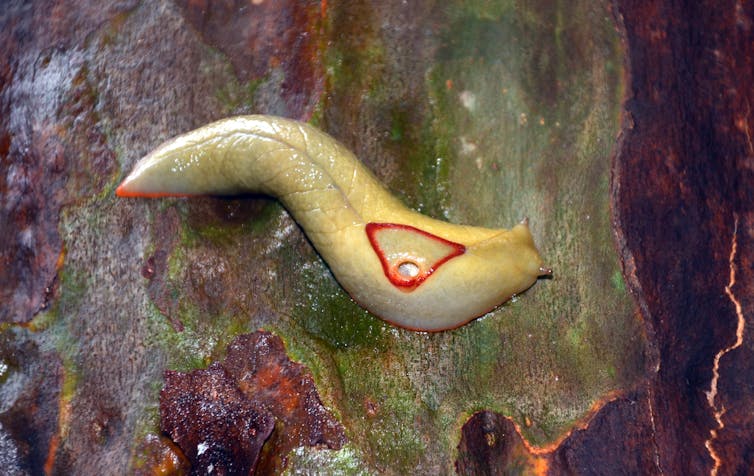
After rain, these slugs come out of hiding and slurp up moisture through their skin, leaving a slimy mucus trail. It’s not just for gliding along – it’s defence. Their mucus acts like a slug superglue, with scientists finding it’s strong enough to stick predators like green tree frogs firmly in place.
They’re already popping up in Brisbane backyards, but there are more to come, given ideal conditions for the growth of the algae these slugs eat.
These four species are set to boom. But what about the iconic Christmas beetle?
Christmas Beetles
If you can remember the 1980s and 1990s, chances are you have fond childhood memories of these metallic beauties clinging to your screen door, or buzzing indignantly as they try to turn themselves right side up on your driveway.
These days, Christmas beetles don’t seem to arrive in large numbers. There are 36 species of these shiny scarab beetles nationwide, but sightings are falling.
We don’t know the full story, but we have clues. Almost one in four of Australia’s native eucalyptus species are now threatened with extinction, with some populations dropping by half due to land clearing and urbanisation.
That’s a major problem for Christmas beetles. Their larvae depend on plant roots and the adults emerge after thunderstorms to snack on eucalyptus leaves. Two key species they like to eat – yellow box and fuzzy box – have just been listed as threatened.
Without intervention, such sightings will become increasingly rare.
If you do see Christmas beetles this summer, you can help by logging your sighting on the iNaturalist beetle count to help scientists understand where these Christmas favourites are still visiting. ![]()
Erin Siostrom, Associate Lecturer in Science Education, University of the Sunshine Coast
This article is republished from The Conversation under a Creative Commons license. Read the original article.
When we swim in the ocean, we enter another animal’s home. Here’s how to keep us all safe
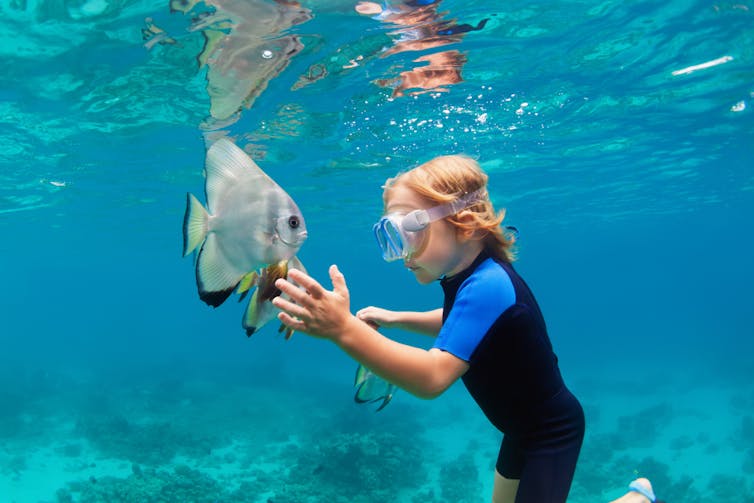
Every summer, many Australians head to the ocean to swim, surf, sail, kayak, and walk along the beach.
But humans are not alone when we use the ocean. Fish, seals, dolphins, sharks, jellyfish, turtles, stingrays, cuttlefish, and birds often swim alongside us. When we enter the ocean we become part of an entangled web of animal relationships.
Encountering animals when we swim and surf in the ocean is fun and exciting. But sharing the water with animals also comes with the risk of stings, bites, frights, and injury to us. It can also bring harm to ocean wildlife.
By educating ourselves about marine life, humans can minimise risks to ourselves and the animals who call the ocean home.
We Can Frighten Animals – And They Can Scare Us
Despite how vulnerable we feel when swimming, our presence in the ocean can frighten or harm an animal. Animals may see us as a predator and alter their behaviour accordingly.
Fish, birds and small stingrays might swim off, and turtles might delay rising to the ocean’s surface to breathe.
Not all animals are frightened of humans. It’s a highlight when curious dolphins swim and play around us. But dolphins can attack humans or other animals if they feel threatened - for example when feeding or protecting their young.
Humans can also be scared of animals in the water. This fear drives the use of shark nets off beaches or, less commonly, shark culls.
Shark nets are controversial – not least because they can entangle and kill animals including turtles, non-target sharks, stingrays, and whales.
Even more controversial are shark culls, such as those planned for Western Australia in 2013 after a spate of fatal shark attacks. The plan was later abandoned, after it was criticised as cruel and lacking scientific basis.
Killing or harming ocean animals so humans can have fun in the water raises all sorts of questions and moral dilemmas. So how else might we keep ourselves safe in the ocean?
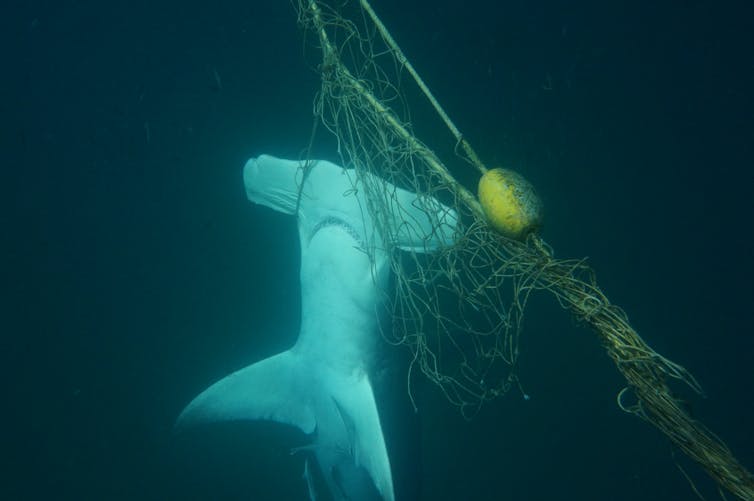
Learn About Ocean Animals
Learning about what ocean animals you might encounter – and when – can help keep both people and animals safe.
Some animals are present year-round. But, as whale watchers and fisherman are well aware, many animals are more active in a particular seasons or only appear at certain times of the year.
For example, in cooler months in the waters off northern Australia, manta rays are most active. Leopard sharks, meanwhile, appear during warmer months in southeast Queensland and northeast New South Wales.
And from November until May or June, a variety of marine stingers can be found in the coastal waters of Far North Queensland. These include the potentially lethal box jellyfish.
Informing ourselves means we can take measures to keep safe. For example, people swimming in North Queensland in the warmer months are advised to swim at netted beaches, and wear wetsuits or stinger suits. Entering the water slowly also gives some marine stingers time to move away.

When it comes to sharks, there are growing calls to adopt non-violent approaches to minimise risks to humans. This could include public education on, for example, links between fish seasons and shark activity.
Educating ourselves about ocean animals also helps us protect them.
Shorebirds, for instance, nest in spring and summer. This is prime beach time for people, too. Shorebird nests are shallow and vulnerable, and birds will often abandon their eggs when humans are around. Dogs and 4WDs pose an even bigger threat.
If we know we’re sharing a beach with nesting shorebirds, we can take steps to ensure their safety, such as keeping our dogs on a leash and avoiding using dunes and other common nesting areas.
The annual migration of whales and their calves up and down our coasts is an exciting time to visit the beach and, if you’re lucky, to view a splashy show of breaching or water slapping.
But if you plan to go sailing or kayaking, be aware of rules around interacting with whales. They law states they can approach us, but we must not get too close to them.
If you’re not an experienced ocean user, or don’t know about the animals living in a particular place, talk to someone who is informed.
If you use beaches patrolled by surf lifesavers they can give you information about animals that might be present that day, such as sharks or jellyfish. They can also tell you about ocean conditions such as rips, currents and water quality.
If you do suffer a painful bluebottle or jellyfish sting, surf lifesavers may also provide basic treatments such as dousing the sting with hot water or vinegar.
If you’re planning to swim or surf at unpatrolled beaches – especially if they’re remote – pack a basic first aid kit including sunscreen, vinegar and instant ice packs.
And remember, enjoying time in the ocean with other poeple is safer than swimming alone.

Ensuring Everyone Enjoys The Encounter
Despite the risks, most human encounters with animals in the ocean are exciting and positive.
Learning about the kinds of animals you might come across, as well as the best ways to interact with them, will help keep you safe – and make sure its a good experience for the animals too.![]()
Rebecca Olive, Vice Chancellor's Senior Research Fellow, RMIT University
This article is republished from The Conversation under a Creative Commons license. Read the original article.
How to feed your garden birds if you want to attract and support native species

As vegetation is removed to make way for urban development, wild species experience a dramatic loss of habitat, making it more difficult for city dwellers to interact with wildlife.
Studies show a lack of connection to nature might lead to anxiety and depression for people in cities. Birds are among the most accessible and aesthetically attractive connection points. Hence, thriving bird communities in cities can have a positive effect on people’s health and wellbeing.
Feeding birds is popular in Aotearoa. About half of New Zealand households feed birds in their gardens, predominately with bread and seed. Unfortunately, this mainly attracts introduced grain-eating species such as house sparrows, starlings, blackbirds and spotted doves. They are likely to compete for space and habitat with native birds, which feed on invertebrates, flower nectar, fruits or leaves.
Attracting Nectar-Feeding Birds
Sugar water serves as an alternative supplementary food for nectar-sipping birds such as tūī, korimako/bellbirds and tauhou/silvereye. It likely benefits native birds over winter when nectar is scarce and it improves their chances of a successful breeding season come spring.
But there are concerns that sugar feeding may lead to an accumulation of pathogens, create health problems and make birds dependent on supplementary feeding. It may also reduce pollination and seed dispersal by reducing bird visits to native plants, and put birds at greater risk of predation.
Our study is the first in New Zealand to determine how sugar water feeding affects backyard bird communities. We explored which birds are visiting and how they interact with each other as well as their overall physical health.
Using The Right Feeders
We analysed 990 responses from an online New Zealand-wide survey to explore current sugar-water feeding practices. We found a large variety of feeding approaches, but the crucial aspect that affected which bird species visited backyards was the feeder type.
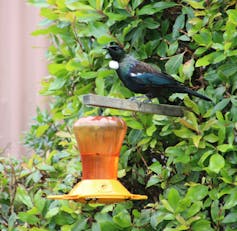
Feeders specifically designed for nectar-eating species were successful in attracting natives, while non-specific feeders (open dishes or simple containers) also attracted introduced birds.
In feeders designed for nectar feeders, the bird must push aside the guard with its narrow bill and protrude its tongue under the feeder’s cover to drink the sugar water. Introduced birds (not nectar-feeding specialists) do not have the right-shaped tongues and bills or behaviour to do this and are excluded from using these feeders.
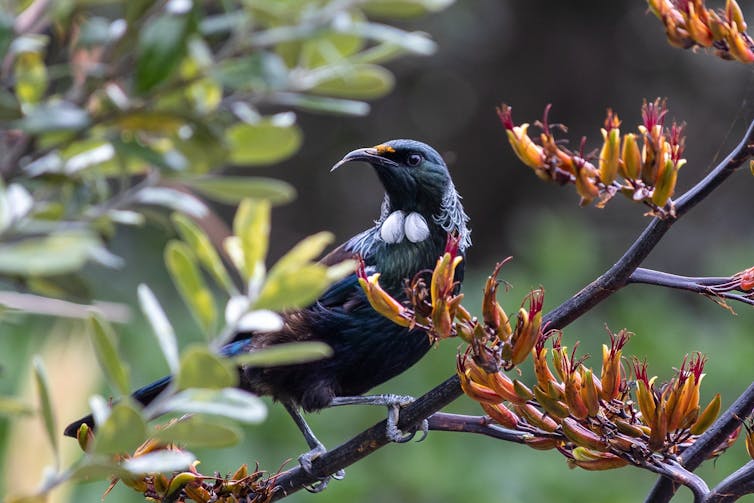
Winter Frenzy
Next, we explored how seasons affected bird foraging behaviour and aggressiveness. In winter, birds visited feeders more often, spent a longer time foraging and were more aggressive to other birds using the feeder. This suggests winter feeding helps survival when natural foods are scarce.
We also observed Auckland tūī in winter in backyards where we experimentally added feeders with either low (half a cup of sugar per litre of water) or high (one cup/litre) sugar concentrations. Tūī spent longer foraging at low-concentration feeders but were more aggressive at high-concentration ones.
This suggests birds must forage on low-calorie solutions for longer to gain energy, while high-calorie sugar water is a fiercely defended valuable source. However, feeder presence did not change the overall number of backyard birds.
Bird Health
Finally, we evaluated how the presence of sugar-water feeders, seasons and climate affected the birds’ body condition and disease prevalence. Similarly to findings from previous overseas studies, individuals had better body conditions in non-feeding gardens than in those that provided a feeder.
But in gardens with feeders, body condition of birds was better in Auckland (milder climate), in summer (warmer temperatures) and at high-sugar concentration feeders (more calories).
Sugar-water feeding was also associated with a higher risk of coccidia infection which can lead to loss of pigmentation, diarrhoea and even kill birds in severe cases. Fortunately, our screening did not detect salmonella in any individuals or feeding stations.
However, in a similar study on backyard feeding in Auckland using bread and seeds, 7% of birds at feeders tested positive for salmonella. This suggests that birds such as house sparrows, which visit feeders with simple designs that can be accessed by most birds, contribute to pathogen transmission risks for nectar-eating birds and, possibly, people.
Recommended Bird-Feeding Guidelines
Based on our study, we make several recommendations:
do not feed bread and seeds to birds, as this only encourages highly abundant introduced species
rather than using open dishes, choose commercially available sugar-water feeders designed for native birds (Tui Nectar Feeder™, Topflite Nectar Nutra feeder™, PekaPeka™) to exclude introduced bird species
provide sugar water only in winter and stop feeding in spring and summer to let birds use natural foods, pollinate plants and minimise the risk of bacterial growth in hot weather
in winter, use about one cup of sugar per litre of water, as we linked this sugar concentration to better bird body condition than lower-sugar solutions
clean all structures used in feeding thoroughly at least two times a week by scrubbing with hot water to minimise the risk of bird disease outbreaks
attach the feeder to a tall post away from trees and fences to minimise chances of predation by cats.
Providing birds with supplementary food is an affordable and appealing way to interact with wildlife. However, it is important to state that supplemental feeding alone is not the solution for urban bird populations.
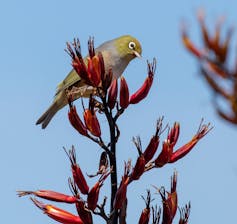
The long-term answer is to transform our backyards and urban parks into bird-friendly habitats. Nectar-feeding birds need protein from insects found on plants and native vegetation provides essential food, shelter and nesting sites.
Clean water baths can help during prolonged summer droughts. But perhaps most importantly, backyard pest control of rodents, possums and hedgehogs is essential if we want to increase native bird numbers and diversity in a way that will benefit both birds and people.![]()
Daria Erastova, Doctoral researcher, University of Auckland; Ellen Hume, Doctoral researcher of social ecological systems, University of Auckland, and Margaret Stanley, Associate professor, University of Auckland
This article is republished from The Conversation under a Creative Commons license. Read the original article.
Climate change is leaving African elephants desperate for water
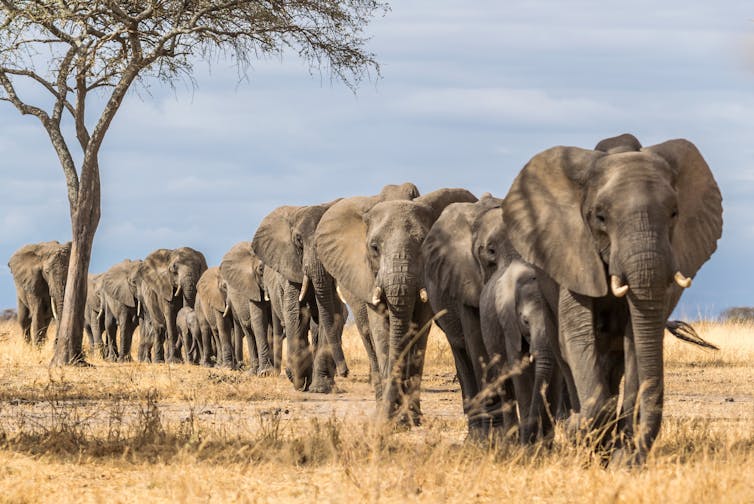
African elephant numbers have dropped from about 26 million in the 1800s to 415,000 today. While this is largely due to European colonisation, poaching and habitat loss, these majestic animals now face another grave challenge.
Climate change is causing droughts in much of Africa to become longer and more severe. This damages elephant habitats and denies them the water they need. Due to their unique physiology, African elephants need hundreds of litres of water each day to survive.
The African savanna elephant is listed as endangered. If the situation doesn’t change, Africa – indeed, the world – may lose one of its most iconic animal species.
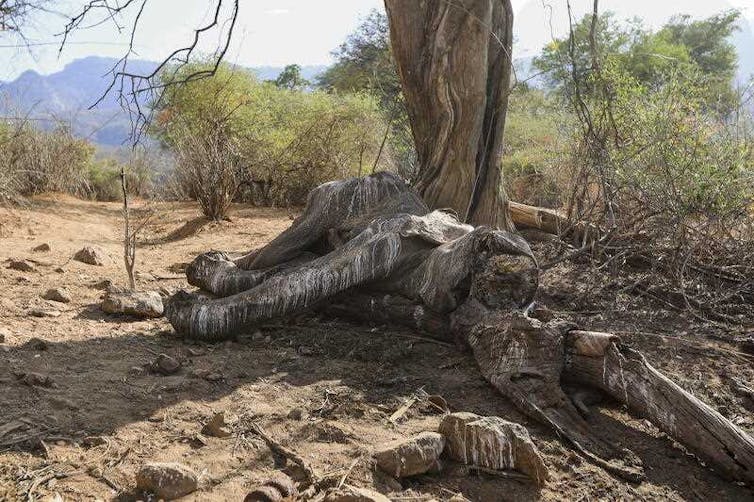
A Tragic Plight
Elephants are not just important for their ecological, cultural and economic value. They are also a keystone species – that is, they help hold ecosystems together. This means their decline has far-reaching consequences.
Many African ecosystems pivot around the lives of elephants. Elephant feeding habits, such as pushing over trees and peeling off bark, can turn woody vegetation into grasslands. This makes room for smaller species to move in. Their digging for water in dry riverbeds creates water holes other animals can use. And as they migrate, elephants help spread seeds in their dung.
Under climate change, long, intense droughts across southern and eastern Africa are escalating. Some have lasted more than 20 years.
The conditions have left many elephants desperate for water. Research as far back as 2003 shows elephants in Zimbabwe were dying during drought. And in 2016, when a drying El Nino weather pattern hit southern Africa, there were reports of more elephant deaths, prompting a local conservation group to drill bore holes to provide relief.
Drought can also reduce the availability of food, causing elephants to starve. It can also mean young elephants die or don’t develop properly, because their parched mothers produce less milk.
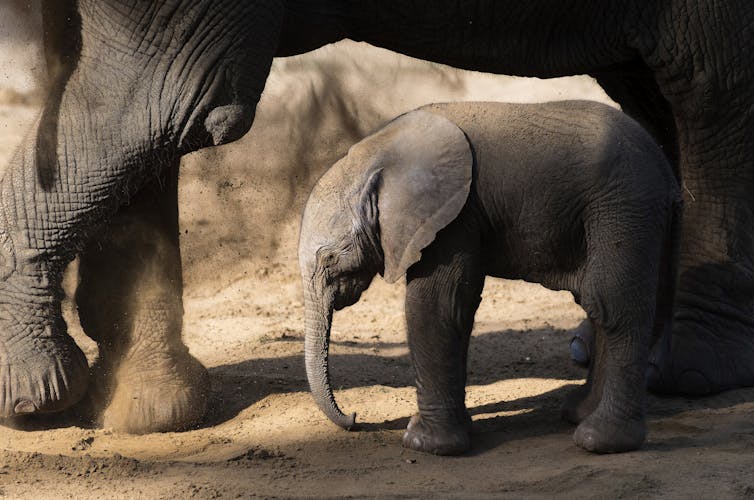
A Unique Physiology
So, why do elephants struggle in drought and heat?
When elephants experience high internal temperatures, it can disrupt the function of cells, tissues and organs such as the liver and cause them to become sick and die.
Humans and other animals also suffer heat stress. But elephants are particularly vulnerable because they can’t sweat it off.
The graphic below shows how heat accumulates and dissipates in elephants.
Heat accumulates through an elephants’ natural metabolism and physical activity, as well as being absorbed from the environment.
But it does not always effectively dissipate. Elephants’ thick skin slows heat loss – and their lack of sweat glands exacerbates this.
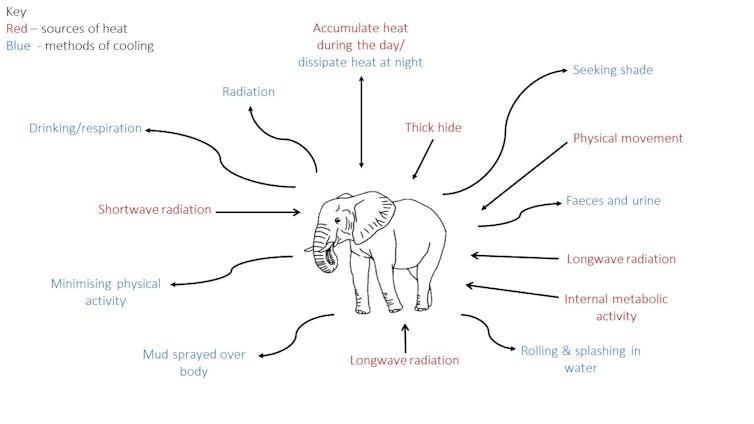
What’s more, elephants are the largest of all land mammals, weighing up to eight tonnes. They also have a large body volume – which generates heat – but a relatively small surface area (their skin) from which to lose this heat.
Water is essential for elephants to cope with heat. They swim and spray their skin with mud and water; the subsequent evaporation mimicks sweating and cools them down.
And elephants cool themselves internally by drinking several hundred litres of water a day.
Let Elephants Roam Free
Creating artificial water sources is a common management intervention when elephants need water. This includes the use of pipes, bores and pumps.
But this measure can be problematic. Sometimes, the water is sourced from supplies needed by local people. And large numbers of elephants congregating around water can permanently damage the local environment and reduce food availability for other animals.
Historically, elephants migrated to water during drought. But the introduction of fenced areas in the landscape has disrupted this movement.
Fences were constructed to mark out colonial land ownership, separate people from large animals and deter poachers.
But as climate change worsens in Africa, elephants and other wildlife must be able to move freely between connected habitats.
Wildlife corridors may provide an answer. These are protected channels of vegetation that enable animals to move between fragmented patches of habitat. Wildlife corridors work well for megafauna in India and the United States and would likely increase mobility for much of Africa’s wildlife.
Introducing more wildlife corridors, especially in southern and eastern Africa, would require removing fences. This change would have repercussions.
Nearby communities – which have not coexisted with elephants since colonisation – would have to adjust to the change. The removal of fences may also lead to an increase in poaching. And letting elephants roam the landscape may make them less accessible to tourists, which could reduce tourism revenue.
But communities have coexisted with elephants in the past. And community-based projects have been shown to reduce conflict between humans and wildlife. In some cases, they’ve also led to lower poaching rates and increased quality of life for communities.
Community management projects, such as in Northern Kgalagadi in Botswana, show how local expertise – drawn from millennia of experience and knowledge – can guide wildlife management. Research has shown successful outcomes – both socially and ecologically – in places where elephants share landscapes with people.
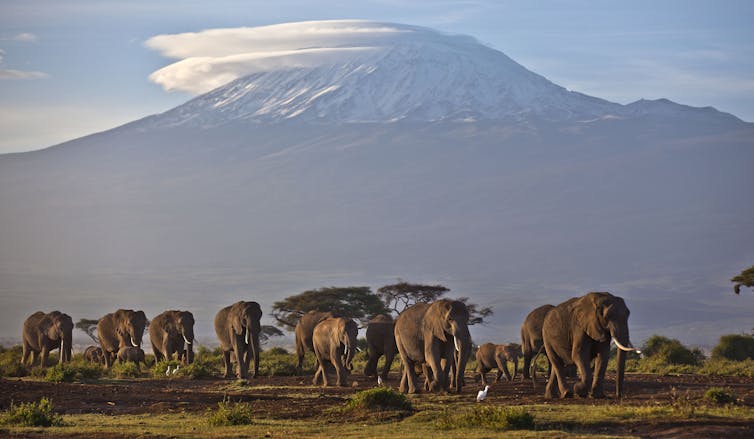
Protecting A Keystone Species
Ensuring African elephants survive drought will increasingly require new conservation strategies, including community-based management. Without this, already dwindling elephant populations will continue to decline.
This would be bad news for the health and stability of natural ecosystems in Africa – and a blow to Africa’s people.![]()
Rachael Gross, PhD Scholar in Applied Conservation Ecology, Australian National University and Rob Heinsohn, Professor of Evolutionary and Conservation Biology, Australian National University
This article is republished from The Conversation under a Creative Commons license. Read the original article.
Pittwater Reserves: Histories + Notes + Pictorial Walks
A History Of The Campaign For Preservation Of The Warriewood Escarpment by David Palmer OAM and Angus Gordon OAM
A Walk Around The Cromer Side Of Narrabeen Lake by Joe Mills
America Bay Track Walk - photos by Joe Mills
An Aquatic June: North Narrabeen - Turimetta - Collaroy photos by Joe Mills
Angophora Reserve Angophora Reserve Flowers Grand Old Tree Of Angophora Reserve Falls Back To The Earth - History page
Annie Wyatt Reserve - A Pictorial
Avalon's Village Green: Avalon Park Becomes Dunbar Park - Some History + Toongari Reserve and Catalpa Reserve
Bairne Walking Track Ku-Ring-Gai Chase NP by Kevin Murray
Bangalley Headland Bangalley Mid Winter
Banksias of Pittwater
Barrenjoey Boathouse In Governor Phillip Park Part Of Our Community For 75 Years: Photos From The Collection Of Russell Walton, Son Of Victor Walton
Barrenjoey Headland: Spring flowers
Barrenjoey Headland after fire
Bayview Baths
Bayview Wetlands
Beeby Park
Bilgola Beach
Botham Beach by Barbara Davies
Bungan Beach Bush Care
Careel Bay Saltmarsh plants
Careel Bay Birds
Careel Bay Clean Up day
Careel Bay Playing Fields History and Current
Careel Creek
Careel Creek - If you rebuild it they will come
Centre trail in Ku-ring-gai Chase National Park
Chiltern Track- Ingleside by Marita Macrae
Clareville Beach
Clareville/Long Beach Reserve + some History
Coastal Stability Series: Cabbage Tree Bay To Barrenjoey To Observation Point by John Illingsworth, Pittwater Pathways, and Dr. Peter Mitchell OAM
Cowan Track by Kevin Murray
Curl Curl To Freshwater Walk: October 2021 by Kevin Murray and Joe Mills
Currawong and Palm Beach Views - Winter 2018
Currawong-Mackerel-The Basin A Stroll In Early November 2021 - photos by Selena Griffith
Currawong State Park Currawong Beach + Currawong Creek
Deep Creek To Warriewood Walk photos by Joe Mills
Drone Gives A New View On Coastal Stability; Bungan: Bungan Headland To Newport Beach + Bilgola: North Newport Beach To Avalon + Bangalley: Avalon Headland To Palm Beach
Duck Holes: McCarrs Creek by Joe Mills
Dunbar Park - Some History + Toongari Reserve and Catalpa Reserve
Dundundra Falls Reserve: August 2020 photos by Selena Griffith - Listed in 1935
Elsie Track, Scotland Island
Elvina Track in Late Winter 2019 by Penny Gleen
Elvina Bay Walking Track: Spring 2020 photos by Joe Mills
Elvina Bay-Lovett Bay Loop Spring 2020 by Kevin Murray and Joe Mills
Fern Creek - Ingleside Escarpment To Warriewood Walk + Some History photos by Joe Mills
Iluka Park, Woorak Park, Pittwater Park, Sand Point Reserve, Snapperman Beach Reserve - Palm Beach: Some History
Ingleside
Ingleside Wildflowers August 2013
Irrawong - Ingleside Escarpment Trail Walk Spring 2020 photos by Joe Mills
Irrawong - Mullet Creek Restoration
Katandra Bushland Sanctuary - Ingleside
Lucinda Park, Palm Beach: Some History + 2022 Pictures
McCarrs Creek
McCarr's Creek to Church Point to Bayview Waterfront Path
McKay Reserve
Mona Vale Beach - A Stroll Along, Spring 2021 by Kevin Murray
Mona Vale Headland, Basin and Beach Restoration
Mount Murray Anderson Walking Track by Kevin Murray and Joe Mills
Mullet Creek
Narrabeen Creek
Narrabeen Lagoon Catchment: Past Notes Present Photos by Margaret Woods
Narrabeen Lagoon State Park
Narrabeen Lagoon State Park Expansion
Narrabeen Rockshelf Aquatic Reserve
Nerang Track, Terrey Hills by Bea Pierce
Newport Bushlink - the Crown of the Hill Linked Reserves
Newport Community Garden - Woolcott Reserve
Newport to Bilgola Bushlink 'From The Crown To The Sea' Paths: Founded In 1956 - A Tip and Quarry Becomes Green Space For People and Wildlife
Pittwater spring: waterbirds return to Wetlands
Pittwater's Lone Rangers - 120 Years of Ku-Ring-Gai Chase and the Men of Flowers Inspired by Eccleston Du Faur
Pittwater's Parallel Estuary - The Cowan 'Creek
Resolute Track at West Head by Kevin Murray
Resolute Track Stroll by Joe Mills
Riddle Reserve, Bayview
Salvation Loop Trail, Ku-Ring-Gai Chase National Park- Spring 2020 - by Selena Griffith
Seagull Pair At Turimetta Beach: Spring Is In The Air!
Stapleton Reserve
Stapleton Park Reserve In Spring 2020: An Urban Ark Of Plants Found Nowhere Else
Stony Range Regional Botanical Garden: Some History On How A Reserve Became An Australian Plant Park
The Chiltern Track
The Resolute Beach Loop Track At West Head In Ku-Ring-Gai Chase National Park by Kevin Murray
Topham Track Ku-Ring-Gai Chase NP, August 2022 by Joe Mills and Kevin Murray
Towlers Bay Walking Track by Joe Mills
Trafalgar Square, Newport: A 'Commons' Park Dedicated By Private Landholders - The Green Heart Of This Community
Tranquil Turimetta Beach, April 2022 by Joe Mills
Turimetta Beach Reserve by Joe Mills, Bea Pierce and Lesley
Turimetta Beach Reserve: Old & New Images (by Kevin Murray) + Some History
Turimetta Headland
Warriewood Wetlands and Irrawong Reserve
Whale Beach Ocean Reserve: 'The Strand' - Some History On Another Great Protected Pittwater Reserve
Wilshire Park Palm Beach: Some History + Photos From May 2022
Winji Jimmi - Water Maze

Summer Cicadas – The Noise You Can Hear Coming From Our Local Trees Right Now
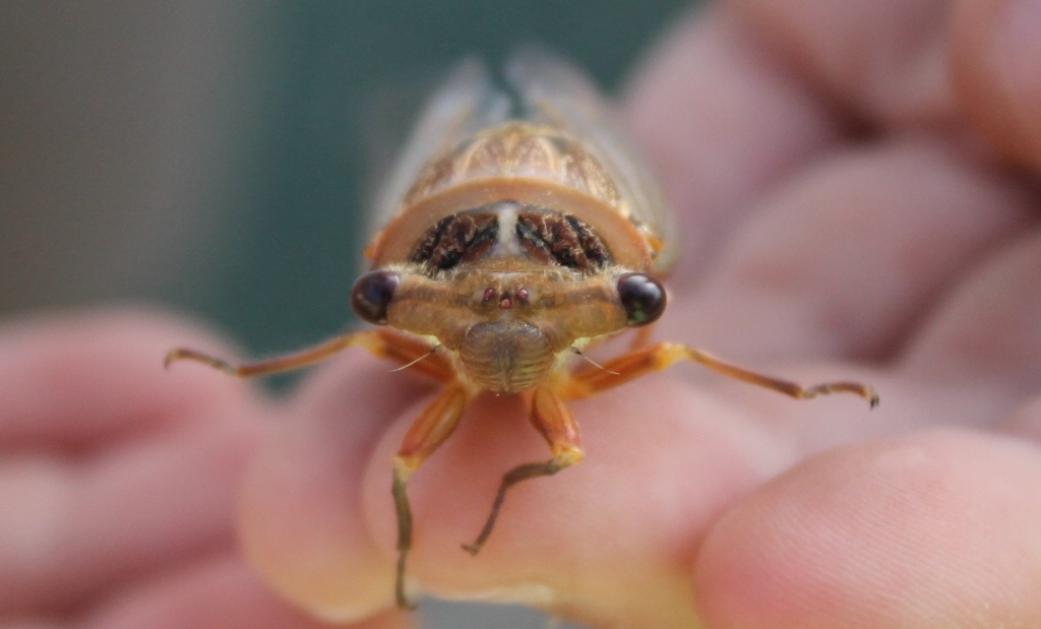
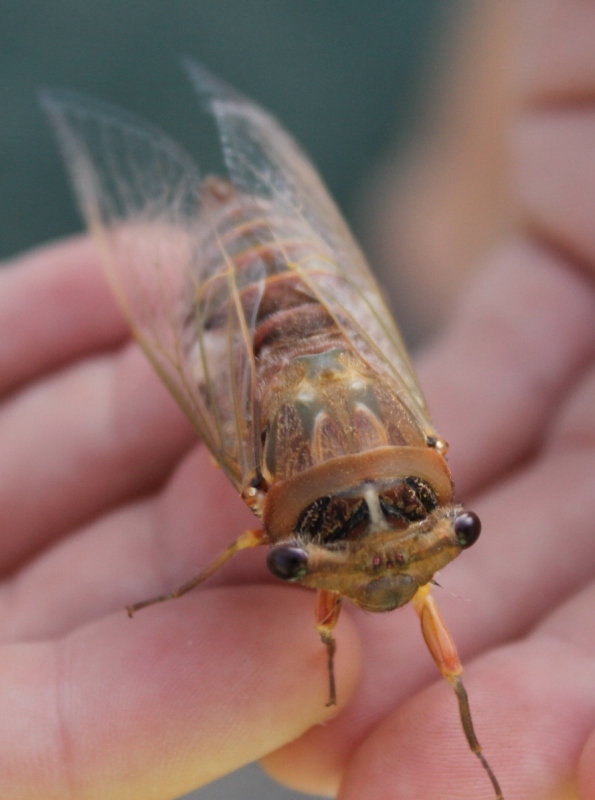 Since at least 1840 our resident cicadas have been described for their song, or noise as some prefer to call. This is an eternal symphonic orchestra played during Summer and quite loud at present.
Since at least 1840 our resident cicadas have been described for their song, or noise as some prefer to call. This is an eternal symphonic orchestra played during Summer and quite loud at present.
For our first Issue of 2023 we'd like to share some old insights written for youngsters with you so you can see what those noisemakers look like.
Disappearance of Cicada (Locusts).
A LOCAL contemporary says that the noisy insect generally known as "locust" or "Australian Canary" is being rapidly exterminated, and suggests that the cause is to be found in the English house sparrow pest. We have noticed that during the present summer the terrible song of the locust in the suburbs of Sydney has been unusually absent; but we have frequently observed, in years previous to the insane introduction of the irrepressible bird, similar absence of the handsome but noisy locust during several, not successive, summers. We do not think the sparrow is accountable for the diminished noise, although he does at times annoy the insect and in play destroys some few individuals. We cannot give a reason for the absence or diminished number of "locusts" during occasional summers, but we have observed Summers when not even the song of a solitary cicada was to be heard. During the present summer the song has been much more rare than usual, still it has been heard. Whether the peculiar state of the weather in the spring months of some years affects the number, or there are certain cycles during one year of which the eggs, larvae, or grubs remain dormant under ground, we cannot say, but we incline to the former as the cause of diminished numbers, and the latter of the total absence of the characteristic songster. Disappearance of Cicada (Locusts). (1884, March 8).Australian Town and Country Journal (NSW : 1870 - 1907), p. 19. Retrieved from http://nla.gov.au/nla.news-article71009215
Although we found instructions dated from 1838 on ‘Of the Code of Directions accompanying the., Correspondence between the Trustees of the British Museum and Lord Glenelg. DIRECTIONS FOR COLLECTING ZOOLOGICAL SPECIMENS.’
For collecting and preserving cicadas in Tasmania, it is our children who have been ascribed as the authors of the many names we have for species of cicada in Australia, and rightly so. Who did not turn over rocks when young to dance away from scorpions, or squat over an ants nest to watch that fervid activity? Who does not, still, catch their breath a little at a lilting by butterfly and, as they grow in years, know what the sight of each in time in each season signifies?
Black Princes(Psaltoda plaga), Yellow Mondays, Green Grocers (called ‘Green Monday’ and ‘Green Tuesday’ earlier on, Blue Moons, (Cyclochila australasiae), Cherrynose(Macrotristria angularis), Floury Baker(Abricta curvicosta) Redeye (Psaltoda moerens) and Double Drummers(Thopha saccata) – what wonderful names to describe the colouring and variations as much as perhaps when and where they were first discovered by little hands.
Ancient cicada myths and legends
To the ancient Greeks the cicada symbolised resurrection, rebirth and immortality and is mentioned as being sacred to the ancient Greek sun god Apollo. Homer mentions cicadas in the Iliad around 900 BC and compares the discourse of "sage chiefs exempt from war" to the song of the cicada.
Ancient Greeks and Chinese made a habit of keeping male cicadas in cages for the pleasure of hearing them sing. One Greek ode to the cicada says: "We call you happy, O cicada, because after you have drunk a little dew in the treetops you sing like a queen".
Cicadas also had a powerful effect on artists as they feature on numerous coins both before and after the time of Christ. A number of beautiful gems have also been found from around 300 BC carved in the likeness of the cicada. The cicada's emergence from the earth was a powerful symbol for ancient Romans with members of the nobility taking to wearing a gold brooch featuring a cicada to hold back their hair.
In Taoism the cicada is the symbol of the hsien, or soul, disengaging itself from the body at death. Cicadas also feature in Japanese carvings on small medicine boxes and they are mentioned in ancient Hindu law as long ago as 200 BC in India.
CICADA TIME.
(BY CANOPUS.)
Cicada time is rapidly approaching, and soon their shrill song will be ringing out from the gums on a sunny day. Children of Australia have conspired to call the cicadas "locust," but it belongs to a totally different order, and is quite a different creature from the grasshoppers and true locusts.
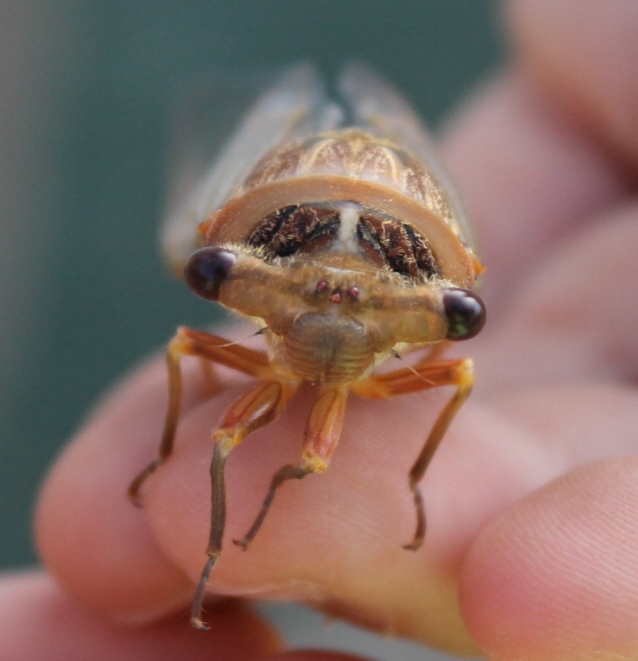 The cicada has a most interesting life history. The eggs are laid by the female during the summer in a thin dry twig. She is provided with a peculiar ovipositor at the end of the abdomen; it is toothed, like a double-edged saw, and is just over a quarter of an inch in length. With this the female punctures the wood, sawing It until the requisite depth is reached. Then the eggs are deposited. A series of these punctures is made, and as the cicada follows the sun while at her work, the punctures are usually arranged in a spiral track around the twig.
The cicada has a most interesting life history. The eggs are laid by the female during the summer in a thin dry twig. She is provided with a peculiar ovipositor at the end of the abdomen; it is toothed, like a double-edged saw, and is just over a quarter of an inch in length. With this the female punctures the wood, sawing It until the requisite depth is reached. Then the eggs are deposited. A series of these punctures is made, and as the cicada follows the sun while at her work, the punctures are usually arranged in a spiral track around the twig.
When the eggs hatch, which they do in a month or two, according to the weather, the young cicadas are small creatures, somewhat resembling fleas. They drop to the ground, and burrow underneath, staying there until ready to assume their final form. The Australian cicada is supposed to spend about three years underground in this way, but there is one species in America whose subterranean period is supposed to last for no less than 17 years
As an engineer, the cicada is at the head of the profession In the insect world. Its tunnel leads down to the root of a tree, and this supplies It with food and moisture. As the Insect grows its underground chamber is enlarged, and at length it changes to a pupa. At the end of the pupal period it begins to bore upwards to the ground surface, kneading the loose soil which it has dug away into a mud with moisture from its body, and forcing this into the earth at the sides of the tunnel. Thus, when the pupa emerges, the entrance to the tunnel appears as a clean hole, without debris at the sides. These holes are often visible in hard tracks through bush country.
The pupa usually emerges at night, for the fierce sunlight is at first too powerful for eyes long used to the darkness underground. Having left its former home, the insect, still in the pupal condition, slowly makes its way to a neighbouring tree trunk, and climbs up for a short distance When the warmth of the day arrives, the hard skin at the back of the wingless pupa splits, and through the opening the winged cicada slowly draws itself out from its prison. The wings at first are more shapeless, flabby muscles, but after an hour or two they become firm and transparent, and the cicada flies off to enjoy the brief period of life remaining to it.
The song of the cicada is produced from two chambers or soundboxes, one on each side of the body behind the wings. It is only the male insect which sings; the female is silent.
The cicada has for long been looked upon as a typical example of light-hearted idleness. Is there anyone who has not heard the fable of the poor cicada, starving in winter, who begged for food from the industrious ant, and was reproved for not having laid in a store for the cold months. In sober fact, the real position is rather the reverse: in the hot summer, when the ants are unable to obtain moisture from the ground, they gather around the female cicada as she punctures the trees during her egg-laying, and eagerly sip the drops of sap which ooze from the incisions. And long before the cold of winter arrives the cicada is dead.
It is curious to note that the ancient Greeks kept cicadas in cages, as we do canaries, for the pleasure of listening to their song. CICADA TIME. (1925, November 14). The Sydney Morning Herald (NSW : 1842 - 1954), p. 11. Retrieved from http://nla.gov.au/nla.news-article16254966
THE CICADA.
The air is vibrant with the song of the Cicada. We do not half appreciate this wonderful little creature. He is the chief Instrument In our summer symphony, yet. Like every prophet, he has no honor in his own country. For many years he works underground. For one brief summer he flutters in the sun— If he is lucky enough to escape the evil machinations of the boy. He does no one any harm, carries no germs, does not bite or sting or scratch, yet. because of his little musical legs and wonderful abdominal drum, he is caught and forced to sing out of tune and out of joint.
Certainly he has his little day. Were not the ancient Greeks so attached to cicadas that they used to fasten golden images of them in their hair? Said to live on dew, and addressed by many endearing names. 'the Nightingale of the Nymphs' and 'the Sweet Prophet of the Summer.' Cicadas were favourites of every Grecian bard, from Homer to Theocritus. A Great story tells of two rival musicians contending upon the harp. A cicada, flying to the most artistic, sat upon his instrument, supplied the place of a broken string, and so secured to him the victory. Perhaps the ancient Greek cicadas had gentler voices than ours, or was It the poetical imagination that heard in their song the music of the harp? The Poets of the South of France have the cicadas as their badge, with the motto 'The sun makes me sing.'
Only the male insect can be heard. Isn't he described as the happiest and most Innocent of creatures?
'Happy the cicadas' lives.
Since they all have voiceless wives.'
THE CICADA. (1911, December 2). Evening News (Sydney, NSW : 1869 - 1931), p. 8. Retrieved from http://nla.gov.au/nla.news-article115290845
_________________________________________
A Cicada Story and Poem for Children
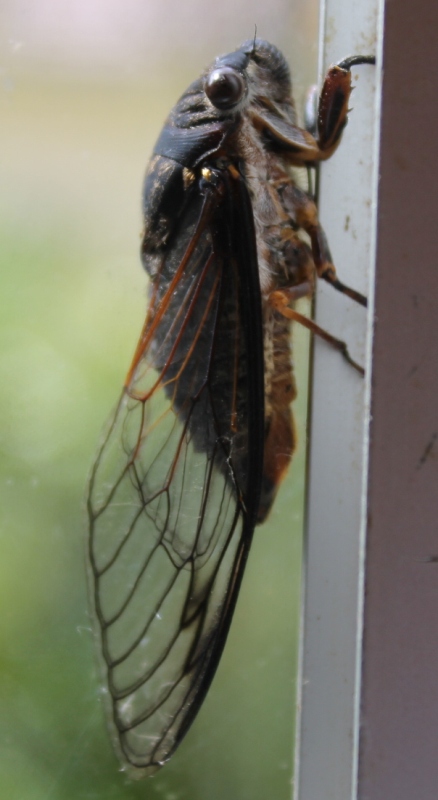 THE CICADA CATCHERS.
THE CICADA CATCHERS.
By Mary Fuller.
(This is a story specially written for the Little People's Page by one of your own. I hope you will like it, and that she will often write another.)
It was early morning in the bushlands, with the sun just peeping through the gum leaves. It was that magic hour, when the indescribable fragrance of Australian plants fills the balmy air, when the breeze is delightfully fresh and invigorating, and when in shady nooks tiny sparkling dew-drops hang on leaf and petal. In such a sheltered nook under a clump of Christmas bush lay Petals and Floret on their moss beds. Mr. Kookaburra suddenly broke into a loud chuckle. Petals and Floret awoke from their slumbers and immediately sprang out of their soft mossy couches.
After bathing in the dew on the grass blades the little fairies put on their best dresses, for they were going .to spend the day with Gum blossom and Honeydew. But as their friends lived high up in Leafy-avenue with the Gumnut babies and the beetles and bees, the two little fairies decided to wait for a 'cicada-bus.' In a few minutes a big cicada flew down to 'them, and Petals and Floret jumped on to his back. He spread his glittering wings, and soon they were speeding through the leaves and blossoms till they arrived at Greysten-street, where the cicada-bus stopped.
They climbed off and ran along to the cluster of blossoms where Gumblossom and Honeydew lived. Presently they were sitting around with Lacewing, Mr. Swallowtail, King Beetle, and many others, who were present as guests. The fairies all sipped nectar and exchanged news, and were spending a very pleasant time with Gum blossom and Honeydew, when suddenly something heavy flew past their branch and fell with a thud on the ground.
'Nearly had him, Tom.'
'Give us another, and I'll try again.'
'No, I'll climb up and get him.'
These were a few of the remarks that floated up to the little fairies who had been so rudely disturbed.
'I wonder who they are, and what they want,' Petals whispered, timidly.
But King Beetle knew.
'They are boys,' he replied.- 'And they want your cicada-bus'.
Gumblossom sent a little flower-beetle to warn the cicada, but he returned in a minute squeaking:
'Oh! there's something big and fat coming up Iron-bark Parade.'
Presently the fairies heard the loud and persistent 'gurk-gurk' of the cicada bus, mingled with the triumphant shouts of Tom.
‘Hooray, Jack, I've got him — a double drummer.'
'Come down and let's see him,' shouted back Jack.
So Tom descended with the cicada-bus in his pocket, and the fairies gathered round again to discuss the strange happenings.
'Oh, dear! There won't be any buses left soon,' said King Beetle. 'Every week the boys come to this valley to catch them, but I've thought of a good plan to punish them now.'
So King Beetle set abut his plan to punish the bad boys. He sent Mr. Swallowtail to tell all the cicadas on the surrounding gums to commence shrilling at once.
'My word, Tom'! Look at that big greengrocer!'
'And here's another brown squeaker!' yelled Tom.
'Oh, bother,' grunted the perspiring Jack after a while. 'Let's have a rest.'
'Righto,' answered Tom. So they sat down on the moss near Petal's and Floret's beds. That was just as the fairies had wanted.
'Come on,' whispered Floret, and they crept nearer to the boys, sprinkling a strong, drowsy perfume, made from scented ti-tree, as they moved.
'It's nice and comfy here,' said Jack.
'Rather,' answered Tom quite drowsily, and before they realised it they were asleep. '
'Right turn,' ordered Commander Bull Ant to his battalion.
'Halt,' as they reached the boy's boots.
'Single file,' and they crawled one by one along their legs.'
'Buzz-buzz,' exclaimed Billy Blue Wasp.
'This way,' as half-a-dozen blue wasps landed on Tom's and Jack's shoulders.
'Szz-z-z,' piped a swarm of mosquitoes as they settled on their coat sleeves.
'Help!' squealed Tom, 'There's ants on my legs!'
'Oh, gee!' roared Jack. 'A wasp's on my neck.'
And the boys jumped round and yelled like mad things.
‘I wonder why they attacked us/’ sighed Tom, but before Jack could suggest a reason a tiny voice piped: 'And I wonder why you took our cicada buses?!’
'What!' Tom began, when Jack chimed in, 'Oh! those locusts!'
'Because everybody has them, and those bush ones squeak awfully well. Who are you, anyway?'
'I'm King Beetle, and these are my subjects. We ride on the cicadas, and how would you like a giant to grab the buses out of your streets?'
'It would be pretty rough,' agreed Tom. 'But we didn't know,' and he transferred the unfortunate cicadas from his pockets to the tree.
Tom and Jack returned home wondering whether it was true or a dream, but they brought no 'double drummers' with them. And they never, went to the bush to catch locusts again, for the simple reason that there were too many bull-ants and wasps there. THE CICADA CATCHERS. (1925, June 25). Freeman's Journal(Sydney, NSW : 1850 - 1932), p. 46. Retrieved from http://nla.gov.au/nla.news-article116792077
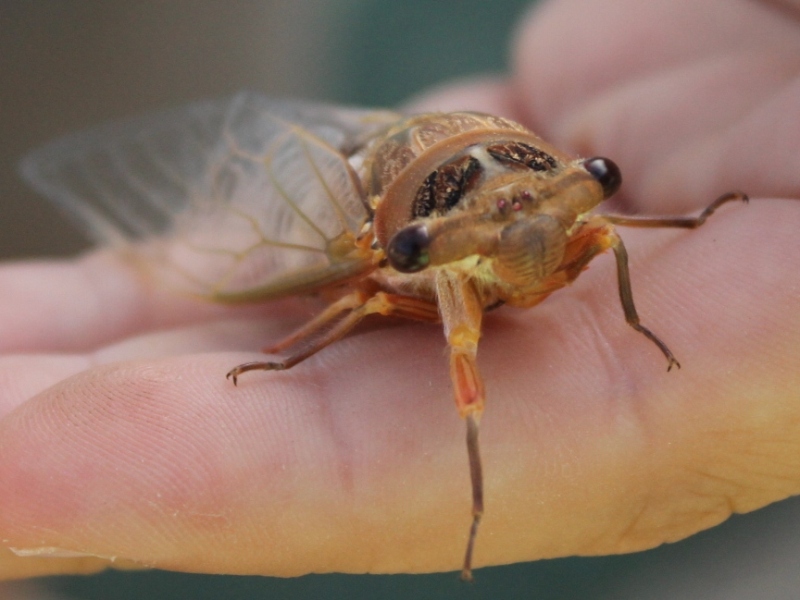
The Children's Page
CONDUCTED BY ERICA
Goody Gossamer's Rhymes.
THE CICADA ORCHESTRA.
When the gum leaves all hang drooping,
And every bird is still,
There comes from each leafy covert,
A droning loud and shrill.
'Zum, zum, zum, I'm a Floury Baker!
Hark to my double-drum;
I can drone by the hour with ceaseless power,
And a zum, zum, zum, zum, zum.'
The hot air seems to quiver
Beneath that steady drone,
And aching heads grow wearier,
With that ceaseless monotone;
"Zum, zum, zum, I'm a real Greengrocer!
Hark to my double drum;
I can make it go for an hour or so,
With a zum, zum, zum, zum."
When the still, hot day is over,
And the west wind drops at length,
The loud cicada chorus Wakens to double strength:
"Zum, zum, zum, I'm a Yellow Monday!
Hark to my double drum;
I can make it drone in its monotone,
With a zum, zum, zum, zum, zum.'
As the slow, slow hours are dragging
Through the hush of a still, hot night;
The full bush band keeps playing,
Right up to the morning light.
"Zum, zum, zum, I'm a Black Prince gorgeous!
Hark to my double drum;
All the long night through I shall play to you,
With a zum, zum, zum, zum, zum."
From the first grey light of the morning,
Till the sun sinks down in the west,
And all through the long night-watches,
The droning knows no rest:
"Zum, zum, zum, I'm a Floury Baker;
Zum, zum, zum, I'm a fat Greengrocer;
Zum, zum, zum, I'm a Yellow Monday;
Zum, zum, zum,
I'm a Black Prince gorgeous.
And each has a double drum.
So with ceaseless tone we just drone, drone, drone,
With a zum, zum, zum, zum, zum."
The Children's Page. (1926, November 18). The Catholic Press(NSW : 1895 - 1942), p. 46. Retrieved from http://nla.gov.au/nla.news-article106276154
References:
1. Owen Craig. Summer of singing cicadas. ABC Science. 17th February, 2001. Retrieved from: http://www.abc.net.au/science/articles/2001/02/17/2822486.htm
CONTINUATION Of the Code of Directions accompanying the Correspondence between the Trustees of the British Museum and Lord Glenelg. (1838, April 13). The Hobart Town Courier(Tas. : 1827 - 1839), p. 4. Retrieved from http://nla.gov.au/nla.news-article4165899
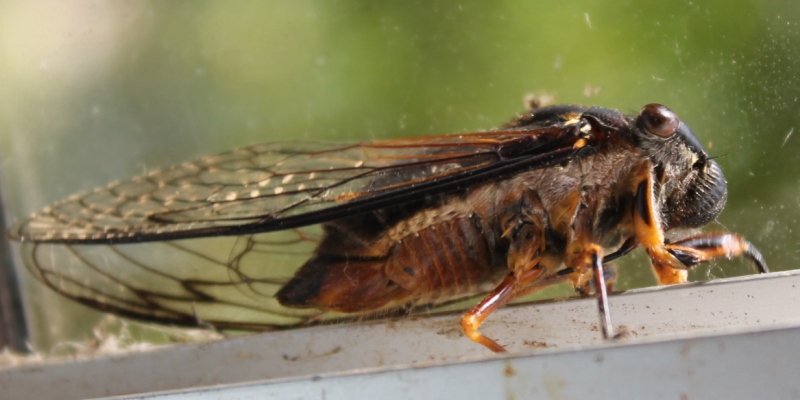
________________________________________
THE NATURAL HISTORY OF THECOLONY.—No. 4.
ENTOMOLOGY. —LEPIDOPTERA. NO. II.
The largest butterfly that the neighbourhood of our city can produce, is, as before states, about the size of the English Vanessa 10; it is seldom seen except at the warmest season of the year, and is at all times scarcer than the Tortoise-shell; it was by far more numerous than I have ever since seen it in December,1839, keeping principally to the Mount Lofty range, where on fine days literally a dozen or more arose at every step of the pedestrian. In the vicinity of the North Para River, about 27miles N.E. of Adelaide, a still larger species at present may be seen, and of more lively and diversified colors, similar in many respects to the English Fritillary butterfly, but on a larger scale; this last mentioned species I believe rather exceeds in size any of our British butter-flies.
Our most beautiful native species of Diurnais by no means rare at some seasons of the year. It is difficult to distinguish it from another native species, from the upper, that is, the side of the winks most frequently presented to view, being very similar, as both are white variously lined or clouded with black. The most common of these two has but little variation in the upper and under sides, the latter having faint yellow spots round the edges of the lower wings, but the under side of the wings. The former are scalloped round with bands of scarlet, and it is in many respects the much smaller in size, very much like the handsome Papilio Egens of New Holland. I will give a farther description of these Diarcae in some future number.
The ones are here more remarkable for their size than their coloring, though many there are professing the latter quality to some extent; the largest I have seen, and which I have now in my possession, measures from tip to tip of the wings, eight inches; the body is about two and two-thirds inches in length, and three-fourths of an inch broad, and the antennae are pectinated; the color is a light brown, and the upper wings are faintly traced with double lines of a darker color, forming large spots or clouds, and presenting a very handsome and regular appearance when closely examined; the wings are thin, but at their base are, like the body, thickly clothed with down. The latest of the British species, is, I believe, the Privet Hawkmoth (Sphinx Ligustri), which measures in the extent of the wings about five and a-half inches, being therefore but little more than two-thirds the size of the one just mentioned.
Another species no doubt of the same family, measures between the extension of the wing tips five and four-fifths inches, the body being half an in inch broad and two inches long; its markings are much handsomer than in the last described species, the lower wings are very similar, but the upper ones have several bands or streaks of a silvery appearance, extending from the base of the wings about half way towards the opposite margin, down which runs a chain of spots of the same silver-like tint; the ground color of the upper wings is rather darker than in the last, but with the same faint waving lines and angles dispersed over their surface; in all other respects this moth resembles the last, with the exception of having the antennae much more strongly pectinated in all those I have found. Both these species vary much in size, but those just described are as large as I have ever seen them. I have, for the sake of a distinguishing English name called the former of these the Goliath and the latter the Achilles moth. I have but little doubt that it is the Chrysalis of the former insect which may be seen in such great numbers in the month of May allover the country, left by its late inhabitant buried in the holes, from beneath which, in this state, it has worked its way, to undergo its final and most surprising change.
The largest of the empty Chrysalides, or cast-off clothing of the liberated moth, is in length four inches, and in breadth at the broadest part not quite an inch, of a find dark polished brown or mahogany color on the upper side as far as the abdomen, each segment of which is divided into three distinct bands by raised lines, the second and third of which are much lighter than the other. Lying near this large Chrysalis may often be discovered, though it is not so common, the deserted tenement, I sup-pose, of the smaller or silver-streaked species, only differing in the length, which is about two-thirds of the other, with proportionate breadth. These different-sized Chrysalides perhaps produce the male and female of the same species, though I should think the two species above described are not so. If these late receptacles of still life are found soon after their tenants have issued from them, they maybe drawn to their full length, displaying distinctly the rings or segments of which they are composed, being mostly left in a crampled upstate by the insect in its efforts to liberate itself. The action of the sun soon turns them to a paler color. One of the commonest of our twilight moths, so often flying into our rooms at sunset, must be well known to all by the large ocelli on the upper wings; this moth is seldom found in a perfect state, as the wings are very thin, and being swift of flight, and, no doubt, as fond of liberty as its companions, on seeing itself con fined its wings are soon torn in its struggles to get free. Short must be its period of enjoyment in each day, for like many of its species, it retires before night quite closes in. That strange infatuation of flying towards the light,(and which has yet not been satisfactorily accounted for) of these insects, that wait for its disappearance to come forth, seems peculiar among the Lepidoptera, almost entirely to the smaller species of Nocturnae.
I am much indebted to a friend for the information that the noisy insects I mentioned in my last are all species of Cicada, which belong to the order Hymenoptera, which was, indeed, a mistake of some consequence. This arose from not having had one in my possession for more than a year, and therefore, speaking of it merely from recollection, the size and notes of this species being the only things I remarked at the time. This insect has for ages been known to the world; it is the fabled lyre of the ancients, and has been often celebrated in song. In Brazil it is remarkable for the almost stunning noise it makes in the trees.
The residence of those organs by which it is able to sound its powerful notes, and which I was unable to discover, are not unknown to naturalists, and are said by Reanmur to be quite internal, and in appearance not unlike to the strings of a harp, producing a similar effect when pulled; the male only possesses the power of song. Their manner of flight alone, if particularly observed, would, in a great measure, distinguish them from the Hymenoptera. On being touched, they launch themselves into the air with the assistance of a spring, as their hind legs are formed for leaping, and their light is then direct, and most like that of the Coleoptera, though slower.
The last mentioned circumstance is rather against their escaping from their foes. I once observed one of the middle sized species met, while on the wing, by a swallow, and as might be expected, instantaneously snapped up, the action not causing the bird to pause, even for a moment, in its rapid flight.
Turn we now to the Orthoptera (grasshoppers, locusts, &c.), an order of insects which here produces astonishing numbers. They are remarkable for the great variety of their forms, and in several of the tribes, for the beauty of their colors, and are generally placed in classification next to the Coleoptera. Under this head are included the various species of grasshoppers, crickets, and other insects similar in make or habits, and which, at a first glance, seem almost innumerable. In this, as in other warm climates, they literally swarm during the summer months, especially in those parts where the long sheltering grass or thick bushes afford them a retreat. Of this order we possess a very large species, which belongs also to one of its principal families, the Phasmidae, some of which are denominated spectre insects. It is certinaly the largest species of this class I ever saw. I obtained possession of it in May 1839; it was a female, and quite perfect, and was caught by a man (from whom I purchased it) with his hand, while flying in the Park Lands near Adelaide.
From the full notes I made at the time on the color and different parts of this extraordinary insect, I will give a description of the size and shape of the principal members. The length of the entire insect from the top of the small, round, and exposed head, which principally denotes the family, to the end of the body, is exactly six inches, and is comparatively narrow, being, at the broadest part, the base or commencement of the abdomen, but six and a half tenths of an inch; the head is four tenths, and the eyes one tenth of an inch in length; the latter are oval, and of a light grey color; the antennae are short, seven tenths of an inch, and composed of twenty-four segments or divisions. The wing covers, (tegmina), which but partially cover the wings, are one and four-fifths inches long, and six tenths of an inch in breadth, in shape like a broad leaf.
The under, or true wings, are rather more than four inches in length, and the outer parts of these, which meet down the abdomen when the insect is at rest, and quite cover the subjoined or gauze like parts, are coriaceous, like the wing covers, and of the same color. The two fore-most legs, which are a little longer than the others, are three and three-tenths inches long, very thin, and nearly the same through their whole length, but the four others have the femur remarkebly flat, smooth, and broad, viz; about three and a half tenths of an inch. With regard to this peculiarity in the last mentioned joint, it does not seem to appertain in particular to any of the legs of these insects, even in this family alone; the color of the whole of the upper side of the body, with the wings, and wing covers, is a dull green, like a partially withered gum tree leaf, and the under side and legs are somewhat paler, the under parts of the tegmina are a pale rose pink, as also all of the wings concealed by them.
This Insect which I before said was a female, laid two eggs soon after I obtained it; they were of the same color and oval shape as its eyes, and also like them, highly polished, butlarger, being less in size than the seed of the sweet garden pea. I have been thus particular in the description of the principal parts of this curious specimen of insect life, both on account of its large size and of its being a member of a family but little seen except between the tropics. The unobtrusive color given by Providence to this species, as well as to many other Orthopterous insects of its tribe, no doubt for its defence and protection from its watchful and quick-sighted feathered enemies, displays in a wonderful manner the Almighty's care of all his creatures, however humble their condition. The above species, when motionless on the trees, in which state many of the Phasmidaeremain for long periods, is exactly the color of the foliage around it. One other species of this insect I have since seen in possession of a gentleman in Adelaide, rather different in color and much smaller in size. Another remarkable insect, which this country also produces, is the Preying Mantis of the South of Europe, which I will describe in my next.
Naturae Amator
December 29th, 1840.
THE NATURAL HISTORY OF THE COLONY.—No. 4. (1841, January 2). South Australian Register (Adelaide, SA : 1839 - 1900), p. 4. Retrieved from http://nla.gov.au/nla.news-article27442150
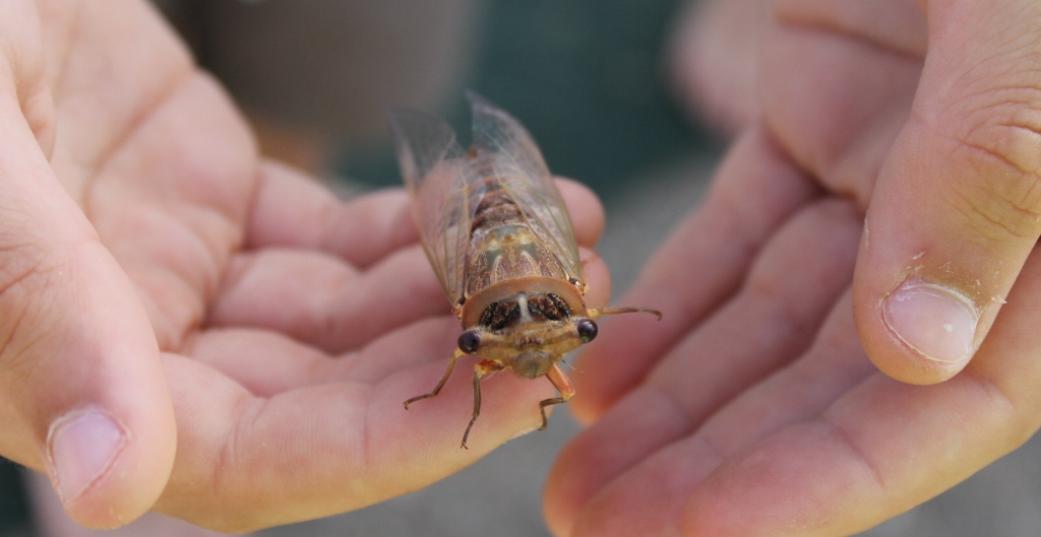
Yellow Monday Cicada
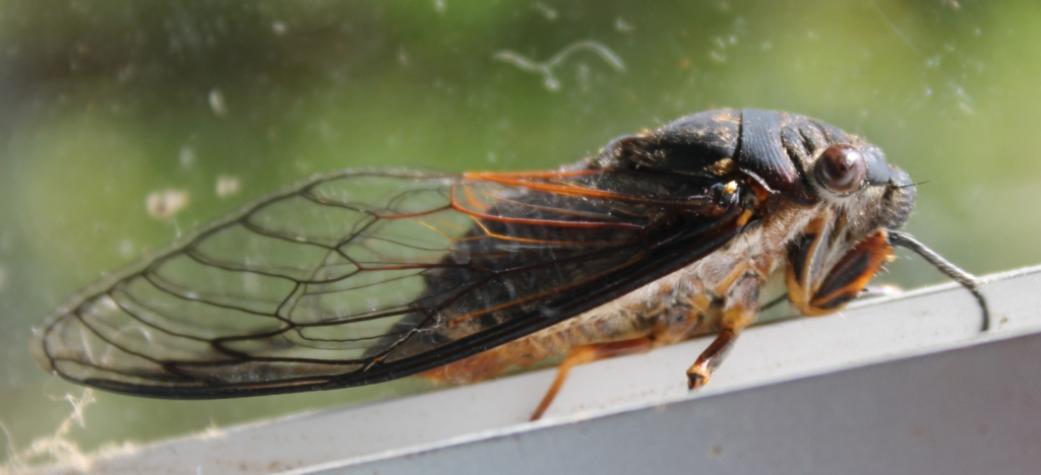
Black Prince Cicada
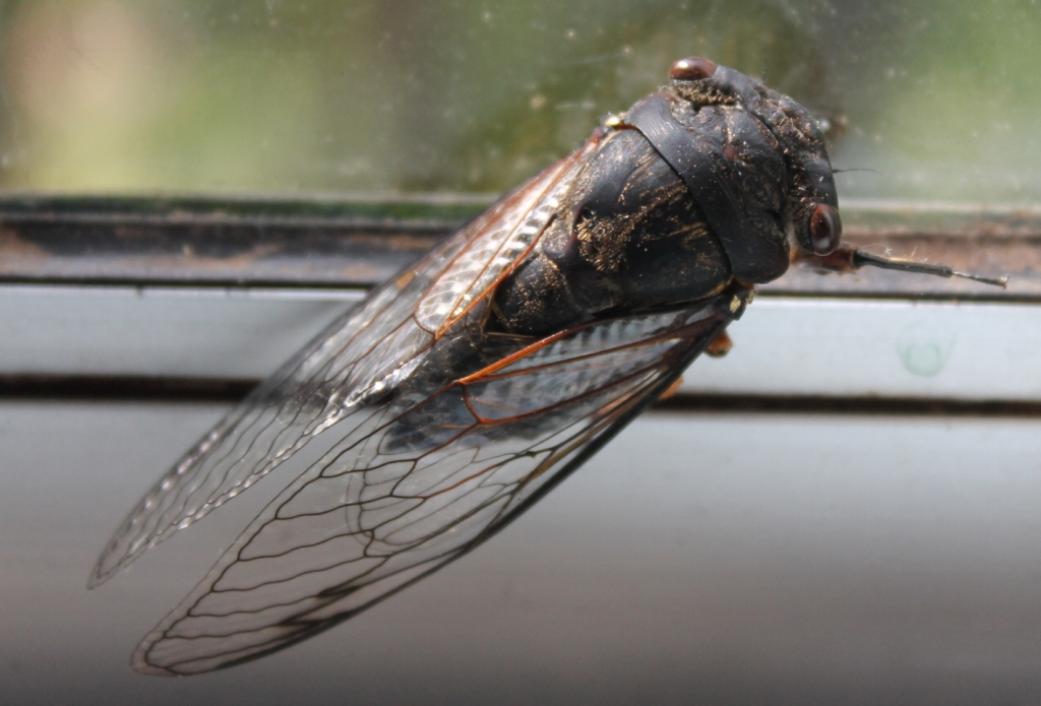
The Australian Museum tells us that 'the Greengrocer cicada is probably the most commonly encountered in the Sydney area. The two common names of Greengrocer and Yellow Monday refer to different colour forms of the same species. The origin of the names is unclear but they are known to have been in use as early as 1896. Other names for different colour forms include Chocolate Soldier (dark tan form) and Blue Moon (turquoise form).
Dusk is the usual time to hear the male Greengrocers calling for females, but they also sing in the morning on warm days. The harsh song may be continuous or delivered in short bursts, and can be extremely loud and penetrating.
Adult Greengrocer cicadas live for around six weeks. Females deposit eggs into dead or dying branches of a food plant. The eggs hatch after about four months into spidery-looking, long-legged nymphs that burrow into the soil. Here they suck sap out of plant roots and grow for up to seven years, emerging as adults between September and November on warm nights often following rain.'
We have also had a large and loud symphony coming from all the Black Prince Cicadas (Psaltoda plaga) in the Spotted Gums around our home these past two Summer months. Matilda, our dog, loves chasing them and we have to get them off her before she bites them! This can be a little difficult when they fly in through open windows at night as she will catch them then run as we try to catch her and save them - she is pretty fast and loves playing chasings - naughty puppy!
.jpg?timestamp=1579897541892)
The black prince was originally described by German naturalist Ernst Friedrich Germar in 1834 as Cicada argentata, the species name derived from the Latin argentum "silver". Swedish entomologist Carl Stål defined the new genus Psaltoda in 1861 with three species, including the black prince as Psaltoda argentata. Francis Walker described Cicada plaga in 1850 as well as querying further specimens as Cicada argentata. He noted in 1858 that the binomial Cicada argentata had been used by a European species, and declared that Germar's cicada needed a new name. The name black prince was in popular use by 1923. It was reported by McKeown in 1942 as referring to a dark form of the green grocer (Cyclochila australasiae forma spreta), but was later linked to Psaltoda plaga.
Photographs by A J Guesdon.
School Leavers Support
- Download or explore the SLIK here to help guide Your Career.
- School Leavers Information Kit (PDF 5.2MB).
- School Leavers Information Kit (DOCX 0.9MB).
- The SLIK has also been translated into additional languages.
- Download our information booklets if you are rural, regional and remote, Aboriginal or Torres Strait Islander, or living with disability.
- Support for Regional, Rural and Remote School Leavers (PDF 2MB).
- Support for Regional, Rural and Remote School Leavers (DOCX 0.9MB).
- Support for Aboriginal and/or Torres Strait Islander School Leavers (PDF 2MB).
- Support for Aboriginal and/or Torres Strait Islander School Leavers (DOCX 1.1MB).
- Support for School Leavers with Disability (PDF 2MB).
- Support for School Leavers with Disability (DOCX 0.9MB).
- Download the Parents and Guardian’s Guide for School Leavers, which summarises the resources and information available to help you explore all the education, training, and work options available to your young person.
School Leavers Information Service
- navigate the School Leavers Information Kit (SLIK),
- access and use the Your Career website and tools; and
- find relevant support services if needed.
Word Of The Week: Opportunity
noun
1. a time or set of circumstances that makes it possible to do something. 2. a favourable, appropriate, or advantageous combination of circumstances. 3. a chance or prospect.
From Middle English opportunite, Old French opportunité, Latin opportunitas, opportunus: opportune
opportune - adjective
1. occurring at a time that is suitable or advantageous. 2. fit or suitable for a particular purpose or occurrence
Word origin: C15: via Old French from Latin opportūnus, from ob- to + portus harbour (originally: coming to the harbour, obtaining timely protection). Word origin: ME from MFr, from L opportunus, lit., at or before the port.
.jpg.opt1041x694o0,0s1041x694.jpg?timestamp=1565801436025)
Want to pre-drink before going out? It probably won’t save you money, and can be risky to boot

You’re catching up with a few friends before you go out. Everyone’s having a drink, listening to some tunes, and the mood is good. A ride share is pulling up in the driveway – everyone quickly finishes their drinks and piles into the car, headed to a gig where more alcohol will be consumed.
This is the typical pre-drinking scenario – drinking alcohol in one place, typically someone’s home, before drinking more somewhere else, such as a pub, club or event.
You might be familiar with pre-drinking (colloquially known as pre-loading) and think nothing much of doing it.
In reality, it’s a complex behaviour that has been of great interest to health psychologists and public health strategists for the past 15 years.
And as popular as it is, pre-drinking isn’t without risk.
Why Do People Pre-Drink?
The considerable public health effort to reduce excessive drinking in licensed venues has meant some drinkers appear to have abandoned the traditional “pub to club” model in favour of a “home to pub to club” version.
You can understand the appeal – compared to a busy venue, someone’s house is likely to be less noisy, less cramped, and probably doesn’t include a cover charge.
In Australia, a common reason people cite for pre-drinking is the relatively cheaper cost of pre-purchased alcohol compared with prices at a licensed venue.
Indeed, behavioural economists have observed we tend to be quite discerning when figuring out the most cost-effective way to drink.
Add our complex taxation system and public health initiatives such as minimum unit pricing to the mix, and it’s no surprise we are looking for ways to get a buzz on the cheap.
More Than Money?
Outside Australia, evidence shows alcohol price is less of a driver for pre-drinking. Other motivational themes have emerged – mainly from psychological research in North America and Europe.
These include the “enhancement” aspect of pre-drinking itself (as the opening scenario illustrates), controlling alcohol consumption in situ (such as only drinking your preferred brand), or in anticipation of less access to alcohol later on (think long lines for beer at the footy).
Generally, the aim of pre-drinking appears to be getting “sufficiently intoxicated” before going out.
But one motive, commonly mentioned by men, has been labelled as “intimate pursuit”. This is where hanging out during pre-drinks is used to built rapport with someone you might be romantically interested in.
Although these themes are generally endorsed by Australian pre-drinkers, cost is still an important driver of our pre-drinking, especially among young Australians.
In our research, we asked participants about the cheaper cost of pre-drinking, alongside these other motives. It was the strongest predictor of pre-drinking, and also predicted participants’ experience of alcohol-related harm over the previous 12-month period.
Surprisingly, some people report that pre-drinking doesn’t save them that much money.
From a psychological perspective, this may be because alcohol affects our “inhibitory control”. Although our goal with having pre-drinks is to keep total alcohol expenditure down, the drunker we get, the harder it is to resist buying another round.
The Unique Harm Of Pre-Drinking
Unfortunately, research consistently shows pre-drinking is uniquely linked to excessive alcohol consumption, and alcohol-related harm.
One reason may be that we drink faster while pre-drinking, relative to sitting on a pint at the pub. This means pre-drinkers may reach higher levels of intoxication, more quickly.
This can be highly dependent on a range of factors – for instance, who we are pre-drinking with, and whether or not people are playing drinking games.
Adding to the risk, people tend to be pretty bad at estimating how much they are drinking.
Sadly, the “sweet spot” of a buzz can quickly give way to increasing levels of alcohol intoxication – and increased risk of alcohol-related harm.

How Can Pre-Drinking Risks Be Minimised?
Research shows pre-drinking serves important practical and social functions – catching up with friends in a more relaxed environment, and warming up for a night out.
As such, it is unlikely we will eliminate pre-drinking entirely, but we can try to make it a bit less risky.
One challenge for pre-drinking is that people may drink out of whatever vessel is around – say, a mug – and will find it difficult to keep track of their consumption.
Licensed premises serve alcohol in standardised containers such as pints and schooners, or use measured pours. So, having schooners or jiggers on hand when pre-drinking would be a good place to start.
Health psychologists often promote “protective behavioural strategies” – things that help keep our alcohol consumption under control. For example, we can set ourselves a drink limit, or set a timer between drinks to slow our intake. Work is ongoing to investigate how these strategies might be better tailored to the pre-drinking context.
Ultimately, if you’re planning a pre-drinking session before an event, it’s a good idea to make sure there are plenty of non-alcoholic or low-alcohol options, and food – as you would with any party.
The most important thing pre-drinkers can do is keep an eye on each other, making sure everyone makes it to the event, has a good time, and gets home safely.![]()
Kim M Caudwell, Lecturer - Psychology | Chair, Researchers in Behavioural Addictions, Alcohol and Drugs (BAAD), Charles Darwin University
This article is republished from The Conversation under a Creative Commons license. Read the original article.
Long before Silicon Valley, scholars in ancient Iraq created an intellectual hub that revolutionised science

Time and again, collaboration has proven to be a key driver of scientific and technological innovation. So it follows that some of the greatest advances have come from intellectual hubs set up for this very purpose.
Today Silicon Valley is synonymous with this idea – but it’s just one in a long line of institutions that paved the way before it. One such example came from Baghdad, Iraq, during the Islamic Golden Age in the fourth Islamic century (tenth century AD).
It was around this time, when Europe was living through its so-called “Dark Ages”, the House of Wisdom (Bayt-al Hikmah) was born. It was here that many great works from Persia, China, India and Greece were collected and translated into Arabic, including works by Aristotle and Euclid.

This culturally and linguistically diverse environment gave rise to innovations that would have lasting legacies in fields including algebra, geography, astronomy, medicine and engineering.
Automata With Talent
During its tenure of some three-and-a-half centuries, the House of Wisdom was populated by a number of multitalented thinkers.
Among these were the Banu Musa brothers – three ninth-century Persian scholars who lived in Baghdad. The brothers formed a multidisciplinary team: one was a mathematician, one an astronomer and one an engineer.
They translated works from other languages into Arabic, sponsored other translators and invested money in buying rare manuscripts. They were also involved in politics and the development of urban infrastructure, and were even musically talented.
But arguably their most tangible contribution was to automated machines, or automata. One of their works published in 850 AD, The Book of Ingenious Devices, translated as The Book of Tricks, describes machines that served as precursors to modern robots.
These automata included mechanical musical instruments and a self-playing steam-powered robotic flute player. Vrije University of Amsterdam’s Teun Koetsier considers this mechanical musician to be the world’s first programmable machine.
Brilliant Polymaths
Another scholar of the House of Wisdom at the time was Mohammad ibn Musa al-Khwarizmi, whose name inspired a term we use regularly: “algorithm”.
In fact, his is a two-fold legacy, as the term “algebra” also derives from the title of one of his books, Kitab al-Jebr, or The Book of Completion.

This was one of the (if not the) world’s first publications of algebraic rules. He also made important contributions to geography and astronomy.
Al-Khwarizmi worked closely with al-Kindi, also known by his Latinised name Alkindus.
Al-Kindi was an Abbasid polymath. He was a citizen of the Abbasid Empire, which spanned the Arabic-speaking world from what’s now Pakistan to Tunisia, and from the Black Sea to the Indian Ocean. He was a mathematician, student of cryptanalysis, and pioneer in music theory who combined Aristotelian philosophy with Islamic theology.
Al-Kindi is credited with introducing Indian numbers to his colleagues and peers in the Arab-speaking world. Together with al-Khwarizmi, he developed the Arabic numerals that we all use today (i.e. numbers 0-9).
He also authored the oldest known book on cryptanalysis, and is known to have used statistical inference (a type of data analysis). Statistician Lyle Broemeling describes this as one of the earliest known examples of both these methods.
Al-Kindi’s personal library was so magnificent the Banu Musa brothers apparently conspired, in their jealousy, to have him beaten, evicted from the House of Wisdom, and his library confiscated and given to them.
Gone Without A Trace
After centuries of fostering intellectual thought and technical development, The House of Wisdom was destroyed by the Mongols during the Siege of Baghdad in 1258 – leaving next to no traces.

This absence of archaeological evidence has even led some scholars to doubt its very existence, or to suggest it existed not so much as a place, but as a state of mind.
In his book Greek Thought, Arabic Culture, Dimitri Gutas suggests the House of Wisdom could, at best, be romanticised as an “idealised national archive”. But this view is challenged by Islamic Studies expert Hossain Kamaly in the review of the volume.
However, even Gutas agrees that between 800 AD and 1000 AD there was a large-scale translation movement in the Middle East that led to a comprehensive and systematic translation of Greek non-literary works into Arabic. Translators were held in high esteem, and social prestige was awarded not only to them, but also to the elite who helped fund their activities.
As renowned science communicator and theoretical physicist Jim al-Khalili summarises in his book Pathfinders:
[T]here was indeed an establishment known as the House of Wisdom […] expanded dramatically in scope from a mere palace library […] that became a centre for original scientific scholarship.
In other words, the House of Wisdom could have been a small space, but one that enabled a culture of interdisciplinary knowledge acquisition in a rich and dynamic environment. Its legacy and contribution to modern research are clear.

Lessons For Today
While there’s much we don’t know about the House of Wisdom, one thing seems clear: it was driven by an appreciation of the rich ideas that can emerge in a dynamic, multidisciplinary environment.
In this regard, it begins to sound less like Silicon Valley, which has shown itself to be focused squarely on commercial gain and is known for attracting unscrupulous behaviour.
On closer inspection, The House of Wisdom sounds more like a collaborative environment that could be achieved in higher education.
One key to its success was consistent financial backing from various caliphs, who were the political and religious leaders of Islamic states, known as caliphates. In other words, the scholars were focused on just that – scholarship – rather than applying for funding.
Also, all manners of gathering knowledge were equally respected, rewarded and encouraged, which led to social stability and prosperity.
What would it take to create a space like this today? A complete re-evaluation of the way higher education is managed, funded, judged and taught?
Or maybe we should simply ask: are our disciplinary divides, which position the sciences and humanities as antithetical, holding back innovation?
For the scholars in Baghdad in the fourth Islamic century, these pursuits were opposite but equal sides of the same coin. Perhaps we’d benefit by taking a page from their book.![]()
Terhi Nurmikko-Fuller, Senior Lecturer in Digital Humanities, Australian National University
This article is republished from The Conversation under a Creative Commons license. Read the original article.
5 tips to take the best care of your voice for everyone who sings, from a speech pathologist

The care of your singing voice is crucial to maintain a healthy and long-life voice.
Professional singers often have teams of people keeping their voices healthy, and they have received lots of training in how to take care of their voice.
But everyone who sings – from young students to passionate amateurs – should be taking care of their voice.
If you are a singer, here are five crucial tips to prevent vocal problems.
1. Keep Hydrated
Hydration is the most important fact to be considered when singing.
When we are dehydrated, the biomechanical properties of our vocal folds are impacted, decreasing our vocal range and increasing the stress on these folds.
Singers who do not hydrate well are at risk of developing voice disorders such as nodules and polyps.
An easy way to stay hydrated is to keep up your water consumption. Singers can complement this by using nebulisers and humidifiers.

Humidifiers balance out dry air caused by heating or air conditioning.
Nebulisers assist with hydration directly. By breathing in a saline water solution or purified water, we can see an immediate influence on our vocal folds.
You don’t need fancy equipment. You can also breathe in steam from boiled water. Make sure to be careful with the temperature, as steam can burn our airway when it is too hot. Pour boiled water into a bowl, wait 5-7 minutes, place a towel over your head and then breathe in as many times as you like.
2. Warm-Up And Cool-Down Your Voice
Vocal warm-up and cool-down exercises are crucial: these will have a positive benefit on your voice in the moment and prevent future injuries.
An easy warm-up you can try only requires a straw. With a straw between your lips into the air or a cup of water, make a “u” sound. Working for five minutes, change the pitch and frequency of making this sound. The added resistance of singing through a straw will give your vocal folds a good work out.
You can also add resistance by speaking or singing into a CPR mask.

Other exercises don’t require these materials. You can try lips or tongue trills, humming and blowing raspberries.
While there are many internet tutorials on how to do these exercises, I suggest you practise under professional supervision to avoid damaging your voice by going beyond your vocal limits.
3. Watch Your Lifestyle Factors
Lifestyle is fundamental when taking care of our voices.
In order to avoid injuries or develop any voice disorders, we should monitor external factors such as maintaining a balanced diet, having periods of rest and reducing the consumption of cigarettes, alcohol, drugs, caffeine and soft drinks.
By changing these habits, you can preserve good vocal health and keep your body running properly. You can also guard against developing reflux.

Reflux occurs when acids from your stomach travel back up your throat. Symptoms include a burning sensation in your chest (heartburn), backwash (regurgitation) of food or sour liquid, upper abdominal or chest pain, trouble swallowing (dysphagia) or a sensation of a lump in your throat.
This stomach acid can dry and irritate your vocal folds.
If you do experience any of these symptoms, keep up your water intake, try to avoid lying down for at least two to three hours after a meal and keep your head elevated using an extra pillow or two while you sleep.
If these symptoms persist, visit your doctor for further examination.
4. Listen To Your Body
Sometimes our body sends signals when struggling. We should pay close attention to what our bodies are telling us.
Negative warning signs can include a reduced tonal range, constant throat clearing, vocal fatigue, pain during or after singing or talking, mild or moderate abdominal tension, unstable voice, pitch breaks, difficulty singing or speaking softly.
Speaking or singing should not present with any negative symptoms or conditions.
It’s important to note home remedies like tea with honey, lemon and ginger, and gargles with salty water – or even alcohol – do not fix your voice. These will go directly to the oesophagus and will not have any effect on your vocal folds.
If you are experiencing symptoms like these, pay more attention to things like your warm up, your cool down, periods of rest and your levels of hydration. If they persist, visit a doctor or a speech pathologist.
5. See A Professional
Don’t try and push through any pain or difficulties you are facing.
When facing any vocal difficulty, you should visit an ear, nose and throat doctor (ENT) or a speech pathologist.
An ENT can check your larynx and other structures to make sure you do not have any organic or functional disorders impacting your voice.
If you would like to practise new techniques – like belting or voice distortions – consult with voice specialists like speech pathologists, vocal coaches or music teachers who are experts on these areas.
Last but not least, check your voice with professionals once a year. This will help with the prevention of future injuries and help you maintain a healthy voice. ![]()
Sandra Rojas, Speech pathologist, Voice specialist, Researcher, Federation University Australia
This article is republished from The Conversation under a Creative Commons license. Read the original article.
5 Australian women choreographers you should know (and where to see them in 2023)

“Ballet is woman” claimed the legendary New York choreographer George Balanchine. But “where are all the women ballet choreographers?” asked researchers Oellen A. Meglin and Lynn Matluck Brooks in 2012. They found only 23 articles on women ballet choreographers in the New York Times’ 171-year history.
In Australia, even the keenest ballet fan will struggle to recall a dozen ballets by women in The Australian Ballet company’s 60-year history.
While men make up a very small proportion of those dancing in this country, the 2018 Turning Pointe report found that in Australia’s major dance companies from 2011 to 2017 only 25% of choreographic commissions were women.
Choreographers are dance’s cultural leaders and storytellers. They are dance’s voice.
Supporting and celebrating today’s women choreographers is vital to encouraging a new generation of women to follow, giving women in dance a voice into the future.
So where are the Australian women choreographers of today? Here are five to get you started.
1. Frances Rings

In 2023, Frances Rings will step into the role of artistic director of Bangarra Dance Theatre.
A descendant of the Wirangu and Mirning peoples from the west coast of South Australia, Rings made her choreographic debut with Bangarra in 2002 with the work Rations.
She has since created and co-created another seven works for the company.
Rings fuses contemporary movement with ancient Indigenous heritage to produce organic works deeply rooted in the natural world. Her works reflect critically on the past, celebrate survival in the present and offer hope for the future.
Her works share with the audience the feeling of connecting with the sacred on Country and are a First Nation’s ode to the power, beauty and spirit of the earth.
In 2023, Yuldea opens in Sydney before touring; and Terrain will be in Adelaide.
2. Alice Topp
A former dancer with the Australian Ballet, Alice Topp’s works are known for their humanity.
She creates contemporary ballets that evoke both vulnerability and strength. Topp is celebrated for her fluid, acrobatic duets, and she often takes on themes about damage and repair, durability and fragility, falling and recovering.

But she is anything but predictable. Her recent work Annealing saw a mass of noisy bright metallic gold bodies contrasted with a quiet, dimly-lit duet. She is also passionate about homegrown and inter-generational collaborations promoting local dancers, composers and designers.
Her first mainstage work, Aurum, won her the Helpmann Award for best ballet in 2019 and she has since created four other major works. She is currently resident choreographer with The Australian Ballet and creative director of independent collective Project Animo.
In 2023, you can see the work of Alice Topp at the Australian Ballet, the West Australian Ballet, Singapore Ballet and the Royal New Zealand Ballet.
3. Stephanie Lake
Stephanie Lake describes her work as “obsessed with groups and communal action […] that sense of shared experience”.
This obsession results in large celebratory works, like the 60-dancer Colossus and 200-plus cast Multiply. These works see masses of individual moving bodies imperfectly colliding and uniting, forming patterns reminiscent of flocks of birds or opening flowers.
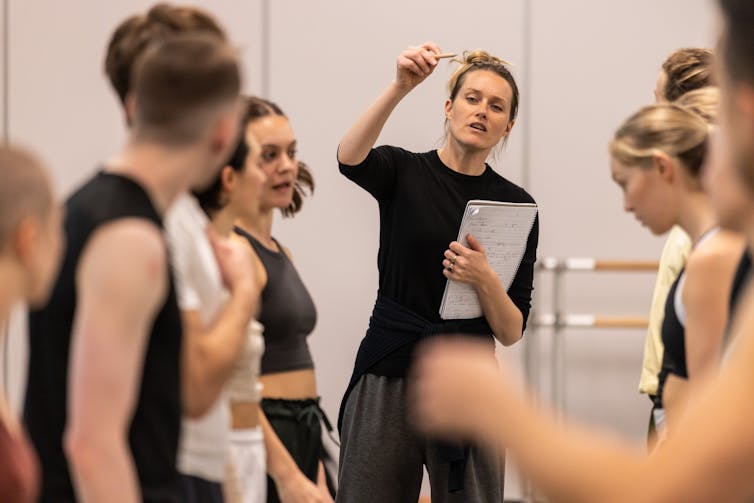
Lake is not afraid to take on darker themes. Her work has looked at death, personal demons, underground monsters and pandemic lockdowns.
Performed on bare stages in simple attire with minimal lighting, Lake’s works draw us into the intimacy and vulnerability of the interacting bodies.
Her breakthrough work was Mix Tape in 2010. Since then, she has had works commissioned by Sydney Dance Company, Dancenorth and Tasdance, among many others, and she is currently artistic director of her own company, The Stephanie Lake Company.
In 2023, you can see the work of Stephanie Lake at Perth Festival, Sydney Festival and touring internationally.
4. Claire Marshall
Claire Marshall began her professional career in Brisbane as a contemporary dance choreographer. In 2013, she shifted to dance film and choreographing with the camera with her work Pulse, followed by the award-winning Ward of State in 2014.
Since then, she has created seven other film works, won multiple awards and has been part of film festivals across the world.

In her choreographic process, Marshall allows objects and surfaces in the location to dictate movement choice. Using different lenses and angles, she creates often surreal worlds for her dancers to occupy.
Many of her works are psychological thrillers and have a distinctive 20th century flavour with vibrant vintage costumes and mid-century interiors.
Marshall leaves the meaning of her works open to interpretation. They are often interactive in a choose-your-own-adventure style, using split or multiple screens, giving each viewer a different experience.
In 2023, you can see Claire Marshall’s adapted version of Permutations online in April.
5. Annette Carmichael
Annette Carmichael is an award-winning contemporary choreographer based in Denmark, Western Australia, who creates works with professional dancers, artists and community members.

Most recently, Carmichael has been creating large-scale regional pieces co-created with community dancers. The works combine natural movement with a gestural language developed by the performers. They are multi-art productions exploring themes such as war, domestic violence and global terror.
Whether in theatres, huge outdoor arenas or on Zoom, Carmichael’s works take us on both personal and collective journeys sharing honest and often raw emotion.
In 2023, The Stars Descend will be the culmination of a three-year program which explored ways of connecting people with the natural world. It will unfold in five chapters along an area of rich biodiversity currently undergoing restoration. You can watch single performances or join the 15-day odyssey along the trail and see them unfold one by one.
See Annette Carmichael’s work in 2023 across Western Australia.![]()
Yvette Grant, PhD (Dance) Candidate and dance history tutor, The University of Melbourne
This article is republished from The Conversation under a Creative Commons license. Read the original article.
The rich history of our love affair with luxury

In today’s world it could be said, to a certain degree, that even a relatively impoverished person engages with luxury, in some way.
If you enjoy regulated heating or cooling at home, regular lighting, chicken meat, or eat chocolates, you are engaging with formats that once indicated luxury.
But what is, and is not, considered to be a luxury, changes with the times.
Decadence And Luxury
When we describe a dessert as “decadent” today, we must remember it really means decaying, a concept related to the “Romans of the decadence” whose lavish lifestyles are held up as proof of why the Empire had to fail.
The Romans saw luxury as quintessentially foreign and therefore alien to the true and olden spirit of the Roman polis. This is why luxury was often represented as coming from “the Orient”, the source of rare scents, spices, gems, ivories and enslaved peoples.
As a result, the Romans introduced sumptuary laws, which were prescriptions to manage conspicuous consumption of things like expensive clothing and jewellery worn by social groups, but also the amount spent on banquets and even funerals.
This was necessary, because the ancient Romans enjoyed conspicuous luxury. They liked to eat food whose ingredients resembled another. They enjoyed delicacies such as fattened fowls, peacock, oysters, ham, wild boar and fig-peckers, the latter eaten whole, sometimes all combined together in a crusted paté, even though this was forbidden by the new laws. There were even luxuries in enslaved peoples. The poet Juvenal commented satirically that clearly it was better to have a bevy of pretty pageboys (exoleti) arranged according to their nationality, size and hair colour serving the drinks rather than coarse household help.
There is a long continuity in this type of consumption. In the 19th century, for example, there was a premium on tall footmen matching in size and the Victorians loved elaborate feasts with multiple courses.

Follow The Money
By the mid 19th century, wealth from new industries created enormous fortunes at a time when taxation and labour costs were low.
North Americans became the richest people in the world. Clare Booth Luce, formerly married to the chairman of Time- Life, said:
In America money is a thing less valued in the spending than in the earning. It is less a symbol of luxury than of ‘success’, less of corruption than of virtue.
While Americans were good at making money, they seemed to need Europeans to spend it. The raft of rich American women who began to marry into the European aristocracy in the late 19th century were known as the “dollar princesses”, the term coming from a popular song. The British aristocracy were, of course, in turn marrying into this American wealth.
Between 1890 and 1914, half the world’s capital flowed through London. The Dollar Princesses paid for enormous renovations and modernisation of stately homes, were photographed with dozens of trunks as they moved across the Atlantic, and patronised the luxury establishments of jewellers, couturiers, florists and caterers.
The arrival of the wealthy Americans heiresses coincided with a series of challenges to the British aristocracy including the introduction of death duties, the rise in income tax and The Great Unrest of 1912.
Living In Style
Between the end of the 19th century and the start of the first world war, luxury was widely reported and commented upon in diaries and memoirs. The house parties about which so much was written were characterised by excessive meals of great refinement, elaborate flowers and large numbers of visible servants.
Much luxury was French. Edward VII was a famed Francophile. The Entente Cordiale of 1904 benefited British French trade and travel.
Louis Vuitton opened in Bond St in 1900. His new flat trunks for cars were stackable, replacing older domed tops designed to repel water.
Cartier opened in London in 1902. Faberge also had a new London store. The Paris Ritz opened in 1898 and the London Ritz Hotel in 1905, decorated in a newly fashionable white and gilt Louis XVI style.
Service Stripes
This was a period when wealthy women were laden with jewels: Kenneth Clark, the art historian, noted of a New York party in 1930 that the women “even brought pieces of jewellery in their hands and laid them down on the dinner table. This could have happened in the Middle Ages.”
Mrs Greville, one of the wealthiest women in England (daughter of a Scottish brewer), loved her jewels, owning pieces that could be traced back to Marie Antoinette and the Empress Josephine.
The late Queen Mother, a great lover of luxury and thoroughly Edwardian figure, inherited key pieces of jewellery from Mrs Greville in 1942, a friend from the time she was still Duchess of York.
But, as Elizabeth wrote in her diaries, she did not wear the lavish Cartier and Boucheron pieces until 1947, so as to not appear “out of sync” with the austerity movement immediately after the war. Profligate luxury risks looking out of step with public morals.

The Queen Mother wore all Mrs Greville’s jewels at her 80th Birthday party – and the owner of them now is Camilla, the Queen Consort. As Camilla is the grand-daughter of Edward VII’s mistress Mrs Keppel, the story comes full circle.
Mrs Greville left an estate in the 1940s worth approximately £39 million or 67 million AUD.
This is not much money if we compare it to the fortunes held by global billionaires today.
Gina Reinhart has between A$28.8 and A$31.4 billion. She lives discreetly part of the year in Dalkeith Perth in her late father’s home, in Singapore at a gated community, and on an ocean liner.
Luxury Today
Today, luxury is seen as the embodiment of growing income inequality within states and communities, and also between different nations in the world. This is not new, although in the past luxury and inequality were seen as part of how a hierarchical society was structured: acknowledged, rather than seen as a problem.
Luxury is not the cause of inequality, though it might be one of its effects. When societies aims towards income and social equality (as some postwar societies did), luxury – or at least the public discussion of luxury – seems to disappear. By contrast, societies like the present, in which 1% of the population owns 49% of the world’s wealth, lead luxury to the fore.![]()
Peter McNeil, Distinguished Professor of Design History, UTS, University of Technology Sydney
This article is republished from The Conversation under a Creative Commons license. Read the original article.
Putting the bones of giant, extinct ‘thunderbirds’ under the microscope reveals how they grew
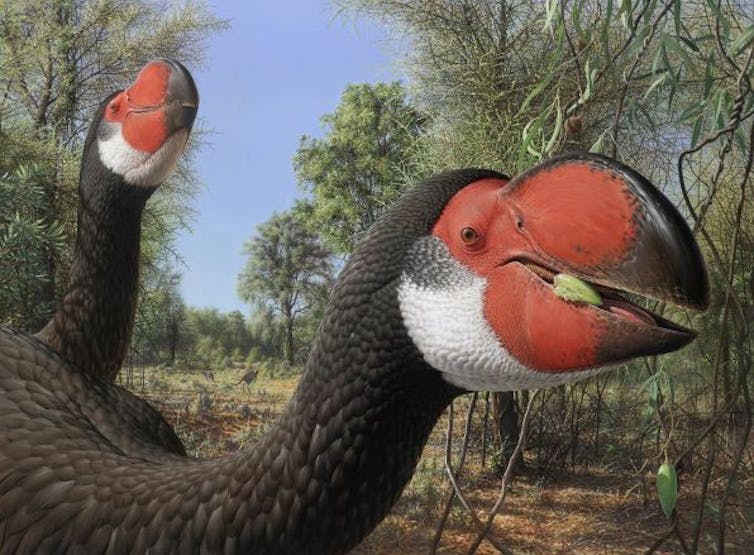
The largest flightless bird found anywhere in the world today is the ostrich. It stands about 2.7 metres tall and can weigh up to 150kg. But millions of years ago ostriches would have been dwarfed by several other flightless bird species.
One was Dromornis stirtoni, nicknamed the thunderbird. It lived in the late Miocene period of Australia, about 8 million years ago. Another, Vorombe titan, lived far more recently in Madagascar, off the coast of southern Africa. It is thought to have gone extinct in the 17th century after encountering humans. Fossil finds suggest that both species stood about 3 metres tall and were more than double the mass of ostriches.
Today all that remains of these birds are their fossilised bones and, in the case of Vorombe titan, a handful of eggs. This means that scientists know very little about the birds’ biology; for instance, the physical differences between male and female Dromornis stirtoni were unclear – until now.
Recently, my colleagues Trevor Worthy and Warren Handley from Australia’s Flinders University and I investigated the microscopic structure of Dromornis stirtoni’s bones. This allowed us first to pinpoint the size differences between males and females. Then we assessed how quickly the giant birds grew and how this compared to other, later members of its lineage.
We found that Dromornis stirtoni grew far more slowly than the most recent “thunderbird” species, Genyornis newtoni, which in turn grew far more slowly than the emus it lived alongside about 40,000 years ago and which still exist today. Its slow growth made Dromornis stirtoni vulnerable to climatic shifts.
This is an important finding amid the current environmental degradation driven by climate change: it is clear that slow-growing animals will be the most vulnerable to extinction.
Bones Are Key
My involvement in this research stems from the work I have done on the bone histology and growth patterns of a number of extinct species. These include the aepyornithids, including Vorombe titan from Madagascar – the “elephant bird” – and several Mesozoic birds, as well as their dinosaurian relatives.
Despite being fossilised for millions of years, the microscopic structure of bone (histology) is preserved intact and gives us a unique glimpse at how the animal grew when it was alive. In some animals, growth rings (like tree rings) occur and, just like tree rings, they can give us an idea of the age of the animal, and also information about its health.
By applying geometric morphology to Dromornis stirtoni’s bones, we were able to ascertain that females had an average body mass of about 441kg while males clocked in at on average 528kg.
Next, we wanted to understand the species’ growth rates. For this, we studied the microscopic structure of Dromornis long bones belonging to small hatchlings, subadults and adults.
We found that the young individuals experienced rapid growth but that this was followed by a period of arrested growth. In the largest individual at least 15 growth marks were present, suggesting that they needed at least 15 growth cycles (years) to reach adult body size.
We proposed that, as in modern kangaroos, the periods of arrested growth most likely corresponded to the hot, dry summer months when they were likely experiencing thermal stress and needed to put their energy into dealing with that rather than into growth.
Growth Patterns
This was an interesting finding, but we knew that it would have greater value if we could compare it to growth patterns in similar species, and in extant species.
So we looked at the bone microstructure of the most recent member of the “thunderbird” lineage – another giant flightless bird called Genyornis newtoni. It went extinct only about 40,000 years ago.
Our results showed that Genyornis, which was about 2.5 metres tall and probably weighed about 240kg, grew much more quickly than Dromornis. It reached adult body size on average in about one to two years, although it occasionally needed as many as four years.
We propose that this overall fast growth trajectory is likely to have helped Genyornis adapt to the unstable, turbulent times in the Pleistocene (from around 2.5 million years ago to about 12,000 years ago), when the aridification of Australia intensified. Instead of taking so long to grow up they would have been able to reach adult size more quickly and reproduce sooner.
But this relatively rapid growth trajectory was not enough to protect Genyornis from another threat: humans. Humans arrived on the Australian continent about 55,000 years ago. By 49,000 years ago, they had reached the Flinders Ranges, well within view of Lake Callabonna, where they would have encountered both Genyornis and emus.
Emus are about six times smaller than Genyornis, and have faster growth rates without any interruptions in their growth. In addition, they lay many more eggs during each breeding season. There is strong evidence that Genyornis eggs were collected and eaten by Indigenous people. Genyornis simply couldn’t lay enough eggs and its offspring simply didn’t grow fast enough to keep up with this pressure on their species; they were eventually driven to extinction by about 40,000 years ago.
Recouping Numbers
Emus, of course, still exist. We propose that the rapid growth and reproductive strategy of emus allowed them to recoup their numbers at a faster rate after hard times, which allowed them to survive until today.![]()
Anusuya Chinsamy-Turan, Professor, Biological Sciences Department, University of Cape Town
This article is republished from The Conversation under a Creative Commons license. Read the original article.
The sky isn’t just blue – airglow makes it green, yellow and red too
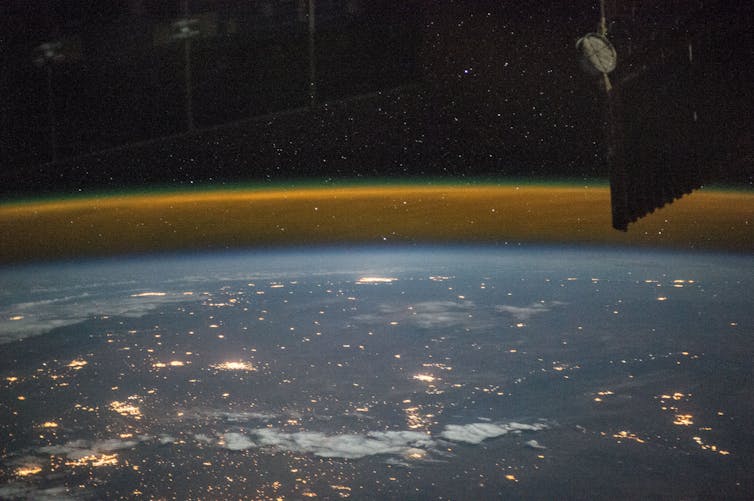
Look up on a clear sunny day and you will see a blue sky. But is this the true colour of the sky? Or is it the only colour of the sky?
The answers are a little complicated, but they involve the nature of light, atoms and molecules and some quirky parts of Earth’s atmosphere. And big lasers too – for science!
Blue Skies?
So first things first: when we see a blue sky on a sunny day, what are we seeing? Are we seeing blue nitrogen or blue oxygen? The simple answer is no. Instead the blue light we see is scattered sunlight.
The Sun produces a broad spectrum of visible light, which we see as white but it includes all the colours of the rainbow. When sunlight passes through the air, atoms and molecules in the atmosphere scatter blue light in all directions, far more than red light. This is called Rayleigh scattering, and results in a white Sun and blue skies on clear days.
At sunset we can see this effect dialled up, because sunlight has to pass through more air to reach us. When the Sun is close to the horizon, almost all the blue light is scattered (or absorbed by dust), so we end up with a red Sun with bluer colours surrounding it.
But if all we are seeing is scattered sunlight, what is the true colour of the sky? Perhaps we can get an answer at night.
The Colour Of Dark Skies
If you look at the night sky, it is obviously dark, but it isn’t perfectly black. Yes, there are the stars, but the night sky itself glows. This isn’t light pollution, but the atmosphere glowing naturally.
On a dark moonless night in the countryside, away from city lights, you can see the trees and hills silhouetted against the sky.
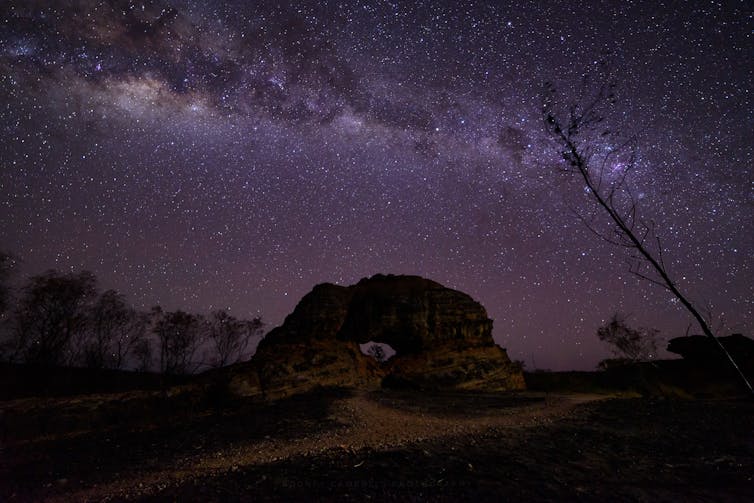
This glow, called airglow, is produced by atoms and molecules in the atmosphere. In visible light, oxygen produces green and red light, hydroxyl (OH) molecules produce red light, and sodium produces a sickly yellow. Nitrogen, while far more abundant in the air than sodium, does not contribute much to airglow.
The distinct colours of airglow are the result of atoms and molecules releasing particular amounts of energy (quanta) in the form of light. For example, at high altitudes ultraviolet light can split oxygen molecules (O₂) into pairs of oxygen atoms, and when these atoms later recombine into oxygen molecules they produce a distinct green light.
Yellow Light, Shooting Stars And Sharp Images
Sodium atoms make up a minuscule fraction of our atmosphere, but they make up a big part of airglow, and have a very unusual origin – shooting stars.
You can see shooting stars on any clear dark night, if you’re willing to wait. They are teensy tiny meteors, produced by grains of dust heating up and vaporising in the upper atmosphere as they travel at over 11 kilometres per second.
As shooting stars blaze across the sky, at roughly 100 kilometres altitude, they leave behind a trail of atoms and molecules. Sometimes you can see shooting stars with distinct colours, resulting from the atoms and molecules they contain. Very bright shooting stars can even leave visible smoke trails. And among those atoms and molecules is a smattering of sodium.
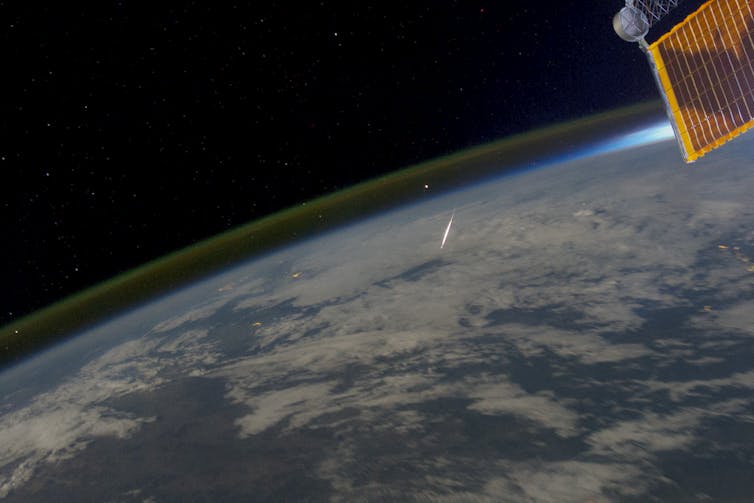
This high layer of sodium atoms is actually useful to astronomers. Our atmosphere is perpetually in motion, it’s turbulent, and it blurs images of planets, stars and galaxies. Think of the shimmering you see when you look along a long road on a summer’s afternoon.
To compensate for the turbulence, astronomers take quick images of bright stars and measure how the stars’ images are distorted. A special deformable mirror can be adjusted to remove the distortion, producing images that can be sharper than the ones from space telescopes. (Although space telescopes still have the advantage of not peering through airglow.)
This technique – called “adaptive optics” – is powerful, but there’s a big problem. There are not enough natural bright stars for adaptive optics to work over the whole sky. So astronomers make their own artificial stars in the night sky, called “laser guide stars”.
Those sodium atoms are high above the turbulent atmosphere, and we can make them glow brightly by firing a power laser at them tuned to the distinct yellow of sodium. The resulting artificial star can then be used for adaptive optics. The shooting star you see at night helps us see the Universe with sharper vision.
So the sky isn’t blue, at least not always. It is a glow-in-the-dark night sky too, coloured a mix of green, yellow and red. Its colours result from scattered sunlight, oxygen, and sodium from shooting stars. And with a little bit of physics, and some big lasers, we can make artificial yellow stars to get sharp images of our cosmos. ![]()
Michael J. I. Brown, Associate Professor in Astronomy, Monash University and Matthew Kenworthy, Associate professor in Astronomy, Leiden University
This article is republished from The Conversation under a Creative Commons license. Read the original article.
Radicalism, feminism and family puzzles: why Wilkie Collins is so much more than a mystery writer

Wilkie Collins had the longest writing career of any major mid-19th-century English novelist, writing short stories and novels from 1844 to 1889. Literary criticism, however, has traditionally seen him as only notable for his two mystery novels, The Woman in White (1860) and The Moonstone (1868).
While these are some of the century’s earliest, and best mysteries, praising only them ignores the social and political themes common in Collins’s work, especially his later novels.
The favouring of the mysteries even started with Charles Dickens, who employed Collins at his magazine Household Words. Dickens often published Collins there and in its successor All The Year Round. Though he did enjoy going out at night, in London or Paris, with the somewhat dashing Collins, Dickens only copied his literary approach once, in The Mystery of Edwin Drood, unfinished at his death.
Collins was born in 1824; his father was an established painter, of the old landscape-oriented, careful style, an approach Joseph Turner was to overturn. Collins could himself paint quite well, but his busy mother was more of an influence on him. A very keen reader, she seems to have inspired him as a writer and he was close to her throughout her life.
Collins’ first two novels were unlike the rest of his work. He began with themes that were overseas and historical, following Walter Scott and Edward Bulwer-Lytton, but his topics were distinctly lively.

Ioláni, written in 1844-5, was about love and tragedy in the Pacific, but it remained unpublished until 1999. Antonina (1850) depicted the Gothic attack on Rome in 408 BCE, with a woman among their leaders.
But then Collins shook off the weight of the past, starting on the main theme of his life’s work, modern troubled families. In Hide and Seek (1851), Mat Marksman, who has returned from America, having been scalped by native Americans, detects his strange family past.
A very different novel, but another with a modern-day colloquial title and again dealing with complex family matters, was The Dead Secret (1857): this time a woman traces her own baffling origins and their impact on the present.

Family puzzles and intrusive criminality flourish in The Woman in White (1860), a highly popular and admired novel. An unemployed art-teacher meets a white-clad beauty late at night in London: she has escaped from an asylum, and says she comes from Cumberland. Then he is found a job at a country house: Laura Fairlie, who looks very like the girl in the street lives there. Mysteries, crimes, and acts of unselfish courage follow: finally the intrusive evil forces – Sir Percival Glyde and Count Fosco – are defeated and the art-teacher and the beauty can be happy together.
Now enjoying a large reputation, Collins produced some more excellent big, thoughtful novels after this one, which seem almost forgotten as they are not mysteries. No Name (1862) is about a woman who struggles bravely and cleverly after her parents die.
Then there is the even more elaborate Armadale (1866). This offers two men both named Alan Armadale and a major female villain, Lydia Gwilt, who interact melodramatically. Throughout, Collins debates – as a serious novelist – the interface of Chance and Fate.

After that Collins produced The Moonstone (1868). It offers a mystery: what happened to the great diamond on the heroine’s birthday night? But it provides much more than an unguessable solution – that should not be revealed here. In addition to that, the police detective fails, an amateur does much better, there is a bossy over-religious woman, a radical young girl servant and overall praise for three heroic Indians. Collins, dissents from conservative English hostility towards Indians at that time, stemming from the 1857 native resistance to colonialism they called the “Indian Mutiny”.
Christian Socialism, Vivisection, Nationalism
In the 1870s Collins, taking a lot of laudanum for what the doctors called gout, wrote fine short stories, often about troubled but finally successful romances, perhaps reflecting his own two affairs – for some years conducted at the same time.
In this later period he produced a range of usually short but often very interesting novels. They are ignored by most commentators, no doubt at least in part because they are often challengingly socially aware. In The Law and the Lady (1875), a wife determinedly investigates and saves her husband from the charge of murdering his previous wife.
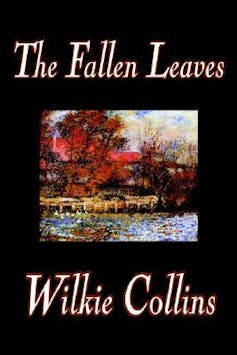
There is early feminism here: Dorothy Sayers, in her introduction to The Moonstone, said Collins creates women who are `“strong, resolute, and intellectual”. Radicalism can also be a central element. The Fallen Leaves (1879) has the young British hero lecturing on the Christian Socialism he learnt abroad in an American radical community.
Then Heart and Science (1883) attacks modern vivisectionists: central to the story is a scientist who has been killing dogs in his research.
In this last period, Collins ranges widely: Jezebel’s Daughter (1879) is set in the complexities of the German business world, and his very last book, Blind Love (1890), completed by Walter Besant after Collins died in September 1889, has a central figure seriously involved with the Irish independence conflict of the time.
Strong, Intriguing Women

Remarkably, Collins always had a whole novel planned out in notes before he started writing – Blind Love was not hard for another writer to finish. That potent planning and attention to detail guides his highly intricate plots, whether he is writing mysteries or not, and the richness of his fiction is recurrently focused on the social, political and gender strains that he saw in the world around him. He represented these themes with a detail and power rarely recognised.
Unlike Dickens, Collins created strong, intriguing women like the brave, clever Marian Halcombe in The Woman in White or the boldly, even rashly, self-assertive Magdalen Vanstone in No Name. His novels, after those very first two, always deal with issues and problems of the present day in a very identifiable England.
There is much more to read, and to think about, in Collins’s work than has traditionally been noticed. In recent years his reputation has been rising: American critics have seen his richness and strength more than most.
But there is still a way to go to recognise him as a full member of that remarkable group of mid-19th century major British writers, along with Benjamin Disraeli, Elizabeth Gaskell, Charles Dickens, Mary Elizabeth Braddon and George Eliot.
Stephen Knight is the author of The Complete Fiction of Wilkie Collins (Routledge 2022).![]()
Stephen Knight, Honorary Research Professor, The University of Melbourne
This article is republished from The Conversation under a Creative Commons license. Read the original article.
Summer Reading 2022-2023: We Of The Never Never
We of the Never Never is an autobiographical novel by Jeannie Gunn first published in 1908. Although published as a novel, it is an account of the author's experiences in 1902 at Elsey Station near Mataranka, Northern Territory in which she changed the names of people to obscure their identities. She published the book under the name Mrs Aeneas Gunn, using her husband's first and last name. Over the years, newspapers and magazine articles chronicled the fortunes of the Elsey characters. Jeannie outlived all but Bett-Bett.
Jeannie Gunn was the first white woman to settle in the Mataranka area. Her husband Aeneas was a partner in the Elsey cattle station on the Roper River, some 483 km (300 miles) south of Darwin. On 2 January 1902 the couple sailed from Melbourne for Port Darwin so that he could take up a job as the station's new manager. In Palmerston, Gunn was discouraged from accompanying her husband to the station on the basis that as a woman she would be "out of place" on a station such as the Elsey. However, she travelled south and her book describes the journey, settling in, and the difficulties of life in the bush. Jennie Gunn lived on the cattle station for about a year before her husband, Aeneas, died of malarial dysentery on March 16th 1903. Jeannie returned to Melbourne shortly afterwards and never returned to the Northern Territory.
The book is regarded as being significant as a precursor of the 1930s landscape writers. Already in 1908 Australia was a significantly urbanised country and the book was seen to provide symbols of things that made Australia different from anywhere else, underwriting an Australian legend of life and achievement in the outback, where "men and a few women still lived heroic lives in rhythm with the gallop of a horse" in "forbidding faraway places".

Four of the stockmen from Elsey Station in 1933 who were characterised in "We of the Never Never"
Characters from Aeneas Gunn's book 'We of the Never Never', 1933
Caption: Do you know the men in the above photograph? Probably not, yet thousands of boys and girls throughout Queensland during the past week have had the quartet intimately in their thoughts. They are the originals of characters in 'We of the Never Never', Mrs. Aeneas Gunn's classic tale of early Australian days, which was a textbook for the State scholarship examinations. They worked together on Elsy Station and had the first reunion since those days in 1933 when 'Truth's' photograph was taken. From left to right they are: Irish Mac, The Dandy, Mine Host and The Quiet Stockman. The first-named has since died. The other three are residents of South Australia. (Description supplied with photograph). Photo courtesy State Library of Queensland.
Local Seniors State They 'Are Invisible'
AvPals One To One Training At Avalon 2023: Register Now Or In Person
- Friday January 20th, 2023, 9.30am-11am
- Friday April 14th, 2023, 9.30am-11am
- Friday July 7th, 2023, 9.30am-11am
- Friday 29th September 2023, 8.30am-11am
Safer Internet Day 2023

2023 Seniors Card Discount Directory
- Central Coast & Hunter
- Northern NSW
- Southern NSW
- Western NSW
Good Hydration Linked To Healthy Aging
It’s OK to aim lower with your new year’s exercise resolutions – a few minutes a day can improve your muscle strength

One of the most popular new year’s resolutions is to exercise more. Many of us set ambitious goals requiring a big, regular commitment, but then abandon them because they’re too much to fit in. Plans to exercise more in the new year are often broken within a month.
So how can we exercise more regularly in the new year?
If the aim is to build long-term fitness and health, the exercise must be sustainable. It may be achievable to resolve to do an extra few minutes of muscle-strengthening exercises every day.
Our research suggests even one muscle contraction a day, for five days a week, can improve muscle strength if you keep it up for a month.
Why Do We Need To Exercise?
Physical activity guidelines recommended we perform 150 minutes of moderately intense exercise a week, as well as at least two muscle strengthening exercise sessions per week.
Skeletal muscle tissue declines with age, causing a loss of function and independence in older adults. So it’s important to include muscle strengthening exercises regularly to stimulate skeletal muscles of the legs, arms and trunk.
However, 85% of Australians don’t meet the physical activity recommendations to do both aerobic and muscle-strengthening exercises every week. The reasons include a lack of time, a lack of motivation, and no access to a workout facility.
It’s important to address these barriers, as physical inactivity increases the risk of many chronic diseases such as heart disease, diabetes, cancer, osteoporosis (weakened bones), dementia, depression and anxiety.
Short Bouts Of Exercise Can Boost Your Muscle Strength
My research team’s recent study found a small amount of regular resistance training can be better than doing one massive session, even if the amount of exercise overall was the same.
We asked participants to do an arm curl exercise consisting of 30 maximal contractions (so, contracting the muscle as hard as they could) each week for four weeks. One group did six contractions a day for five days a week; the other did 30 repetitions once a week.
The group that did them all in one go had no gains in muscle strength, whereas the group that spread the 30 repetitions over five days increased their muscle strength by more than 10%.
In a separate study, we showed that doing one three-second bicep muscle contraction a day, five days a week, increased muscle strength by 12%.
Participants contracted their muscles from a flexed to an extended position, like slowly lowering a heavy weight.
In both studies, participants used special equipment in our lab, and used as much strength as they could, but lowering a heavy dumbbell slowly several times could deliver similar results.

Incorporate Exercise Into Your Daily Activities
We are investigating the effects of five-minutes daily “eccentric” exercises on health and fitness of sedentary people. Eccentric exercises activate and lengthen muscles.
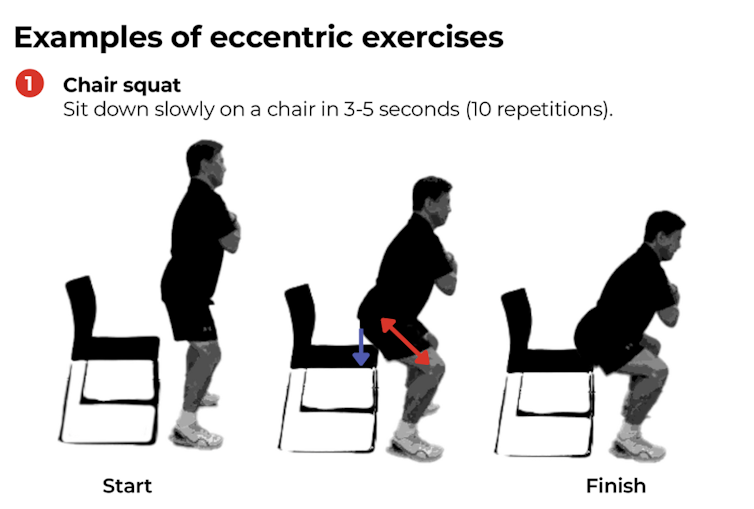
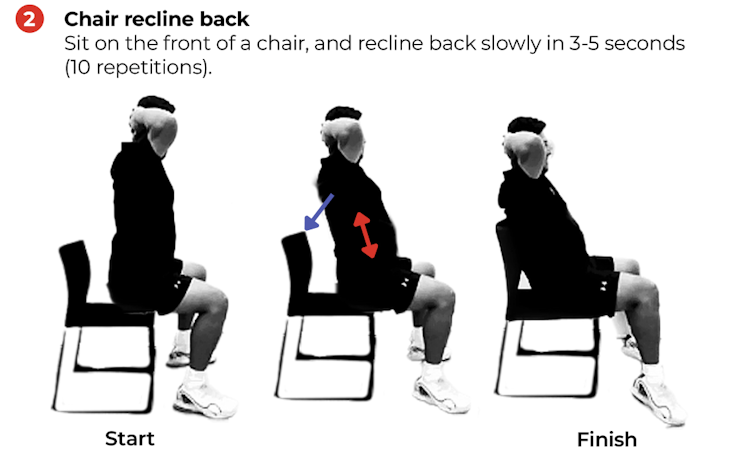
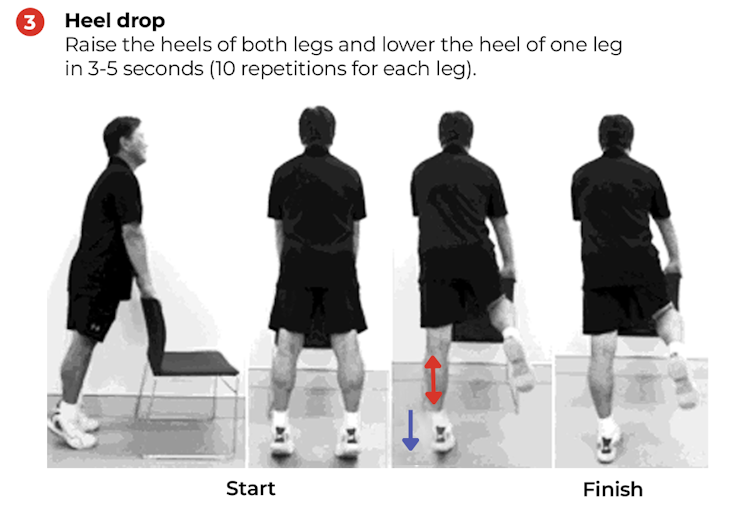

We have already investigated the effects of sitting to a chair slowly and found it is effective for improving leg muscle strength, chair sit-stand ability, walking ability, and balance in older adults.
Many of us sit down on a chair or a sofa more than ten times a day. So, if we sit down slowly every time we sit, we perform at least ten eccentric contractions of the muscles that work to extend the knee joints, a day. This is a good opportunity for us to perform eccentric exercise daily to simulate our leg muscles.
Eccentric contractions not only affect muscle, they can also improve health indicators such as blood pressure and cholesterol levels.
Start Small, Then Build Momentum
Our studies have focused on resistance exercise, but it also applies for aerobic exercise. Five minutes of walking every day can still be beneficial for your health.
However, if you’re already doing regular gym workouts every week, adding a little exercise each day may not produce much of an added effect, so it is not necessary to replace a consistent regular exercise routine with smaller micro-sessions.
But for those starting out, who might find taking on a big exercise commitment daunting, doing a little bit of exercise, often, is a good start. Once your fitness has improved, you can add more exercise.
So what about setting a resolution to spend five minutes exercising every day in 2023?![]()
Ken Nosaka, Professor of Exercise and Sports Science, Edith Cowan University
This article is republished from The Conversation under a Creative Commons license. Read the original article.
You Can Get Sick From Gardening: Please Wear A Mask When Handling Potting Mixes
Premier's Gala Concerts: Last-Minute Ticket Release
New Year, New Devices: Be Connected And Make Online Safety A Priority This Year
- Make your passwords strong and unique, and set up multi-factor authentication on accounts.
- Don’t share more information than you need to: when signing up for online services or registering an account, remember that you can choose to skip fields marked as optional.
- Adjust your privacy settings on social media platforms to help protect your personal information and be mindful about how much information is in the photos or videos you share.
- Be aware of scams: there are many online, email and phone scams out there, so it’s important to stay vigilant. Remember, if something looks too good to be true, it probably is.
Avalon Scottish Country Dancing

The Australian Carers Guide: Download Your Copy Free
 If you care for an elderly loved one, we have some good news. The new Australian Carers Guide has been specifically created for you. Its purpose is to assist you in all areas within the care-giving journey. It provides you with information, education, and where you can obtain practical support. This is what carers have been asking for years. It is produced every 3 months and the summer edition features our very own Maggie Beer. It is free to download, so get your copy now.
If you care for an elderly loved one, we have some good news. The new Australian Carers Guide has been specifically created for you. Its purpose is to assist you in all areas within the care-giving journey. It provides you with information, education, and where you can obtain practical support. This is what carers have been asking for years. It is produced every 3 months and the summer edition features our very own Maggie Beer. It is free to download, so get your copy now. Have Your Say: National Dementia Action Plan
- a coordinated approach to risk reduction
- early diagnosis
- better support for carers
- provide a national vision – for greater inclusion of people living with dementia, their carers and families
- guide action by governments – so health, acute and aged care systems work more seamlessly and broader policies and programs consider dementia
- drive mainstream services and systems – to improve outcomes for people living with dementia, their carers and families
- develop an accountability framework – so we can measure progress
- engage, inform and involve the whole community – to achieve a society that’s more understanding and more inclusive of people living with dementia.
- people living with dementia
- their carers, families and friends
- people who work in primary care, health, acute or aged care
- researchers and academics.
Pittwater-Narrabeen Parkinson’s Support Group
Researchers Identify Protein That Helps Skin Cancer Spread Throughout The Body
Another Step Toward An Insulin Tablet
Are Aussie pubs really filled with tiles because it’s easier to wash off the pee? History has a slightly different story

The “six o’clock swill” is one of the best known terms in Australian history. It captures the unedifying drinking habits of a 50-year period from the first world war until the 1960s, when hotel bars closed at 6pm in the south-eastern states of Australia.
Six o’clock closing legislation was impelled by wartime patriotism and austerity, and a temperance mood which aimed for the prohibition of alcohol.
You may have heard the myth that the six o'clock swill – and the excessive drinking it supported – led to the tiles which are so common in Australian pubs.
According to architectural historian J.M. Freeland in his 1966 book, after this early closing time was introduced, pubs became “no more than high-pressure drinking-houses”.
Freeland wrote about how these pubs became “disembowelled” and refurbished with tiles and linoleum to accommodate the “herds pressing for a place at the bar”.

That same year, journalist Craig McGregor evocatively described:
long, slops-wet bars which men could rest an elbow on as they drank standing up, lavatory-style floors and walls so they could be hosed down when the pub closed for the night.
These men linked the tiles which had become a mainstay in Australian pubs directly to this six o'clock closing, and the need to hose them down after the swill.
But would it lessen the “Australianness” of the 20th century pub if we understood the “lavatory” tiles a little differently?
The Moderne Brewery Hotel
In fact, little renovation of pubs was done in the first decade of six o’clock closing. Publicans of the time faced considerable uncertainty surrounding licensing laws, and so were reluctant to spend money on expensive structural changes.
They didn’t know if the influence of the temperance movement would increase, or if Australia would go down the path of the United States and introduce Prohibition. Local option polls in which people voted to decide if their suburb would be “wet” or “dry” also hung as a threat over publicans’ heads.
Much of the remodelling and rebuilding of pubs happened in the second half of the 1930s, as Australia came out of the Depression and cheaper materials and lower property prices encouraged investment in pubs.
Pubs which underwent major structural changes or were demolished and rebuilt were usually owned by breweries.

In New South Wales, where Tooheys and Tooth & Co vied for market dominance, the modernisation of their pubs was a conscious effort to woo patrons. Architectural journals like Building, Decoration and Glass and Architecture regularly featured moderne-style brewery hotels.
Pubs had always tried to keep up with modern building techniques. As the earliest wattle and daub or wooden pubs were demolished to make way for sturdier structures, many included modern features like electricity. But for every handsome hotel with lacework, pressed metal ceilings and dado tiles, there were dozens of small pubs, especially in country areas, that lacked basic amenities like running hot and cold water.

At the same time, pubs were closely controlled through liquor licensing laws. The state-based Licensing Boards could compel a pub to renovate or, worse, force it to close.
‘The Acme Of Cleanliness’
In the 1920s and 1930s, the boards adopted a modernising policy based on progressive reform. They targeted kitchens, bathrooms/toilets and bars, making publicans replace grimy, dusty surfaces with materials like rubber, linoleum and tiles.
Tiles were part of a broader hygiene discourse. They were not unique to pubs in the south-eastern 6pm closing states. Public buildings like swimming pools, hospitals and cafeterias used tiles. When Myer’s Emporium opened its caféteria in Adelaide in 1928, it was remarked the “spotless white-tiled walls and the electric refrigerators ensured the acme of cleanliness”.

Mrs F.K. Thomas, the licensee of the Newtown Hotel, Brisbane, was commended for her judicious renovation with cream, blue and orange tiles on the exterior walls and green and deep cream tiles on the interior walls. This made for “cleanliness and hygiene”.
The Charing Cross, Sydney (1936), designed by Tooth’s architect Sidney Warden, featured cream wall tiles and tiled recesses in the public bar to replace the “old wooden mug shelf of earlier days”.
Cinemas and office buildings, like Melbourne’s landmark Nicholas Building (1926), used tiles. Sydney’s underground train stations used wall tiles throughout (like London’s Underground, New York’s subway and the Paris Metro). External tiles were also a feature of brewery pubs built around the turn of the century in Britain.

As tile historian Hans van Lemmen comments, tiles are not a modern architectural feature. The Ancients used terracotta, marble and ceramic tiles, while Dutch Delftware tiles were popular in Europe and the north American colonies from the 17th century onwards.
In the 19th century, industrial mass production made glazed wall tiles cheaper for both utilitarian and decorative uses. At the same time, the emerging awareness of sanitation and hygiene prompted the wider use of tiles as a way to manage germs and dirt. Tiles were easier to clean than plaster and wood. They were also more durable and colourful than traditional materials.
These days, the popular imagination might associate pub tiles with piss and vomit, even if the architectural move was more about general hygiene than the dangers of the six o'clock swill. Certainly, a pub with wall tiles was easy to clean, and breweries were keen to play-up the sparkling modernity of tiled bars.
After all, what would the swill pub have been like without tiles? ![]()
Tanja Luckins, Historian, Department of Archeology and History, La Trobe University
This article is republished from The Conversation under a Creative Commons license. Read the original article.
4 facts about seagulls that will make you love these relentless chip thieves

Whether they’re stealing your chips or screeching at your picnic table, seagulls are a hallmark of Australian summers. But how much do you really know about them?
In Australia, the most common species of seagull is the silver gull (Larus novaehollandiae), which is found throughout the continent. People in southern Australia may have also seen its larger, dark-winged cousin, the Pacific gull (Larus pacificus).
And in fierce competition with the Pacific gull is the kelp gull (Larus dominicanus), which established itself in Australia in the 1940s and is found in all states.
Here are four fascinating facts about seagulls that might make you see them a little differently.
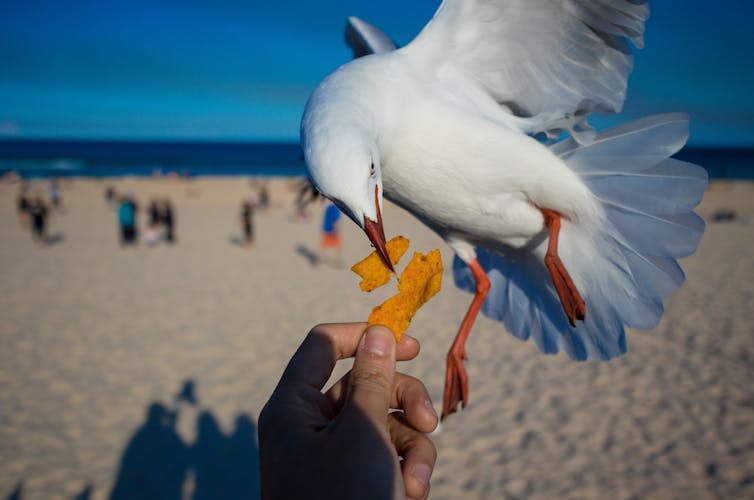
1. Seagulls Thrive In Cities
Gulls are part of “Laridae” family of seabirds and are found worldwide. While they’re synonymous with the sea, they can also thrive inland, particularly in urban areas.
Life in urban areas can be hard for birds. Without natural habitat, birds must learn to live among human-made infrastructure. However, gulls have adapted well to our highly modified landscape.
For example, research has found gulls are highly tolerant to urban disturbances, such as loud traffic and industrial noise as well as pedestrian and vehicle traffic. They have even adapted their nesting behaviour to use, for instance, ovals and flat roofs on buildings.
Gulls have a large brain relative to their body. Research suggests birds with larger brains can more successfully adapt to changing habitats and colonise new environments.
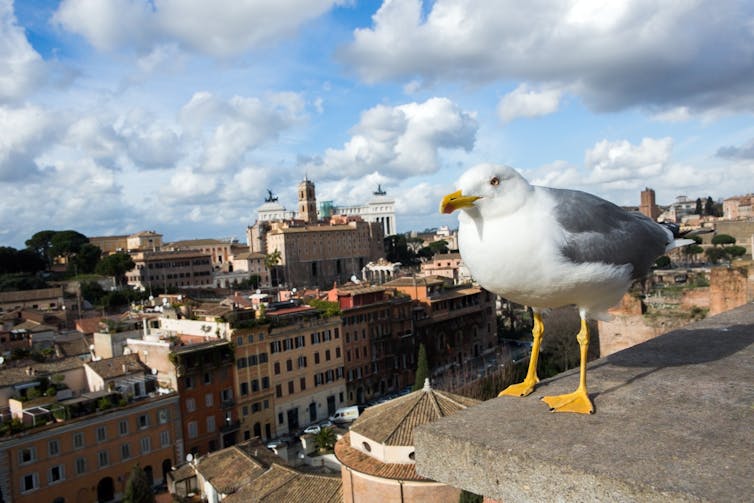
An interesting study last year tested the intelligence of ring-billed gulls, which are predominately found in Canada and northern United States.
Researchers attached a piece of sausage to a string, and placed it inside a clear box. Some 75% of the 138 gulls tested attempted to solve the task by pulling the string to bring the food closer, and 25% were successful.
This study shows gulls are curious and try to solve problems - both skills that serve them well in the urban jungle.
2. They Are Expert Food Thieves
Gulls are opportunistic feeders, meaning they will try almost any food they encounter. They’re renowned for stealing food from other gulls and even from us, a behaviour called “kleptoparasitism”.
A 2019 study showed herring gulls, found along the shores of western Europe and the UK, are aware of the direction of the human gaze. The herring gulls in the study more quickly snatched up food placed near a person, when the person was looking away from the gull.
Other research looked at how herring gulls interacted with food after they watched a person handle it. It found the gulls were much more likely to peck at food a human had handled, rather than food that hadn’t been touched.
Silver gulls in Australia have a diverse range of natural prey. This includes cnidarians (such as jellyfish), squids, insects, fish, frogs, small birds such as sparrows and wrens, plants and, when possible, small rodents.
Gulls, especially silver gulls, are also expert scavengers, and often exploit landfills. A study from 1993 recorded 6,000 silver gulls per hour leaving a single urban landfill site in Wollongong in Australia.
A more recent study in 2012 found a kelp gull breeding colony in the De La Guardia Islands of Patagonia, Chile, is sustained by food from an inland rubbish tip.
3. They Can Nest Almost Anywhere, Anytime
When conditions are right and food is plentiful, gulls can breed all year around. Peak breeding season for silver gulls is roughly between August and November and they lay one to four eggs.
Seagulls are traditionally found sleeping and nesting on flat beaches. Some gull species, including Australia’s silver gull, may create “nest scrapes” – shallow depressions in the the ground lined with, for instance, leaves and other vegetation.
Silver gulls prefer to nest in islands. But as urban development encroaches into their habitat, seagulls have adapted to roost and nest in a range of places. Their simple nest design means they can nest in grass cricket pitches, ovals, car parks, low shrubs between rocks and even flat roofs.
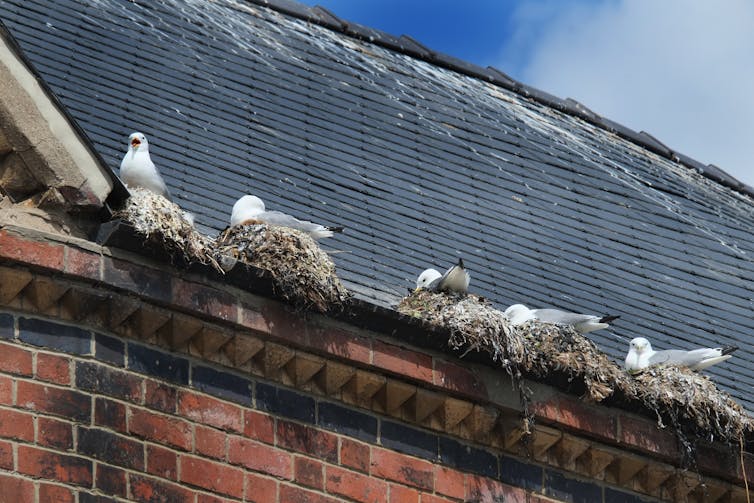
The downside for ground-nesting birds such as gulls is that they’re especially vulnerable to human disturbances, such as lawnmowers, pedestrians and their dogs, and even footy games.
Still, gulls seem to make it work. The abundance of human food seems to benefit breeding birds – a Tasmanian study on silver gulls in 2008 found urban males were heavier and had greater body condition then non-urban male gulls. Interestingly no difference were detected between females.
Further research is need to see how successful urban silver gulls are at breeding and raising young on human food.
4. They Use Teamwork To Harass Enemies
Cats (both pet and feral) are a downside to urban life for gulls. Foxes and wild dogs can also pose a significant threat.
This is where team works come in. When silver gulls detect a predator, they work together using aerial group defence tactics to drive away the threat.
One anti-predator strategy is called social mobbing. This is where a group of gulls unite to harass a potential enemy – such as a cat or fox – by flying towards it and making alarm calls, until it goes away.
Some gulls might even vomit or defecate on the predator, with startling accuracy.![]()
Grainne Cleary, Researcher, School of Life and Environmental Sciences, Deakin University
This article is republished from The Conversation under a Creative Commons license. Read the original article.
The Morrison government spent a record amount on taxpayer-funded advertising, new data reveal
Kate Griffiths, Grattan Institute and Anika Stobart, Grattan InstituteThe federal government is a big spender in the advertising world, regularly spending more than major companies such as McDonald’s, Telstra and Coles. New data released on Friday by the Department of Finance shows that in the lead-up to the May 2022 election, the Coalition government’s advertising spend skyrocketed yet again.
The past financial year was the biggest year on record for taxpayer-funded advertising. The previous federal government spent A$339 million on taxpayer-funded advertising campaigns in 2021-22, well above the 25-year average of about $200 million a year.
In the first six months of 2022, the previous government was the biggest advertising spender in the country.
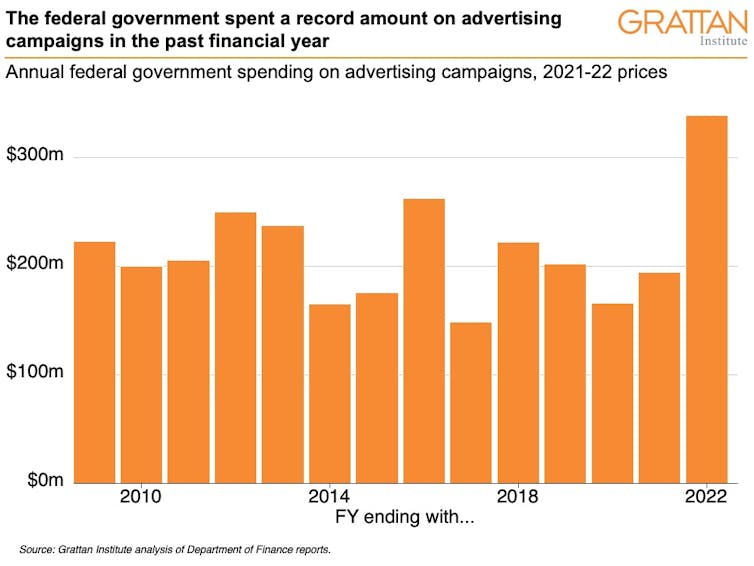
The Morrison government ran 28 separate advertising campaigns last financial year – the most on record. Many were for legitimate purposes, such as an $89 million campaign encouraging take-up of the COVID-19 vaccine, and a $25 million campaign urging people to fill out the Census.
But sometimes, taxpayer-funded advertising campaigns seek to confer a political advantage. This is often achieved by including party slogans or colours, and/or spruiking government achievements – often in the lead-up to elections.

Why Does Government Advertising Spike Before Elections?
Taxpayer-funded advertising typically spikes in election years, and 2022 was no exception.
In the six months leading up to the 2022 election, the Coalition government spent about $180 million, compared with about $120 million in the six months leading up to the 2019 election.
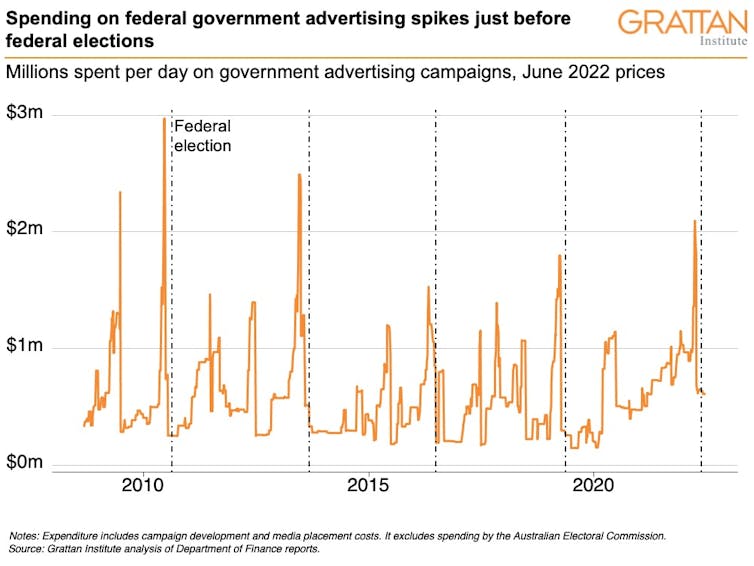
An otherwise legitimate campaign might be strategically run pre-election to encourage a positive impression of the government. For example, an $18 million federal government campaign on recycling was called out by the then-Labor opposition as “ridiculous and self-serving greenwash”.
But usually, pre-election advertising also contains messages that look politically motivated – promoting the government’s policy platform on key election issues.
For example, the $28.5 million Emissions Reduction campaign – the third most expensive campaign of the year – ran from September 2021 to April 2022, and sought to promote the government’s “good progress” on reducing greenhouse emissions and switching to renewable energy. The campaign clearly used messaging that created a positive image of the government’s performance, and lacked a call to action that might justify it on public interest grounds.
Grattan Institute analysis shows that typically, about a quarter of government spending on advertising is politicised in some way, by both sides of politics. Historically, about $50 million on average each year has been spent on campaigns that are politicised.
The former government’s “COVID-19 Economic Recovery Plan” fell into this category, because it blatantly spruiked the government of the day, without requiring any action or behaviour change from citizens.
Officially, the campaign sought “to inform Australians about the government response to the recurring challenges being faced and reassure [us] there was an adaptable and future-focused plan in place for the economy”.
This was criticised by Labor Senator Tim Ayres in early 2022, who asked:
What possible public purpose is there in ‘Australia’s Economic Plan – we’re taking the next step’? […] What is it asking people to do apart from vote Liberal?
Why Is Politicisation Of Taxpayer-Funded Advertising Harmful?
Politicisation of taxpayer-funded advertising is wasteful and creates an uneven playing field in elections.
Government advertising budgets are well above the expenditure of individual political parties, even in election years.
We won’t know until February 2023 how much political parties spent in the 2022 federal election. But in the lead-up to the 2019 election, the Coalition spent $178 million, Labor $122 million, and Clive Palmer $89 million, with advertising only a portion of their expenses.
How Things Should Change
The new federal government has announced it will cut taxpayer-funded advertising, although by how much is not yet clear. Labor has promised to tackle advertising as part of its broader “rorts and waste” audit.
That promise to cut wasteful spending will be best tested by whether Labor tightens the rules and oversight for government advertising.
Public money should not be used to spruik government policies. It should be used only on public-interest advertising campaigns that have a clear “need to know” message and a call to action.
An independent panel should be established to check compliance. The panel should have the power to knock back campaigns that aren’t compliant – whether they are politicised, or more generally don’t offer value for money.
And if the rules are broken, then the political party – not the taxpayer – should foot the bill for the entire advertising campaign.
Establishing a proper process is the only way to truly reduce waste and restore public confidence in genuinely important government messages.
Kate Griffiths and Anika Stobart are coauthors of New politics: Depoliticising taxpayer-funded advertising, Grattan Institute, 2022.![]()
Kate Griffiths, Deputy Program Director, Grattan Institute and Anika Stobart, Senior Associate, Grattan Institute
This article is republished from The Conversation under a Creative Commons license. Read the original article.
Brekkies, barbies, mozzies: why do Aussies shorten so many words?
Kate Burridge, Monash University and Howard Manns, Monash UniversityAustralians sure do like those brekkies, barbies and mozzies.
We’re not talking about “actual” mozzies here. We’re defo (definitely) talking about words — and Aussies can’t seem to get enough of these shortened words.
Some say we’re lazy for clipping them. Others claim it’s just Aussies knocking words down to size — ta, we’ll have a glass of cab sav or savvy b instead of whatever that is in French.
Our most beloved shortenings end in -ie/y and -o. Journos often ask us why Aussies use them, and whether they’ll last. Well, not only are we still using them, seppos (Americans) and pommies (Brits) are joining the action, too.
Here’s an uplifting story for your hollies (holidays) about Australia’s “incredible shrinking words”.
Endings That Bond And Bind Us
These alternative forms of words are often described as “diminutives” (or hypocoristics).
Pet names with such endings can show we have a warm or simply friendly attitude toward something or someone (think of the -s on Cuddles). Certainly, on names, -ie/y and -o are often affectionate (think Susy and Robbo).
But the vast majority of Aussie diminutives are doing something different.
Indeed, saying journo or pollie doesn’t usually indicate we’re thinking of journalists and politicians as small and endearing things. These “diminutives” are also a world away from the birdies and doggies of the nursery. Adult Australians might cheerfully talk about blowies and trackies, but not birdies and doggies — well, unless it’s on the golf course or perhaps in reference to the Western Bulldogs getting a specky (spectacular mark).
For Australian National University linguist Anna Wierzbicka, these expressions are among the most culturally salient features of Australian English — expressions of informality and solidarity that are “uniquely suited to the Anglo-Australian ethos […] and style of interaction”.
Experiments by Australian linguists have empirically confirmed the social effects of these embellished words. Colloquialisms such as barbie and smoko are like accents – part of the glue that sticks Australian English speakers together.
Are -Ie/Y Endings Darlings Or Weaklings?
Diminutives can die out when they take on the burden of new social meanings. One of the oldest endings (found as far back as Anglo-Saxon times) is -ling. We see it still on words like twinkling and darling. However, by modern times it had flipped and become contemptuous, especially when used of humans (think of weakling and underling).
In contrast to -ling, our -ie/-y endings carry important, positive meanings, and there’s no sign yet that we’re giving up on them. Those sunnies, scungies, boardies, cozzies, stubbies and trackies are still the stuff of our sartorial summer fashion.
Slang might come and go, but the process that transforms sunglasses into sunnies and tracksuit pants into trackies continues to thrive.
So thriving in fact are these expressions that some are among Australia’s successful exports. International celebrities include greenie, pollie, surfie, mozzie, budgie (and its offshoot budgie smugglers).
And let’s not forget the linguistic rockstar that is selfie – its meteoric rise to stardom in 2013 saw it crowned Word of the Year by Oxford Dictionaries, and also by the Van Dale dictionary in the Netherlands.
We are, however, constantly refreshing our stock of -ie/y words. Many of the gems in Wendy Allen’s 1980s collection of youth slang in Melbourne (Teenage speech) have bitten the dust (for example, scottie from “he’s got no friends” -> “s’got no friends” -> “s’got + ie”).
But the second edition of the Australian National Dictionary shows us how many -ie/y words have proliferated since the 1980s/1990s (firie, tradie, trackie daks).
Bottle-O, Milko And Smoko: Still Alive-O?
That other long-time favourite ending -o occurs all round the English-speaking world. However, as the Oxford English Dictionary describes, its use “is especially associated with Australia”.
The earliest Australian examples (like milko, rabbito, bottle-o) date from the 19th century and are abbreviated nouns referring to a person’s trade (“milkman”, “rabbit-seller” “bottle-collector”). Sometimes they appear with -oh because of their association with street calls, and this use is old – think of those cockles and mussels of 18th century London, all very much “alive, alive-oh”.
Our love of this -o suffix may also owe something to Irish English. However, Australian linguist Jane Simpson points out it has much wider applications in Australia (and New Zealand), as shown by place names such as Rotto (Rottnest Island), Freo (Fremantle), Paddo (Paddington) and common nouns such as compo (compensation), ambo (ambulance driver) and bowlo (bowling club). And we’re exporting these too – demo, preggo and muso have made it into the wider world.
As with -ie/y endings, our -o endings don’t seem to be going anywhere in a hurry. However, their long-term survival seems slightly less assured than -ie/y. We’re still seeing newer coinages (such as housos), but a 2011 study suggests young people might be using this one less than previous generations.
Rellies Or Rellos, Garbies Or Garbos: Is There A Pattern?
There are wharfies and truckies but not wharfos and truckos; garbos and musos but not garbies and musies. People who ride motorcycles are generally bikers; those who belong to motorcycle gangs tend to be bikies.
So what’s wrong with bikos? And why are there gaps? Those who build houses are neither buildos nor buildies.
Undoubtedly there are nuanced differences of meaning involved here. Does weirdie describe unconventional people more affectionately than weirdo, or even weird person? Certainly there’s a world of difference between the sicko (psychologically sick person) and the sickie (leave you take when you’re sick – or is that when you’re not sick?).
You tell us: do you prefer a lammo or a lammie for the small chocolate and coconut–covered cake? And are members of your family rellos or rellies? There’s a lot of lexicographers, linguists and other word nerds who haven’t figured this out.![]()
Kate Burridge, Professor of Linguistics, Monash University and Howard Manns, Senior Lecturer in Linguistics, Monash University
This article is republished from The Conversation under a Creative Commons license. Read the original article.
Following Alfred Russel Wallace’s footsteps to Borneo, where he penned his pioneering evolution paper
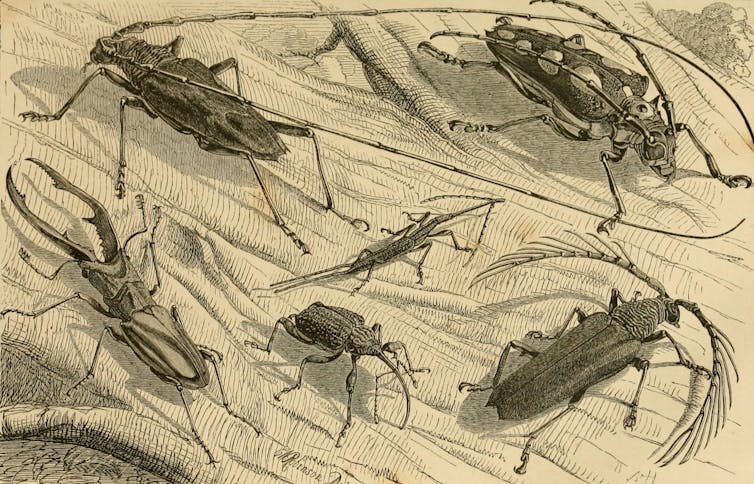
The chirping of cicadas is deafening, my clothes are sticky and heavy with heat and sweat, my right hand is swollen from ant bites, I am panting, almost passing out from exhaustion – and I have a big grin on my face. At last I’ve reached my goal, Rajah Brooke’s cottage, at the top of Bukit Peninjau, a hill in the middle of Borneo’s jungle.
This is where, in February 1855, naturalist Alfred Russel Wallace wrote his hugely influential “Sarawak Law” paper. It’s as crucial to Wallace’s own thinking in disentangling the mechanisms of evolution as the Galàpagos Islands famously were to his contemporary, Charles Darwin.
Three years later, in 1858, two papers that would change people’s understanding of humanity’s place in the natural world were read before the Linnean Society of London. Their authors: Charles Darwin and Alfred Russel Wallace. In another year, Charles Darwin would publish “The Origin of Species,” squarely positioning him as the father of evolution. Whether Darwin or Wallace should justly be credited for the discovery of the mechanisms of evolution has stirred controversy pretty much ever since.
Comparatively little has been written about Wallace’s seminal work, published four years earlier. In what’s commonly known as his “Sarawak Law” paper, Wallace pondered the unique distribution of related species, which he could explain only by means of gradual changes. This insight would ultimately mature into a fully formed theory of evolution by natural selection – the same theory Charles Darwin had arrived at independently years before, but had not yet published.
I am an evolutionary biologist who has always been fascinated by the mechanisms of evolution as well as the history of my own field, and it’s like visiting hallowed ground for me to trace Wallace’s footsteps through the jungle where he puzzled through the mechanics of how evolution works.
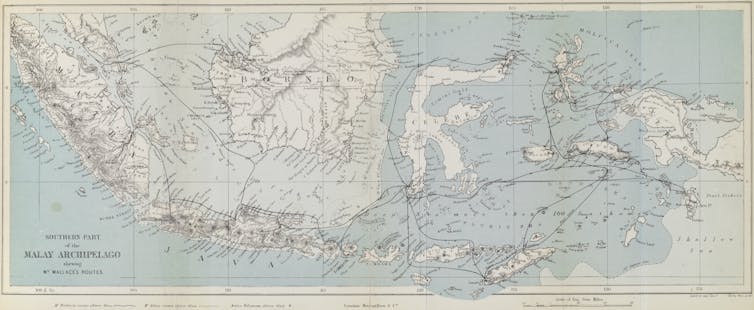
Forgotten Founder Of Evolutionary Theory
Born on Jan. 8, 1823, Alfred Russel Wallace, originally a land surveyor from a modest background, was a naturalist at heart and an adventurer. He left England to collect biological specimens in South America to finance his quest: to understand the great laws that shape life. But on his trip back home, the ship caught fire and sank, leading to the loss of all the collected specimens and a near-death experience for Wallace himself.

To make back the money he’d lost in the shipwreck, he headed to the Malay Archipelago, a region to which few Europeans had ever ventured. Wallace spent time in Singapore, Indonesia, Borneo and the Moluccas.
There he wrote a succinct yet brilliant paper, which he sent to Charles Darwin. In it, he described how organisms produce more offspring than necessary, and natural selection favors the most fit. The ideas he’d arrived at on his own were revolutionary – and closely mirrored what Darwin had been mulling over himself.
Receiving Wallace’s paper – and realizing that he might be scientifically “scooped” by this unknown naturalist – prompted Darwin to rush his own writings, resulting in the presentation to the Linnean Society in 1858. Wallace’s paper, now known as the “Ternate paper,” was an elaboration of his thinking, based on an earlier first foray into the realm of evolutionary biology.
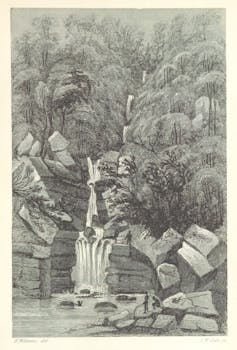
A few years earlier, when in Singapore, Wallace had met James Brooke, a British adventurer who, through incredible circumstances, had become the rajah of Sarawak, a large state on the island of Borneo. James Brooke would create a dynasty of Sarawak rulers, known as the white rajahs.
Upon their encounter, Brooke and Wallace became friends. Wallace fell in love with Sarawak and realized that it was a perfect collecting ground, mostly for insects, but also for the much sought-after orangutans. He stayed in the area a total of 14 months, his longest stay anywhere in the archipelago. Toward the end of his sojourn, Wallace was invited by Brooke to visit his cottage, a place up on the Bukit Peninjau that was pleasantly cool, surrounded by a lush and promising forest.
Wallace described it in his own words:
“This is a very steep pyramidal mountain of crystalline basaltic rock, about a thousand feet high, and covered with luxuriant forest. There are three Dyak villages upon it, and on a little platform near the summit is the rude wooden lodge where the English Rajah was accustomed to go for relaxation and cool fresh air. … The road up the mountain is a succession of ladders on the face of precipices, bamboo bridges over gullies and chasms, and slippery paths over rocks and tree-trunks and huge boulders as big as houses.”
The jungle surrounding the cottage was full of collecting possibilities – it was particularly good for moths. Wallace would sit in the cottage’s main room with the lights on at night, working, sometimes furiously fast, at pinning hundreds of specimens. In just three evening sessions, Wallace would write his “Sarawak Law” paper in this remote setting.
Whether consciously or not, Wallace was laying the foundation for understanding the processes of evolution. Working things through in this out-of-the-way cottage, he started to synthesize a new evolutionary theory that he’d fully develop in his Ternate paper.
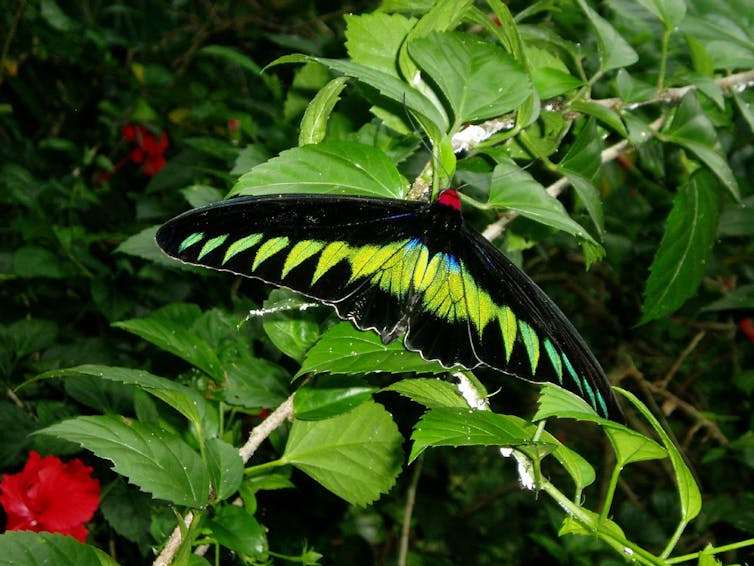
Following In Wallace’s Sarawak Footsteps
I’ve been teaching evolution to college students for over two decades and have always been fascinated by the story of the “Sarawak Law” paper. On a recent trip to Borneo, I decided to try to retrace Wallace’s steps up to the cottage to see for myself where this pioneering paper was written.
Tracking down information about the exact location of Bukit Peninjau turned out to be a challenge in itself, but after a few mistakes and contradictory directions obtained from local villagers, my 16-year-old son Alessio and I found the trailhead.
The moment we started, it was obvious we had ventured off the beaten path. The trail is narrow, steep, slippery and at times barely recognizable as a path. The very steep incline, combined with the heat and humidity, make it difficult to negotiate.

While much has disappeared since Wallace’s time, a huge diversity of life forms is still visible. In the thick of the jungle along the lower part of the trail, we spotted several stands of the tallest flower in the world, the aptly named Amorphophallus. Hundreds of butterflies were everywhere, along with other peculiar arthropods, including giant ants and giant pill millipedes.
In some stretches, the trail is so steep that we had to rely on the knotted ropes that have been installed to help with the climb. Apparently red ants love those ropes as well – and our grasping hands just as much.

Eventually, after about an hour and a half of climbing and struggling, we reached a somewhat flat portion of the trail, not more than 30 feet (9 meters) long. On the right, a small path led up to a clearing, the former site of the cottage. It’s hard not to imagine Alfred Russel Wallace, thousands of miles from home, in complete scientific isolation, pondering the meaning of biological diversity. I was at a loss for words, though my teenage son was puzzled by the emotional meaning of the moment for me.
I walked around the cleared space where the cottage used to be, imagining the rooms, the jars, the nets, the moths and the notebooks. It’s an incredible feeling to share that space.
We walked down a slope to the huge overhanging rock where Brooke and Wallace found “refreshing baths and delicious drinking water.” The pools are gone now, filled in with natural debris, but the cave is still a welcome shelter from the sun.

We decided to climb to the top of the hill. Thirty minutes and buckets of sweat later, we arrived at a viewpoint where we could take in a view of the entire valley, unobstructed by the jungle. We saw oil palm farms, houses and roads. But my focus was on the river in the distance, used by Wallace to reach this place. I imagined what the primary forest, full of orangutans, birdwing butterflies and hornbills, must have looked like 160 years ago.
In the midst of this gorgeous but very harsh environment, Wallace was able to keep a clear head, think deeply about what it all meant, put it down on paper and send it to the most prominent biologist of the time, Charles Darwin.
Like many other evolution aficionados, I’ve visited the Galàpagos Islands and retraced Darwin’s footsteps. But it’s in this remote jungle, far from anyone and anything – perhaps because of the physical difficulties of reaching Rajah Brooke’s cottage combined with the raw beauty of the surroundings – that I felt a deeper connection with that long-ago time, when evolution was discovered.![]()
Giacomo Bernardi, Professor of Ecology & Evolutionary Biology, University of California, Santa Cruz
This article is republished from The Conversation under a Creative Commons license. Read the original article.
High, Supreme, Federal, Family, County – what do all our different courts actually do?
David Heilpern, Southern Cross UniversityOne way to understand how the courts in Australia are ranked is to imagine a pyramid and an umbrella.
Let’s start with the pyramid. Imagine three lines horizontally across the pyramid dividing it into four sections. Each section represents a court of each state or territory.
So what’s on the base of the pyramid, and what are the upper layers?
The Local Or Magistrates Courts
The bottom section represents the local or magistrates courts. It is biggest because it deals with the vast majority of court cases in Australia.
There is a single judicial officer presiding, and no jury. The bread and butter of these courts are minor crimes such as traffic offences, lesser assaults, shoplifting and possession of prohibited drugs.
These courts also have other roles including being children’s and coroners’ courts. They also deal with less serious civil disputes, where one person or company is suing another (under certain limits; in New South Wales, for example, that limit is A$100,000).
Local courts also deal with apprehended violence and restraining orders. The maximum sentence that can be handed out by a judge in a local court is generally two years imprisonment.
The other reason the bottom section of the pyramid is biggest is because all criminal matters start in the local court. The more serious ones work their way up to the higher courts for sentence or trial.
The District Court
The next section up the pyramid represents the District Court.
They deal with more serious crime such as sexual assault, major drug supply and high-level violence.
If the person on trial doesn’t plead guilty, there is a jury to determine guilt or innocence.
The district court also deals with serious civil disputes, generally where the amount is up to $750,000.
The Supreme Court
The Supreme Court is the next layer of the pyramid. It deals with the most serious civil and criminal cases, such as murder. They mostly have a jury in criminal cases.
They also deal with some specialty areas such as defamation.
The Courts Of Appeal
Finally, there is the Courts of Appeal, which are part of the Supreme Court, but sit above it.
They hear appeals from lower courts, and there are usually three judges sitting on each matter.
The really interesting aspect of the pyramid is that it represents not just more seriousness and less volume as you go up, but also the appeal process.
So, if you want to appeal from the Local Court, then you go the District Court, then from the District to the Supreme Court and so on.
The “doctrine of precedent” means rulings from higher courts are binding on lower ones.
The High Court And The Umbrella Model
But what if you want to appeal from the Court of Appeal? That’s where the umbrella comes in.
That appeal is to the High Court, which you can imagine as an umbrella that sits over each of the state or territory pyramids.
There is one High Court, based in Canberra, and its decisions are final, and binding throughout all parts of Australia.
Fun fact: up until the 1980s the highest court for Australia was in England! Called the Privy Council, it was possible to appeal from state and federal courts and let English law lords be the final decider. But Australia got rid of that system and now the highest court in the land is the High Court.
Some State-Based Variations
Is it all that simple? Not really.
First, in Tasmania the Australian Capital Territory and the Northern Territory there is no District Court level at all. These are small states and territories, with not enough people to necessitate this level of the pyramid.
Second, sometimes appeals jump a level. For example, they may go straight from the Local Court to the Supreme Court. And in some states, there are different names for each level. In Victoria the District Court is called the County Court, and in some places like the Northern Territory, magistrates are called judges.
Finally, there are some specialty courts like the NSW Land and Environment Court that sit at Supreme Court level.
Hang On, What About Federal Courts?
Just when you thought you had your pyramids in a row, along comes another complication: the federal system.
The Constitution divides up powers between the states and the Commonwealth.
The best example is family law, which is allocated to the Commonwealth and so the Federal Court system deals with divorce and related matters.
And so there is another pyramid which works across the whole country only this time it has two levels.
The lowest and biggest level is the Federal Circuit and Family Court of Australia, dealing mostly with family law (but also other federal matters such as immigration and welfare law).
The next level up is the Federal Court, which deals mainly with corporations law, bankruptcy and trade practices as well as hearing appeals from the lower court.
Don’t forget the umbrella, the High Court, which also hears appeals from the Federal Court.
A Whole Myriad Of Tribunals
I’m sorry to have to tell you it gets even more complex from there. There are also tribunals.
Sitting beneath the state, territory and federal court systems is a whole myriad of tribunals which deal with non-criminal matters.
New South Wales, for example, has the New South Wales Civil and Administrative Tribunal (NCAT), which deals with tenancy, consumer, guardianship, strata and licensing matters. It even has its own appeal panel as well (and if people still aren’t happy, they can then appeal to the courts).
The members of the tribunal are not judicial officers and are appointed for fixed periods.
Of course, if you were to strike out centuries of history and start afresh, you would likely just have one multilayered pyramid across the country with a single tribunal at the foot, and the High Court at the top.
We can live in hope. ![]()
David Heilpern, Associate Professor and Chair of Discipline (Law), Southern Cross University
This article is republished from The Conversation under a Creative Commons license. Read the original article.
Uber plans a kids service to replace mum and dad’s taxi. What’s wrong with that? Plenty

Ride-share company Uber has just rolled out an option to book vehicles equipped with a children’s car seat across Melbourne. Uber is also considering allowing unaccompanied children to use its service.
In Australia, a recent study found most parents remain unwilling to let their children use a ride-share service unaccompanied. (Uber policy, like most ride-sharing companies, currently requires a solo passenger to be over 18.) There appears to be more acceptance in countries such as the United States where child-specific ride-shares are more widespread.
Many time-poor families are desperate for better alternatives to having to drive their children everywhere they need to go. There are indeed high social, economic and environmental costs associated with parental taxis.
But outsourcing this role to ride-share services is not the best solution. It will reinforce an over-reliance on cars, which is demonstrably harmful for children’s health and wellbeing.
What Are Parents’ Main Concerns?
The Australian study identified several factors that mattered to parents. These included:
being able to decide the route of the vehicle
who is able to drive and ride in the vehicle
the presence of a designated adult waiting at the child’s destination
technological features such as GPS tracking and two-way cameras to communicate with the child during the trip.
Clearly, a few roadblocks need to be overcome before these services gain broader appeal for families with children in Australia. But what would be the impact if they did go ahead? We should consider both the problems these services could solve and the problems they might create.
“Busy parents” is a phrase that comes up often when talking about children’s transport challenges and solutions. Child-specific ride-sharing seems to be a logical response to that problem. And Uber is not the the first car service for kids in Australia.
However, the benefits gained from these “care-drivers” (driver/babysitter) are likely to be offset by new anxieties for parents.
In particular, parents worry about their children’s safety in the company of an unknown adult. When it comes to trusting a service to transport unaccompanied children, Australian research found parents were more likely to voice concerns about ride-share services than autonomous vehicles.
This is likely to remain the case despite technologies enabling real-time monitoring of the child and other desired features of the ride-share vehicle. And these surveillance technologies raise additional ethical questions.
There’s Also Health And Wellbeing To Consider
Children’s dependence on cars to get around also affects their health. The risks range from road safety issues, noise and air pollution to being less active physically. A ride-share service for children would reinforce their families’ car dependence and the associated health issues.
Any child-specific ride-share service is also likely to magnify existing social and economic issues. To name a few:
the services would tend to be exclusive in nature, being more accessible for those who are well-off and able-bodied
passive commuting in cars would become even more passive in the absence of adults known to the children, further reducing their opportunities to construct their social identities and develop independence and self-reliance – parents, too, could have fewer opportunities to interact with each other and the broader community at school or sport events
both parents and children place a high value on the togetherness aspect of family trips to schools and extra-curricular activities, even when travelling by car. Child-only ride-share services would reduce the time spent together.

It All Comes Down To Car Dependence
The heavy reliance on private cars by families with children is one of the key challenges facing most WEIRD (Western, educated, industrialised, rich and democratic) countries. The emergence of ride-share services for children highlights the difficulties with children’s lifestyles dominated by the need to get to extra-curricular activities, often at non-local places.
Like any profit-driven approach, this kind of service raises concerns about exploitation of system-wide weaknesses. In this case, it’s the transport challenges faced by families with children.
These “solutions” also undermine various policies and programs that aim to create more socially and environmentally just communities. These include, for example, local living policies – such as so-called 20-minute neighbourhoods – which are central to most planning strategies across Australia.
Allowing unaccompanied kids to travel in high-tech, ride-share vehicles might help some parents in the short term. In the long term, though, it will create more complex problems. These parallel many of the well-reported issues associated with lives and societies shaped by the car – known as automobility.
Happier and healthier children should be the lens to look through at any new approaches to how children get around. Plenty of equitable and cost-effective solutions exist. The most obvious involve creating the social and environmental conditions for safe and convenient walking, cycling and public transport.
Having these solutions available instead of having to drive children would help time-poor families. And children can use all these transport options in groups, which eases safety concerns. There are, for example, walking school buses and bike trains.
People and cities have much to gain from a move away from a narrow view of technology – such as retrofitting cars for monitoring and controlling children. Instead, we can use technology to promote healthier, greener and more equitable ways of getting around.![]()
Hulya Gilbert, Lecturer in Planning and Human Geography, La Trobe University
This article is republished from The Conversation under a Creative Commons license. Read the original article.
Is there a ‘right to disobey’? From the Vietnam War to today’s climate protests

One of the first moves of the newly elected Whitlam Labour government in December 1972 was to free seven men imprisoned for their beliefs. Their crime had been refusal to comply with the National Service Act, a so-called “lottery of death” that sent some 15,300 young Australians to fight in Vietnam. Two hundred of them never came home.
The issue of national service – often dubbed “the draft” following American vernacular – was perhaps the most powerful in the anti-war movement’s arsenal. “Draft resisters” mobilised public sentiment with their heroic stands, respectable mothers campaigned to “Save our Sons” and, as I explore in a newly published book chapter, the Australian wing of Amnesty International classed these men as “prisoners of conscience”.
Today, Australia grapples again with the question of criminalising conscience. Laws in several Australian states impose harsh penalties on the use of “direct action” by climate change activists. Fifty years ago, similar questions of a right to disobey sparked fierce debates: where should the legal limits of conscience lie?

In Australia, It Is A Crime Not To Kill
National service was re-introduced in Australia in 1964, with a previous scheme having quietly ended in 1959. The first “nashos” were committed to Vietnam in 1966. The scheme was highly selective – by its end some 800,000 20-year-olds had registered and less than 10% had been “called up”.
Opposition to national service emerged almost immediately, through such groups as the Youth Campaign Against Conscription. In November 1966, Sydney schoolteacher Bill White became the first person imprisoned for failure to comply with the act. He had applied for conscientious objector status almost a year earlier, but been denied because he did not fit the strict criteria.
Public outrage played a part in White’s early release in December 1966, but over time penalties became more harsh. John Zarb, a part-time postman, received a two-year sentence in October 1968 for refusing to comply with his call-up notice. His opposition to the Vietnam war only, rather than war in general, made him ineligible for objector status.
These moral-political stances encouraged further opposition. As well as releasing jailed objectors, Whitlam’s incoming government threw out cases against 350 individuals. For the anti-war movement, these cases demonstrated the conflict’s contradictions. As one activist leaflet put it: “In Australia, it is a crime not to kill.”
The Politics Of Conscience
To a nascent human rights movement, however, the issue was not as clear-cut. Amnesty International, founded by the British lawyer Peter Benenson in 1961, established an early foothold in Australia. A Victorian section was founded in March 1962, and groups in other states soon followed.
One of the group’s appeals was its rejection of “Cold War” politics. By adopting “prisoners of consciences” from the first, second and third worlds, they could claim impartiality, while the use of letter writing as a tactic invoked the power of global opinion.
Yet the definition of a prisoner of conscience in the group’s early years proved controversial. To meet Amnesty’s definition, a prisoner needed to have been jailed for crimes of opinion and have not advocated violence. Infamously, this definition excluded Nelson Mandela. For Amnesty, the question of whether objectors like White or Zarb should be considered prisoners of conscience divided the Victorian and New South Wales sections.

The Victorians believed those who “register for national service and apply for exemption”, but whose “applications fail either through some apparent miscarriage of justice or because the law does not presently encompass their objections […] are prima facie eligible for adoption”. However, those who “basically refuse to co-operate with the National Service Act” merely “maintain a right to disobey a law which they believe to be immoral” – and adopting them would “seriously damage […] our high repute”.
The New South Wales section condemned this “legalistic interpretation”. Instead, it insisted “the Non-Complier in gaol for conscientiously held […] views suffers no less than one who has tried in vain to act ‘according to the law’ ”. The Victorians’ belief that Amnesty should accept some degree of compulsion in democratic societies was also challenged: conscription was in fact a universal problem that occurred on both sides of the “Iron Curtain”.
Is It Right To Resist?
In the end, the views of the New South Wales section won out. Amnesty sections around the world adopted Australian non-compliers.
This clash of principles reminds us that human rights have never been straightforward. Rather, these ideas have long been open to contest and reinterpretation. From today’s vantage point, it also seems the Victorian section’s belief that the right to disobey could be limited was wildly optimistic.
Indeed, the sentencing of climate protester Deanna “Violet” Coco to 15 months in jail for the crime of disrupting traffic in New South Wales shows that the questions posed by Amnesty in the 1960s are very much still with us. The climate emergency is in many ways the Vietnam of today’s young people. The 50th anniversary of the release of resisters to that conflict should give today’s decision-makers pause for thought.![]()
Jon Piccini, Lecturer in History, Australian Catholic University
This article is republished from The Conversation under a Creative Commons license. Read the original article.
William Wordsworth and the Romantics anticipated today’s idea of a nature-positive life
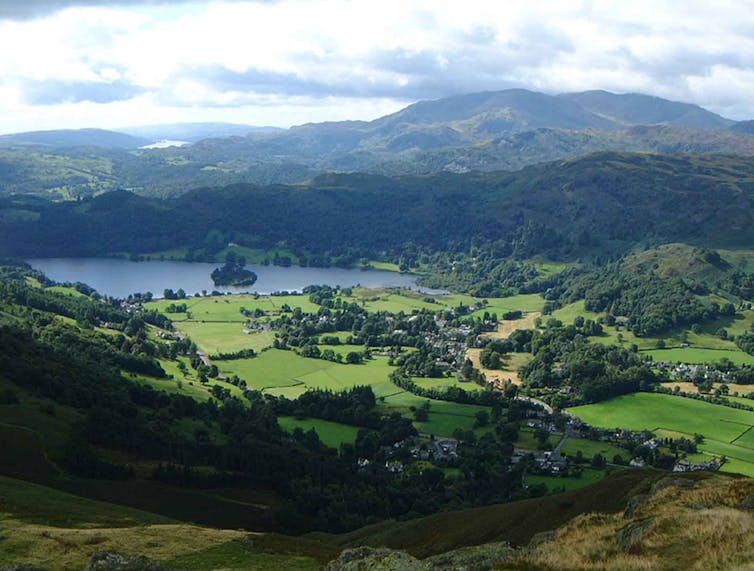
Musical performances usually happen in concert halls or clubs, but famed cellist Yo-Yo Ma is exploring a new venue: U.S. national parks. In a project called Our Common Nature, Ma is performing in settings such as the Great Smoky Mountains and the Grand Canyon. By making music and bringing people together in scenic places, Ma aims to help humans understand where they fit in the natural world.
“What if there’s a way that we can end up thinking and feeling and knowing that we are coming from nature, that we’re a part of nature, instead of just thinking: What can we use it for?” Ma mused in a recent New York Times article.
There’s a buzzword for this outlook: nature-positive. And it’s cropping up at high-level meetings, including the 2021 G-7 summit in Cornwall, England and the COP15 biodiversity conference in Montreal that adopted an ambitious framework for protecting nature in December 2022.
As a group of environmental leaders wrote in 2021: “A nature positive approach enriches biodiversity, stores carbon, purifies water and reduces pandemic risk. In short, a nature positive approach enhances the resilience of our planet and our societies.”
This is a dramatic shift from the mentality that has driven industrialization and global economic growth over the past 250 years. But it’s not new. As a researcher in the humanities and author of “Radical Wordsworth: The Poet Who Changed the World,” I see nature positivity as a welcome revival of an outlook that English poet William Wordsworth and other Romantics proposed in the late 1700s.
The Birth Of The Sublime
In the preindustrial era, when life was dominated by hard manual labor, wild nature wasn’t viewed as a terribly attractive place. In the 1720s, writer Daniel Defoe, touring across the island of Great Britain, denounced the mountains and lakes of northwest England as “the wildest, most barren and frightful of any that I have passed over.”
The mountains were horrible to look at, impossible to pass over and, worst of all, had “no lead mines and veins of rich ore, no Coal Pits,” Defoe wrote. They were “all barren and wild, of no use or advantage either to Man or Beast.”
Attitudes began to change a generation later, with the expansion of a middle class that had the leisure and resources to enjoy a spot of tourism. Early guidebooks gave directions to viewpoints, or “stations,” that opened onto spectacularly beautiful vistas.
Philosophers and poets began to view natural phenomena such as ocean waves, lightning flashes over a mountain or the darkness of old-growth forests with awestruck pleasure rather than fear. They called these sights the “sublime,” a word that we still reach for when contemplating, say, the vastness of the Arctic or the Amazon. As Barry Lopez, author of “Arctic Dreams,” once wrote, the “sublime encounter” with such places offers us a profound “resonance with a system of unmanaged, nonhuman-centered relationships”.
Romanticism emerged as the steam engine and the spinning jenny were driving mass urbanization. As workers flocked from farms to grimy cities in search of manufacturing jobs, a reaction set in: yearning for a return to nature. This became the hallmark of the Romantic movement that flourished across Europe through the mid-1800s.
‘A Sort Of National Property’
Many writers, thinkers and artists contributed to this outpouring of nature-positivity. Beethoven’s Pastoral Symphony and the paintings of J. M. W. Turner are examples. But in the English-speaking world, none were more influential than Wordsworth (1770-1850).
Born and raised in England’s Lake District, Wordsworth felt alienated from fellow students at Cambridge. As an aspiring journalist in London, he was stunned to discover that many people did not know their next door neighbor’s name. Only when Wordsworth returned to nature – first in the English west country and then when he went home to the Lakes – did he become his true self and write his greatest poetry.
In verse and prose, Wordsworth made a series of revolutionary claims. In the preface to his 1800 collection of poems, “Lyrical Ballads,” he argued that men and women who live indigenously within a natural environment are uniquely in tune with “the essential passions of the heart” because their very humanity is “incorporated with the beautiful and permanent forms of nature.”

In his “Guide to the Lakes,” Wordsworth warned against such innovations as planting non-native conifers that spoiled the beauty and eroded the soil of his native region. Instead, he proposed preserving places of outstanding natural beauty like the Lake District as “a sort of national property.”
This idea later would help to inspire the U.S. national park system and England’s National Trust. Today the concepts of conservation zones and protected areas are central to the goal of a nature-positive world.
Inspired by Wordsworth’s idea that the health of human society depends on a healthy relationship with the environment, the great Victorian social thinker John Ruskin turned economic theory on its head. In polemical pamphlets and public lectures, Ruskin argued that the basis of what was then known as “political economy” should be not labor and capital, production and consumption, but “Pure Air, Water, and Earth.”
Almost exactly 150 years later, on July 28, 2022, the United Nations General Assembly adopted a resolution recognizing a universal human right to a clean, healthy and sustainable environment.
Colonial Conservation?
Wordsworth’s influence on the conservation movement wasn’t entirely benign. Late in life, he lamented that his very advocacy of the beauty of the Lake District had brought in a mass tourist industry that had the potential to destroy the very beauty he sought to preserve.
Furthermore, protecting wild places risks displacing indigenous peoples who have lived in harmony with the land for centuries. Creating conservation zones and protected areas in the rain forests of Central America and the Amazon basin has sometimes shut out local tribes.
Organizations such as the Sierra Club and the U.S. National Park Service are now striving to transcend this long history of “colonial conservation.” The importance of working together with indigenous peoples and learning from their time-honored values and conservation practices received new attention at major conferences on climate change and biodiversity in 2022, although some observers argued that the resulting commitments fell short of what was needed.
In my view, Wordsworth knew that the truly nature-positive are those whose livelihoods and senses of self and community are wholly bound to their native places. As he wrote in “Michael,” the great pastoral poem at the climax of “Lyrical Ballads”:![]()
And grossly that man errs, who should suppose
That the green valleys, and the streams and rocks,
Were things indifferent to the Shepherd’s thoughts.
... these fields, these hills
Which were his living Being even more
Than his own blood—what could they less? had laid
Strong hold on his affections, were to him
A pleasurable feeling of blind love,
The pleasure which there is in life itself.
Jonathan Bate, Foundation Professor of Environmental Humanities, Arizona State University
This article is republished from The Conversation under a Creative Commons license. Read the original article.
Over the holidays, try talking to your relatives like an anthropologist

How is it possible to spend so much time with your parents and grandparents and not really know them?
This question has puzzled me as an anthropologist. It’s especially relevant for the holiday season, when millions of people travel to spend time with their families.
When my parents were alive, I traveled long distances to be with them. We had the usual conversations: what the kids were doing, how the job was going, aches and pains. It wasn’t until after my parents died, though, that I wondered whether I really knew them in a deep, rich and nuanced way. And I realized that I’d never asked them about the formative periods of their lives, their childhoods and teenage years.
What had I missed? How had this happened?
In fact, I had interviewed my mother a few years before her death. But I only asked her about other relatives – people I was curious about because my father’s job had taken us to places away from the rest of the family. I based my questions for my mother on the bit of information I already had, to build a family tree. You might say I didn’t know what I didn’t know.
I decided to research the kinds of questions that would have elicited from my mother things about her life that I had no clue about and that now remain hidden and lost forever. I interviewed older people to develop questions that would paint a vivid picture of a person’s life as a child and teenager. I wanted details that would help me see the world that had influenced the person they became.
So I used my training as an anthropologist to ask the type of questions an anthropologist would ask when trying to understand a way of life or culture they know little about. Anthropologists want to see the world from another person’s point of view, through a new lens. The answers I got from older people opened whole new worlds for me.
Probing The Mundane
One secret to having a deep conversation with your elders when you’re together over the holidays is to set aside your customary role. Forget, for the space of the interview, about your role as their grandchild or child, niece or nephew, and think like an anthropologist.
Most genealogical inquiries concentrate on the big life events like births, deaths and marriages, or building a family tree.
But anthropologists want to know about ordinary life: interactions with neighbors, how the passage of time was experienced, objects that were important to them, what children were afraid of, what courtship practices were like, parenting styles and more.
When you ask about social life, you’ll get descriptions that paint a picture of what it was like to be a child figuring things out back then – when, for instance, as one relative explained, “Unless you were told to go and say hello to Grandma, you never just, as a child, spoke to adults.”
On the other hand, when you ask about important objects, you’ll hear about those tangible things that pass from generation to generation in your family that are vessels of value. These ordinary things can convey stories about family life, just as this person who grew up in the U.K. describes:
“Mum used to say to me that the best part of the day was me coming home from school, coming in the back door and sitting on the stool in the kitchen and just talking, a mother-daughter thing. I’ve still got that stool from the kitchen. My father built it in evening classes. My children remember sitting on the stool in the kitchen, too, while Grandma was baking, passing time, drinking cups of tea and eating shortbread.”
My interview subject, now a grandparent herself, had a hard time understanding the fascination young people have with the social worlds contained in their phones.
But on the topic of phones, I found there can also be unexpected points of connection across generations. When I asked one grandparent about the home she grew up in, as she was visualizing her home in rural South Dakota, she suddenly remembered the telephone they had, a “party line” phone, which was common in the U.S. back then.
All the families in the area shared one phone line, and you were supposed to only pick up the phone when you heard your family’s special ring – a certain number of rings. But as she told it, her mother’s connection to the community was greatly expanded even then by telephone technology:
“We had a phone, and it was on a party line. And you know, we would have our ring, and of course, you’d hear the other rings too. And then sometimes, my mom would sneak it and lift up the receiver to see what was going on.”

‘All You Have To Do Is Ask’
I enjoyed the interviews with older people so much that I gave my students at the University of Texas at Austin the assignment to interview their grandparents. They ended up having exhilarating, interesting and generation-bridging conversations.
Their experiences, along with mine, led me to write a guide for people wanting to learn more about their parents’ and grandparents’ early lives, to protect a part of family history that is precious and easily lost.
Grandparents are often lonely and feel no one listens or takes what they have to say seriously. I found out that this can be because many of us don’t know how to start a conversation that gives them a chance to talk about the vast knowledge and experience they have.
By taking the position of an anthropologist, my students were able to step out of their familiar frame of reference and see the world as older generations did. One student even told the class that after interviewing her grandmother, she wished she could have been a young person in her grandmother’s time.
Often, the tales of “ordinary” life relayed to my students by their older relatives seemed anything but ordinary. They included going to schools segregated by race, women needing a man to accompany them in order to be allowed into a pub or restaurant, and leaving school in the sixth grade to work on the family farm.
Time and again, grandparents said some version of “no one’s asked me these questions before.”
When I was first developing the right questions to ask older family members, I asked one of my research participants to interview her elderly mother about daily life when she was a child. Toward the end of that interview, she said to her mother, “I never knew this stuff before.”
In response, her 92-year-old mother said, “All you have to do is just ask.”![]()
Elizabeth Keating, Professor of Anthropology, The University of Texas at Austin College of Liberal Arts
This article is republished from The Conversation under a Creative Commons license. Read the original article.
Can we ethically justify harming animals for research?
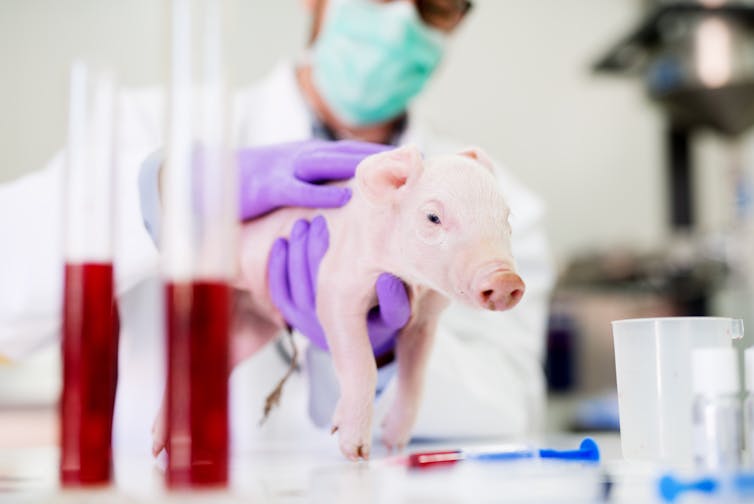
Neuralink, the biotechnology company co-founded by Elon Musk, has been accused of animal cruelty and is under federal investigation in the United States for potential animal welfare violations.
The company has tested its brain-implant technology in animals including monkeys, sheep and pigs. Whistleblowers allege it has killed about 1,500 animals since 2018.
They claim testing was rushed, which caused significant animal suffering and required botched experiments to be repeated – harming more animals than necessary.
This scandal highlights an old but important question: when is it acceptable to harm non-human animals for human ends?
Moral Confusion
The condemnation of Neuralink suggests many people view animal suffering as a serious moral problem. We find similar attitudes when people are outraged by pet owners neglecting or abusing their pets.
But our responses to animal suffering are complicated. Surveys show many people think at least some forms of animal research are ethically acceptable, such as medical research where alternatives aren’t available. Most people also think it is not morally evil to buy a hamburger, animal welfare concerns aside.
Our attitudes towards animals are confusing – and arguably self-serving. We need to think more carefully about how animals ought to be treated.
Do Animals Matter?
In the 17th century, philosopher René Descartes famously described animals as mere “automata”. He believed they lack a soul and a mind, and are therefore incapable of suffering.
But progress in fields such as ethology and the cognitive sciences has improved our understanding of animal behaviour, and we have come to appreciate animals have rich mental lives. There is now scientific consensus that mammals, birds and many others are capable of feeling pain and pleasure.
One might argue that, even if animals can suffer, ethics should only concern how we treat fellow humans since animals are not “one of us”. But this view is unsatisfying.
If somebody were to say it doesn’t matter how we treat people with a different skin colour, because they are not “one of us”, we would (rightly) call them racist. Those who claim the same about animals can be accused of making a similar mistake.
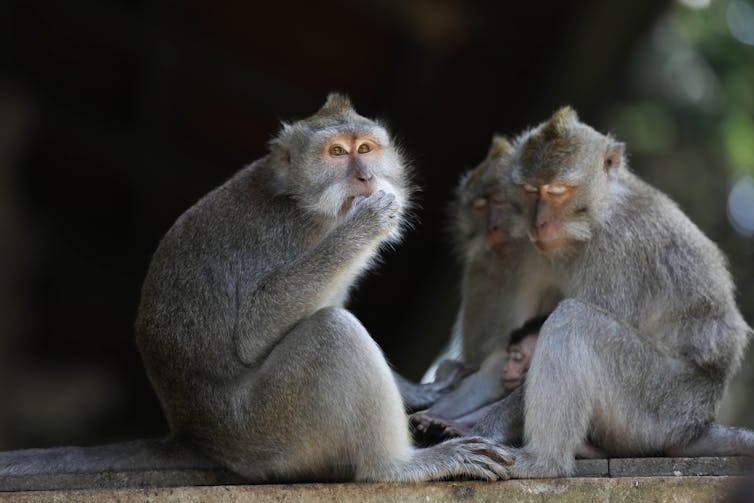
Our treatment of animals has come under increasing philosophical scrutiny since the time of Descartes. Some of the most powerful challenges have come from utilitarian philosophers such as Jeremy Bentham (1748-1832) and Peter Singer, whose 1975 book Animal Liberation was a rallying point for critics of livestock farming and animal research.
But the case for animal welfare isn’t just utilitarian. Thinkers from diverse philosophical traditions share this position.
Philosophical Views On Animal Welfare
Philosophers usually think about animal suffering in accordance with one of three moral theories: utilitarianism, deontology and virtue ethics.
Utilitarians believe we should do what best promotes the overall wellbeing of everybody affected by a choice. They typically hold that all suffering matters equally, regardless of who experiences it, or even what species they belong to.
In 1789, Bentham argued that when it comes to animal welfare:
[…] the question is not, can they reason? Nor, can they talk? But can they suffer?
Deontologists emphasise duties and rights over welfare. They maintain we are not morally permitted to violate rights, even when doing so would promote overall wellbeing.
The great deontologist philosopher Immanuel Kant held that humans have rights because of our rationality (which more or less refers to our abilities to reason and make moral decisions). Kant believed animals aren’t rational and therefore don’t have rights (although he claimed we should still refrain from mistreating them since, according to him, that might make us more likely to mistreat humans).
Kant’s rejection of animal rights faces two challenges. First, some argue certain intelligent species, such as elephants and chimpanzees, are also rational and hence deserve rights.
Second, many contemporary deontologists argue we should set a less demanding threshold for moral rights. Rather than requiring rationality, they suggest it might be enough for an animal to have desires and interests.
Virtue ethicists take yet another approach. They think morality is a matter of developing and practising good character traits, such as honesty and compassion, while avoiding traits like dishonesty and cowardice. Virtue ethicists who deal with animal ethics have argued animal experimentation displays and reinforces vices like callousness and cruelty, particularly when research is unlikely to achieve morally important goals.
Neuralink Revisited
In Australia and the United States, animal research is governed largely by the “three Rs”: directives to replace animal research with other strategies when feasible, reduce the number of animals used as much as possible, and refine experimental techniques to minimise animal pain.
If the reports about Neuralink are correct, the company failed to adhere to these. But what if Neuralink had conducted experiments in line with the three Rs – would this have resolved all ethical concerns?
Probably not. The three Rs are silent on one crucial question: whether the scientific gains from a particular study are great enough to justify the harms that research may inflict.
So long as an experiment is scientifically sound, one could, in principle, follow the three Rs to the letter while still inflicting severe suffering on a great many animals, and with little prospect of benefiting humans. If animals have moral worth, as the utilitarian, deontological and virtue ethical views state, then at least some scientifically sound animal research should not be conducted.
Neuralink has admirable goals, which include curing paralysis, blindness and depression.
But utilitarians might question whether the expected benefits are great enough (or likely enough) to outweigh the significant harms to animals. Deontologists might question whether any of the species used have moral rights against being experimented on, particularly intelligent ones such as monkeys and pigs. And virtue ethicists might worry the testing performed involves vices such as callousness.
Where Are We Headed?
Animal research is widely practised in Australia, with more than 6 million animals reportedly used per year. Some (but not all) of this research involves significant pain and suffering. Mice are the most common animal used, though species such as dogs, cats and non-human primates are also used.
The vast number of lives at stake mean it is imperative to get the ethics right.
This means developing a more comprehensive set of principles for animal research than the three Rs: one that will help us more effectively balance scientific benefit against harms to research animals. At least among philosophers, this work is already under way.
It might also involve revisiting the question of when (if ever) certain species should be used in research. Australia imposes special restrictions on the use of non-human primates. Other jurisdictions have banned or considered banning ape research. What other intelligent species ought to receive additional protections?
We need to look beyond the three Rs for a full assessment of the ethics of animal research – both for Neuralink and beyond.![]()
Julian Koplin, Lecturer in Bioethics, Monash University & Honorary fellow, Melbourne Law School, Monash University
This article is republished from The Conversation under a Creative Commons license. Read the original article.
Newly Discovered Anatomy Shields And Monitors Brain
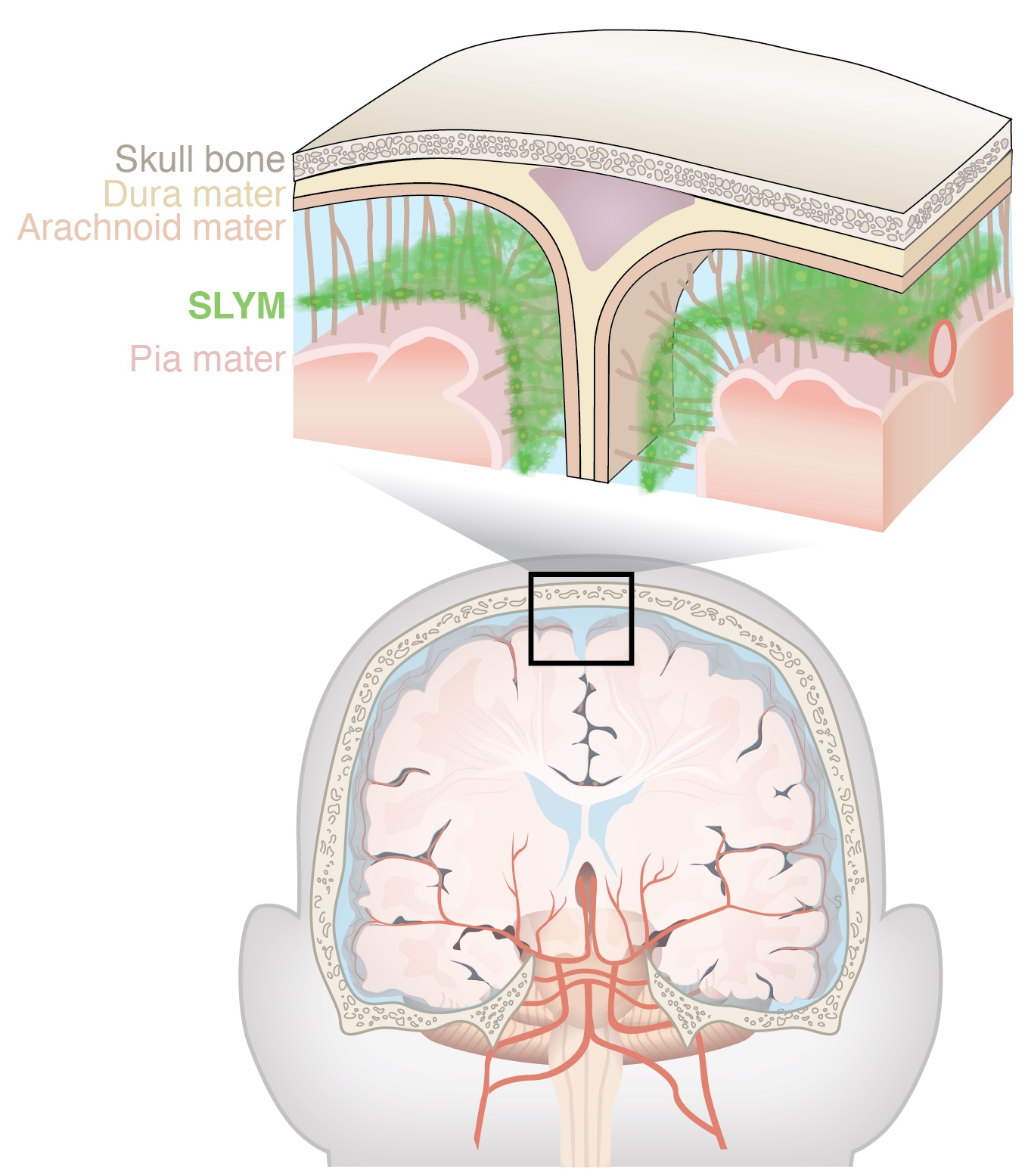
Disclaimer: These articles are not intended to provide medical advice, diagnosis or treatment. Views expressed here do not necessarily reflect those of Pittwater Online News or its staff.